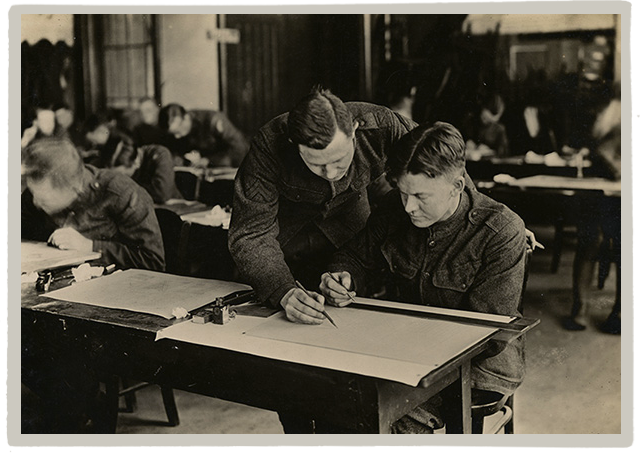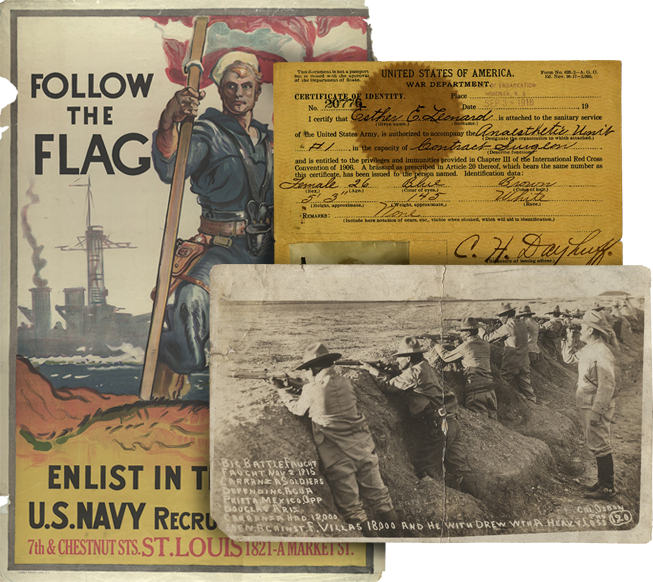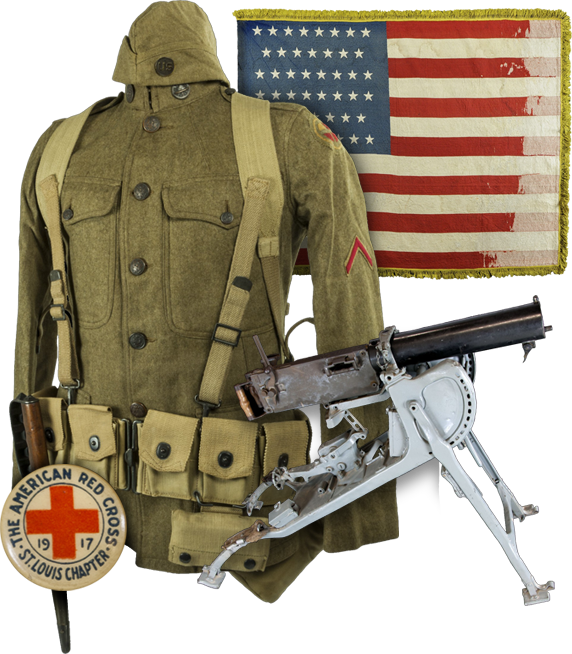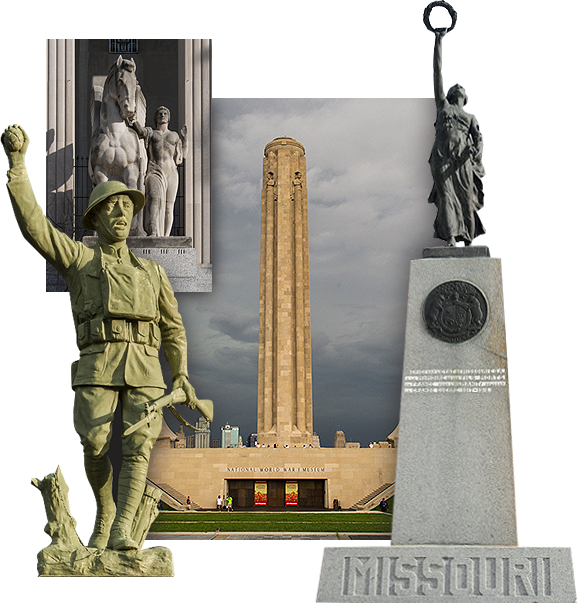Joseph Broz U.S. Air Force WWI Scrapbook - December 25, 1979
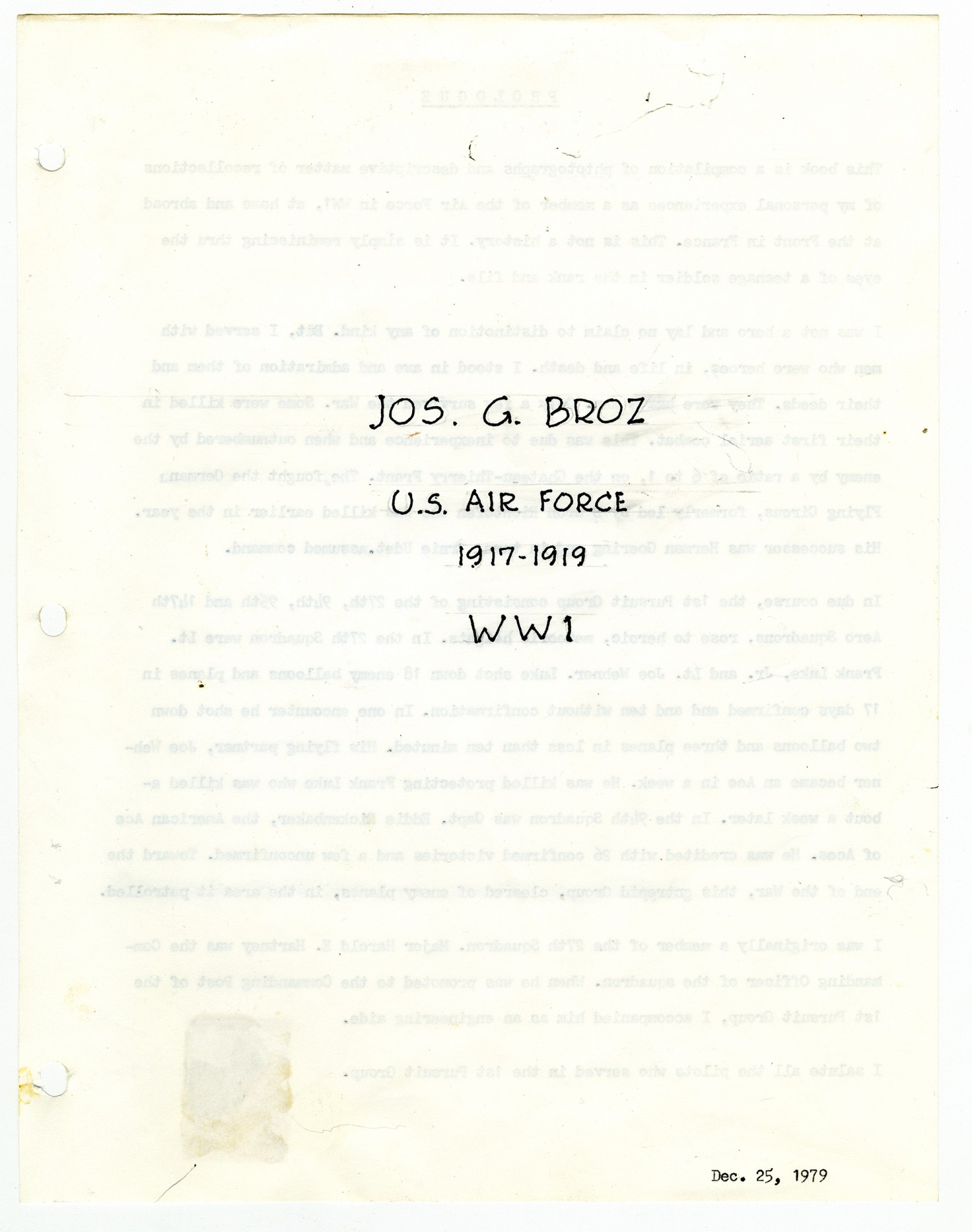
Transcript
Jos. G. Broz U.S. Air Force 1917
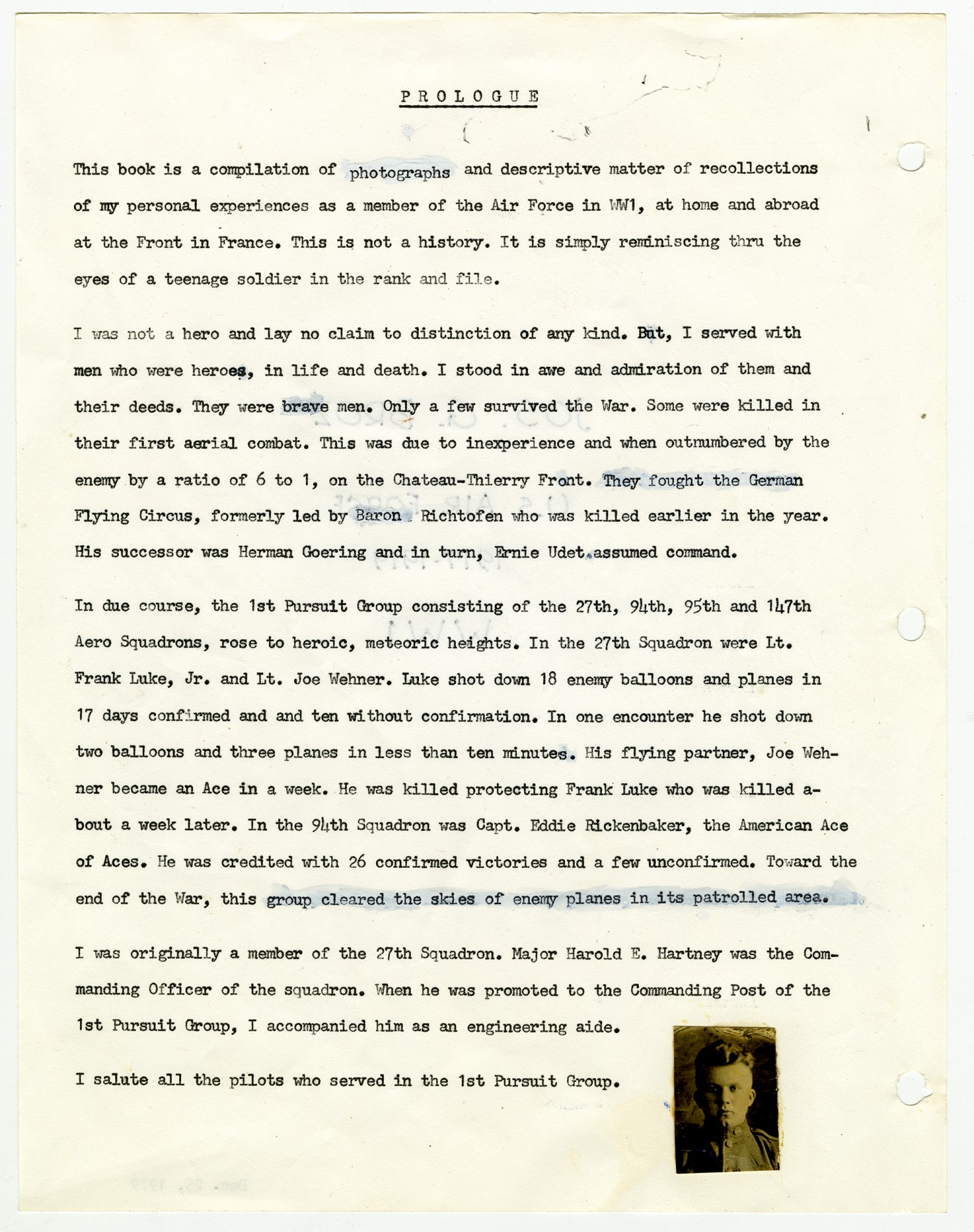
Transcript
Prologue This book is a compilation of photographs and descriptive matter of recollections of my personal experiences as a member of the Air Force in WWI, at home and abroad at the Front in France. This is not a history. It is simply reminiscing thru the eyes of a teenage soldier in the rank and file. I was not a hero and lay no claim to distinction of any kind. But, I served with men who were heroes, in life and death. I stood in awe and admiration of them and their deeds. They were brave men. Only a few survived the War. Some were killed in their first aerial combat. This was due to inexperience and when outnumbered by the enemy by a ratio of 6 to 1, on the Chateau-Thierry Front. They fought the German Flying Circus, formerly led by Baron Richtofen who was killed earlier in the year. His successor was Herman Goering and in turn, Ernie Udet assumed command. In due course, the 1st Pursuit Group consisting of the 27th, 94th, 95th and 147th Aero Squadrons, rose to heroic, meteoric heights. In the 27th Squadron were Lt. Frank Luke, Jr. and Lt. Joe Wehner. Luke shot down 18 enemy balloons and planes in 17 days confirmed and and ten without confirmation. In one encounter he shot down two balloons and three planes in less than ten minutes. His flying partner, Joe Wehner became an Ace in a week. He was killed protecting Frank Luke who was killed about a week later. In the 94th Squadron was Capt. Eddie Rickenbaker, the American Ace of Aces. He was credited with 26 confirmed victories and a few unconfirmed. Toward the end of the War, this group cleared the skies of enemy planes in its patrolled area. I was originally a member of the 27th Squadron. Major Harold E. Hartney was the Commanding Officer of the squadron. When he was promoted to the Commanding Post of the 1st Pursuit Group, I accompanied him as an engineering aide. I salute all the pilots who served in the 1st Pursuit Group.
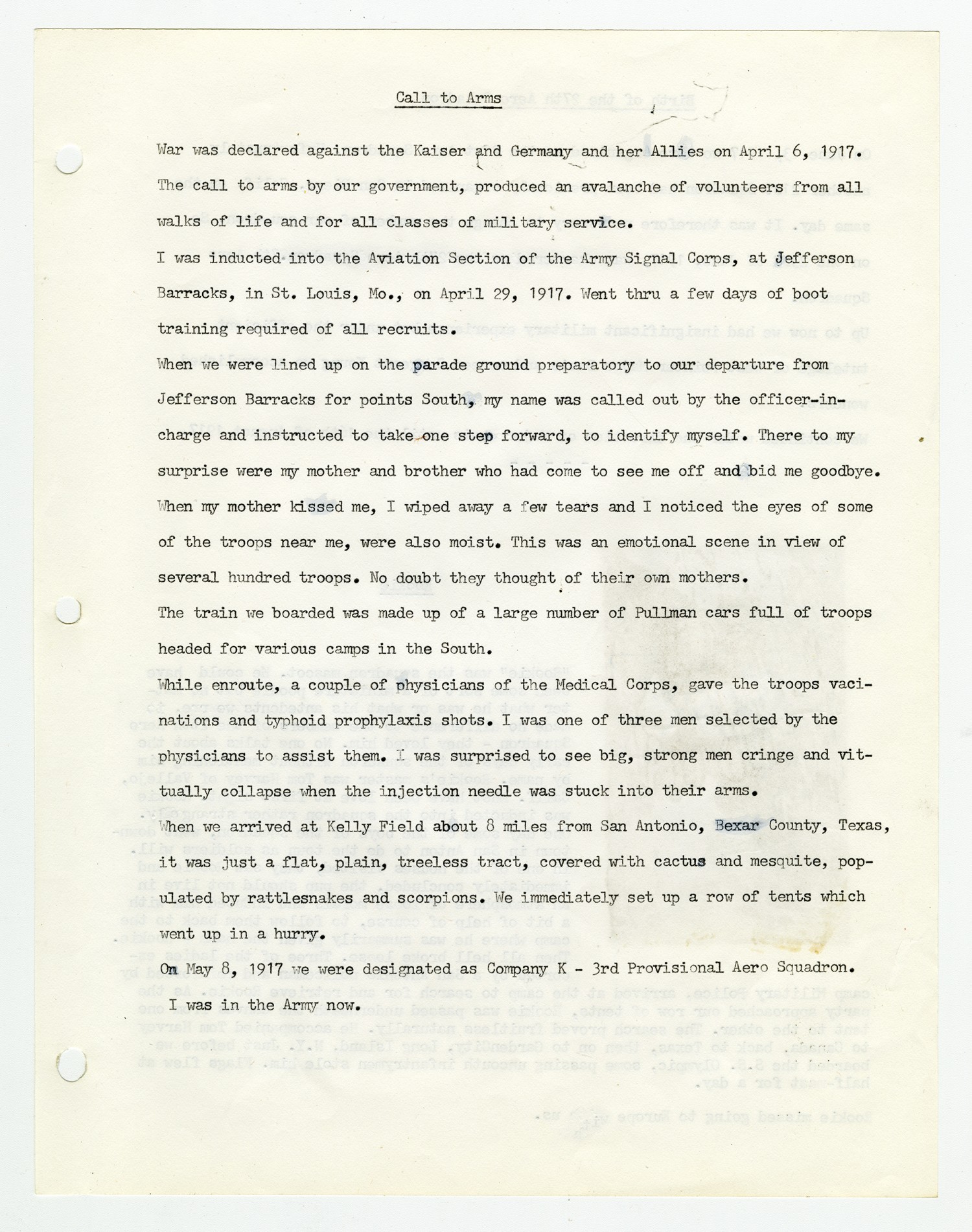
Transcript
Call to Arms War was declared against the Kaiser and Germany and her Allies on April 6, 1917. The call to arms by our government, produced an avalanche of volunteers from all walks of life and for all classes of military service. I was inducted into the Aviation Section of the Army Signal Corps, at Jefferson Barracks, in St. Louis, [Missouri], on April 29, 1917. Went thru a few days of boot training required of all recruits. When we were lined up on the parade ground preparatory to our departure from Jefferson Barracks for points South, my name was called out by the officer-in-charge and instructed to take one step forward, to identify myself. There to my surprise were my mother and brother who had come to see me off and bid me goodbye. When my mother kissed me, I wiped away a few tears and I noticed the eyes of some of the troops near me, were also moist. This was an emotional scene in view of several hundred troops. No doubt they thought of their own mothers. The train we boarded was made up of a large number of Pullman cars full of troops headed for various camps in the South. While enroute, a couple of physicians of the Medical Corps, gave the troops vacinations and typhoid prophylaxis shots. I was one of three men selected by the physicians to assist them. I was surprised to see big, strong men cringe and vittually collapse when the injection needle was stuck into their arms. When we arrived at Kelly Field about 8 miles from San Antonio, Bexar County, Texas, it was just a flat, plain, treeless tract, covered with cactus and mesquite, populated by rattlesnakes and scorpions. We immediately set up a row of tents which went up in a hurry. On May 8, 1917 we were designated as Company K
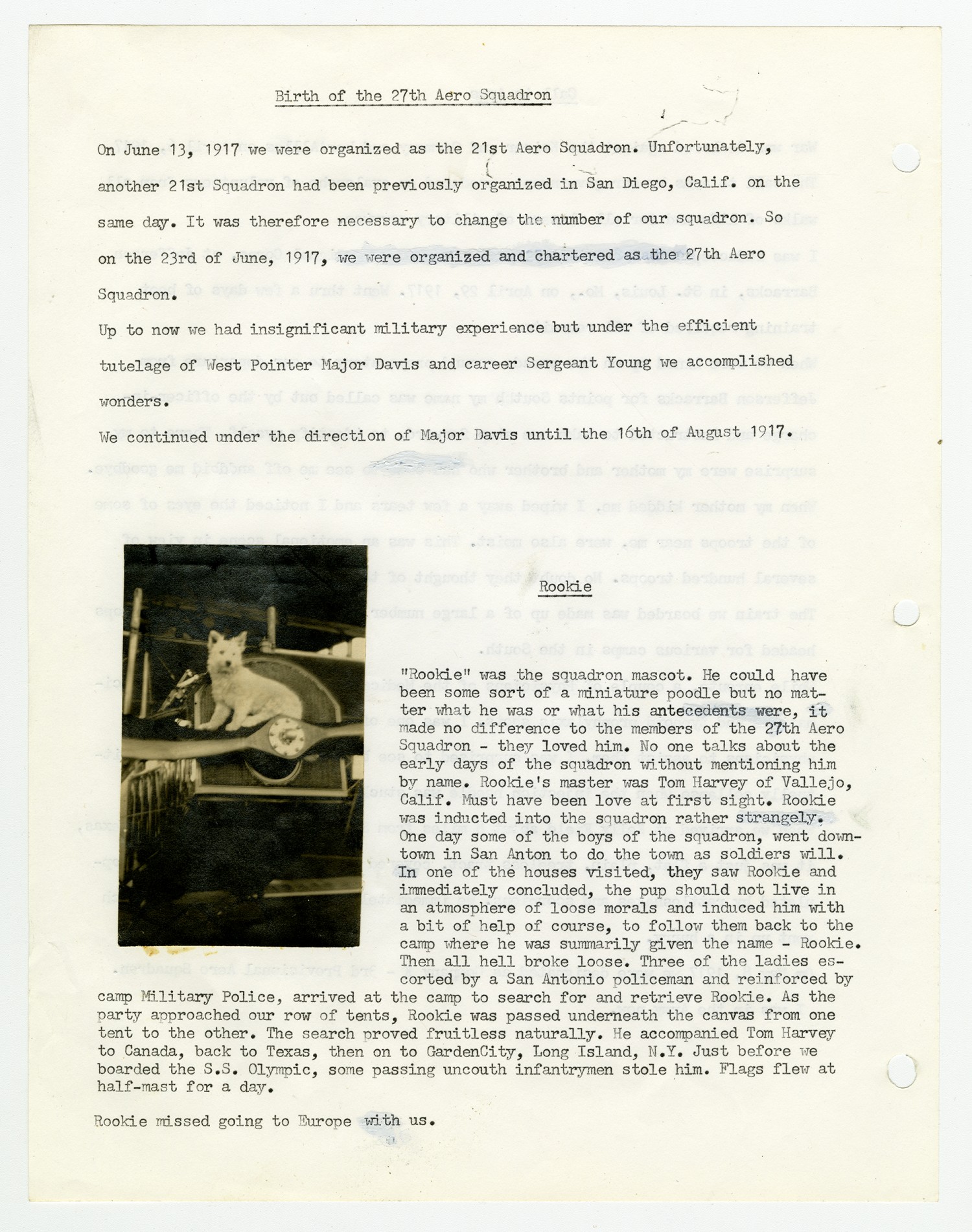
Transcript
Birth of the 27th Aero Squadron On June 13, 1917 we were organized as the 21st Aero Squadron. Unfortunately, another 21st Squadron had been previously organized in San Diego, [California] on the same day. It was therefore necessary to change the number of our squadron. So on the 23rd of June, 1917, we were organized and chartered as the 27th Aero Squadron. Up to now we had insignificant military experience but under the efficient tutelage of West Pointer Major Davis and career Sergeant Young we accomplished wonders. We continued under the direction of Major Davis until the 16th of August 1917. Rookie

Transcript
[Top left photograph]This is what happened to us and our camp on the 4th of July, 1917. We needed and wanted rain but not that much. [Top right photograph] Carl Quandt of Kenosha, [Wisconsin]. The expression on his face indicates he wishes he was somewhere else. [Middle left photograph] The squadron street on the 5th of July, 1917. There was no drainage system. The water slowly found its way to a ditch dug to take the runoff. It was a slow process. Tents and all their contents had to be dried out. Everything was an unholy mess. Rattle snakes and scorpions took over. Army routine was disrupted. The cook tent had to be moved to dry high ground. Before we left Kelly Field, conditions improved because all improvements were the work of our hands and backs. [Middle right photograph] Joe Broz himself after two months of life in Texas. [Bottom photographs] Bill Robertson of St. Louis, [Missouri]. At the time Bill had a tent on our street. He later became President of Robertson-Curtiss Aircraft Corp.
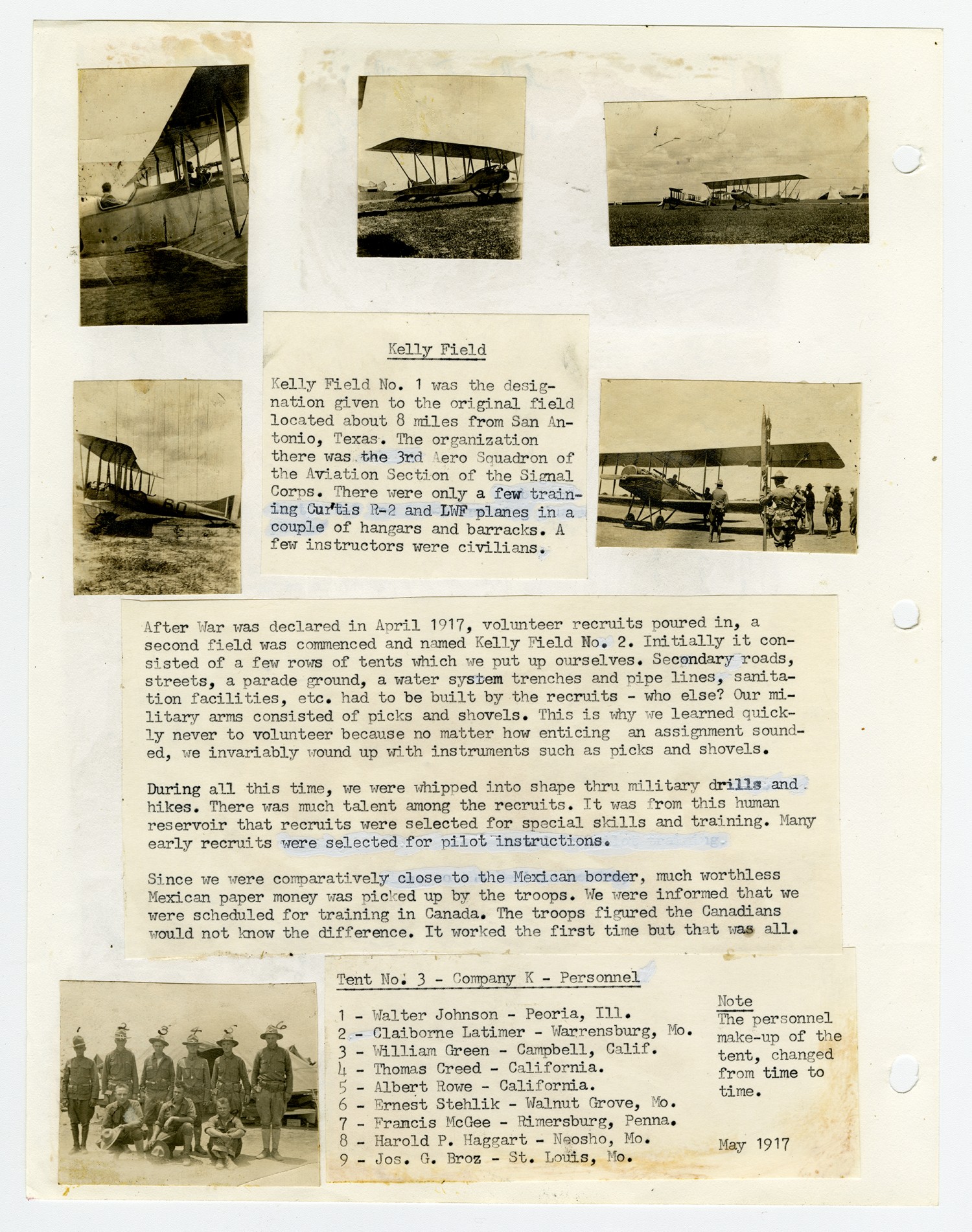
Transcript
[Five photographs] Kelly Field Kelly Field No. 1 was the designation given to the original field located about 8 miles from San Antonio, Texas. The organization there was the 3rd Aero Squadron of the Aviation Section of the Signal Corps. There were only a few training Curtis R-2 and LWF planes in a couple of hangars and barracks. A few instructors were civilians. After War was declared in April 1917, volunteer recruits poured in, a second field was commenced and named Kelly Field No. 2. Initially it consisted of a few rows of tents which we put up ourselves. Secondary roads, streets, a parade ground, a water system trenches and pipe lines, sanitation facilities, etc. had to be built by the recruits
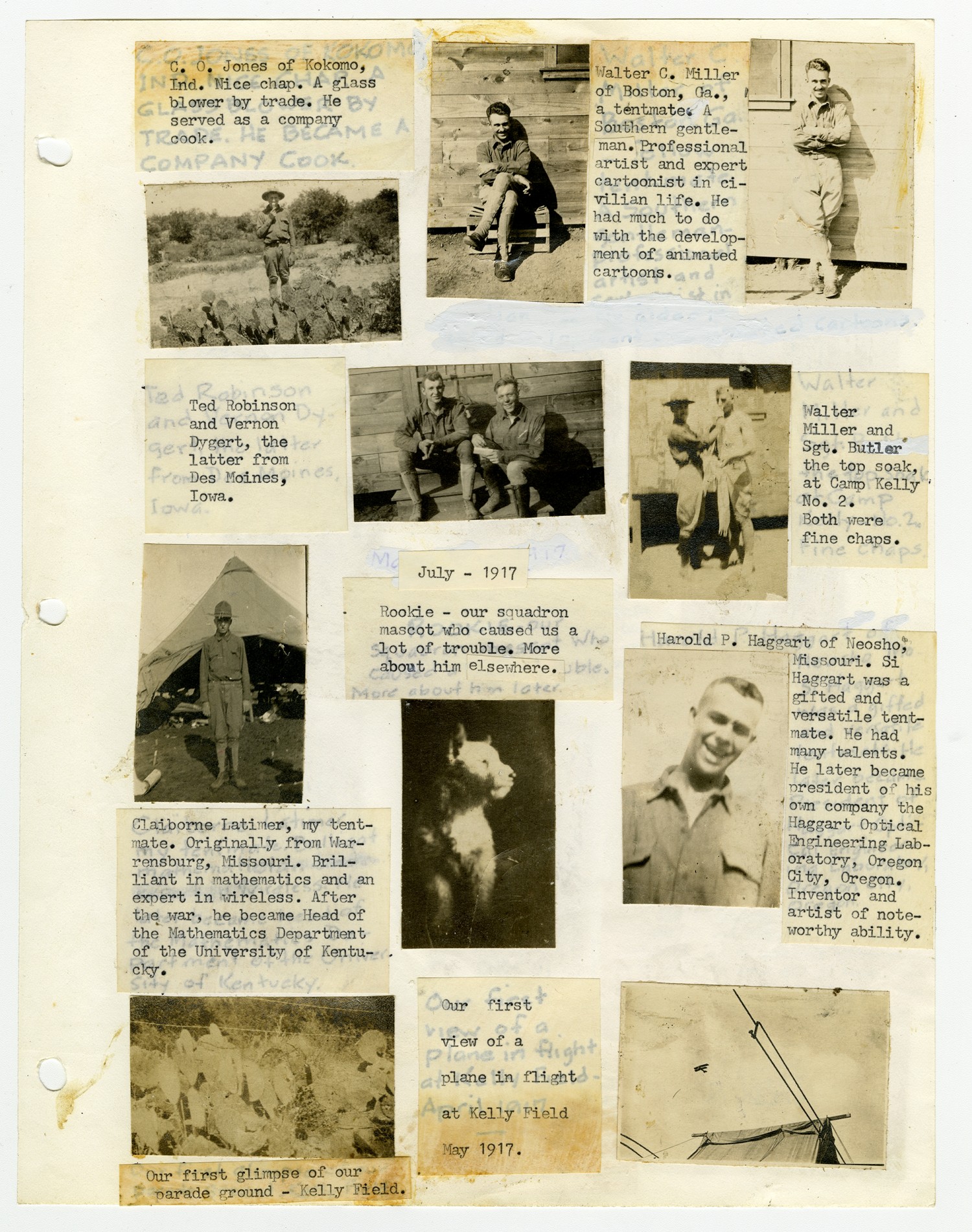
Transcript
[1st row left photograph] C.O. Jones of Kokomo, [Indiana]. Nice chap. A glass blower by trade. He served as a company cook. [1st row right photographs] Walter C. Miller of Boston, [Georgia], a tentmate. A Southern gentleman. Professional artist and expert cartoonist in civilian life. He had much to do with the development of animated cartoons. [2nd row left photograph] Ted Robinson and Vernon Dygert, the latter from Des Moines, Iowa. [2nd row right photograph] Walter Miller and Sgt. Butler the top soak, at Camp Kelly No. 2. Both were fine chaps. [3rd row left photograph] Claiborne Latimer, my tentmate. Originally from Warrensburg, Missouri. Brilliant in mathematics and an expert in wireless. After the war, he became Head of the Mathematics Department of the University of Kentucky. [3rd row middle photograph] July
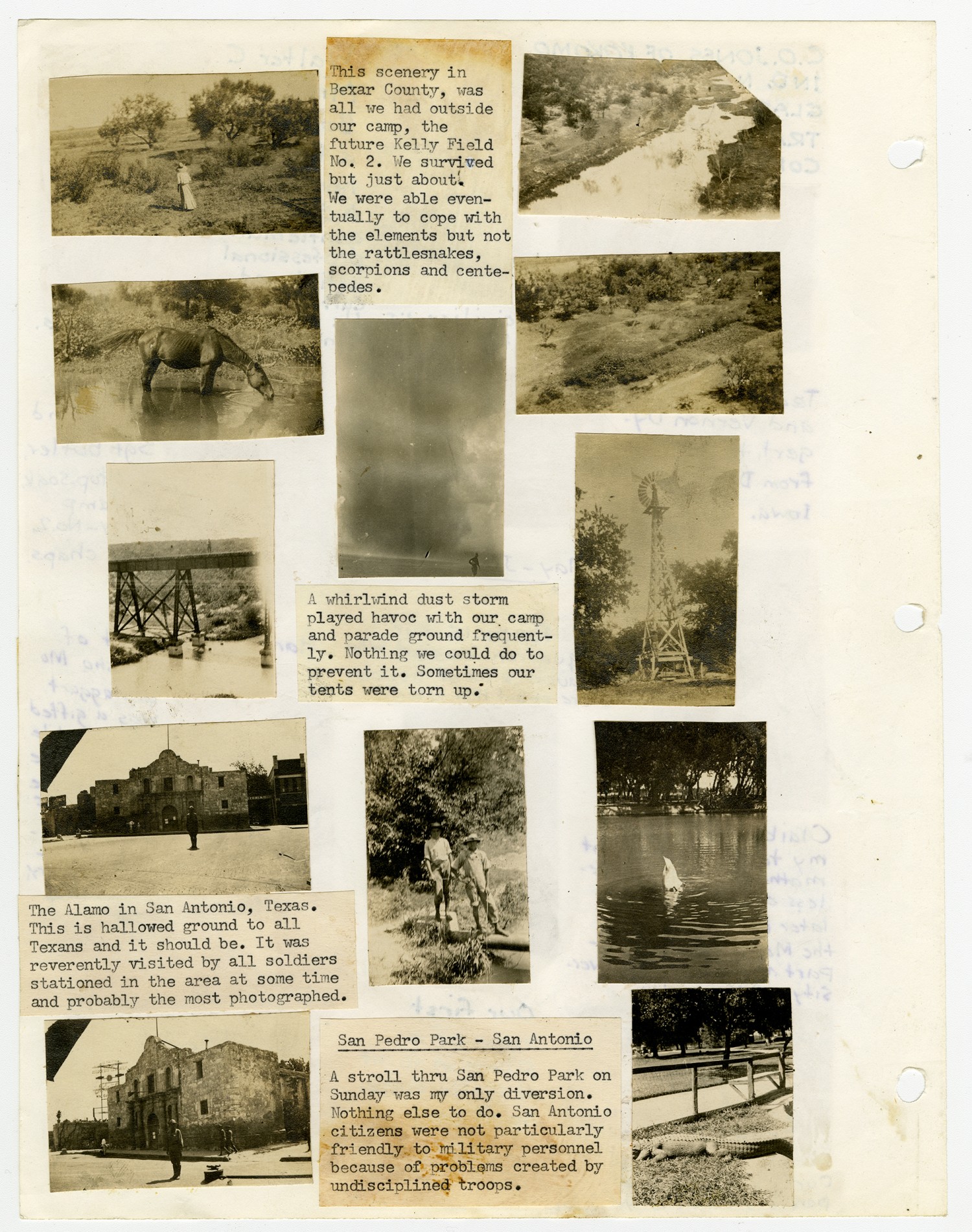
Transcript
[1st and 2nd row photographs] This scenery in Bexar County, was all we had outside our camp, the future Kelly Field No. 2. We survived but just about. We were able eventually to cope with the elements but not the rattlesnakes, scorpions and centepedes. [3rd row photographs] A whirlwind dust storm played havoc with our camp and parade ground frequently. Nothing we could do to prevent it. Sometimes our tents were torn up. [4th row left photograph]The Alamo in San Antonio, Texas. This is hallowed ground to all Texans and it should be. It was reverently visited by all soldiers stationed in the area at some time and probably the most photographed. [5th row photographs] San Pedro Park
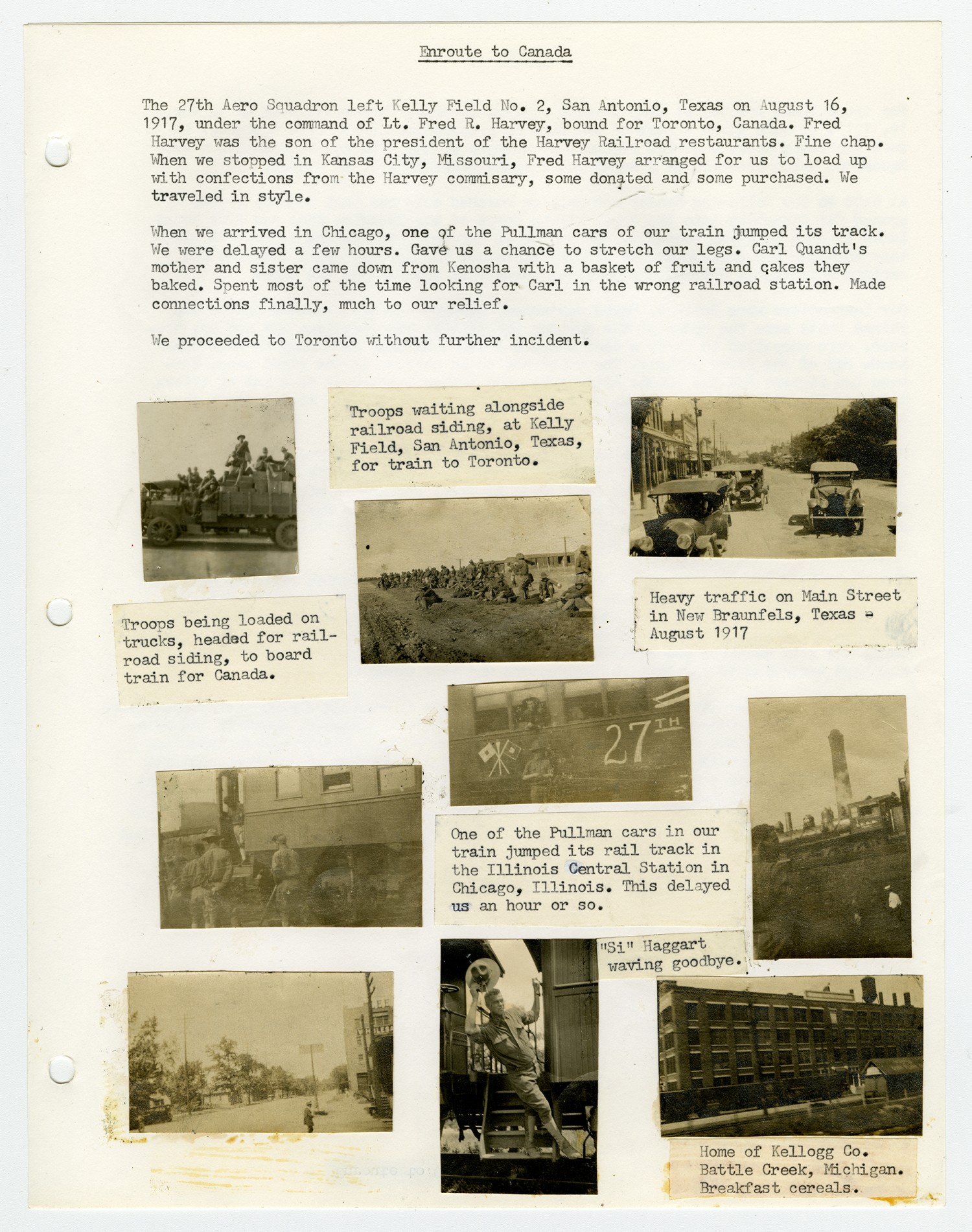
Transcript
Enroute to Canada The 27th Aero Squadron left Kelly Field No. 2, San Antonio, Texas on August 16, 1917, under the command of Lt. Fred R. Harvey, bound for Toronto, Canada. Fred Harvey was the son of the president of the Harvey Railroad restaurants. Fine chap. When we stopped in Kansas City, Missouri, Fred Harvey arranged for us to load up with confections from the Harvey commisary, some donated and some purchased. We traveled in style. When we arrived in Chicago, one of the Pullman cars of our train jumped its track. We were delayed a few hours. Gave us a chance to stretch our legs. Carl Quandt

Transcript
CANADA Our troop train arrived at Camp Leaside siding, Toronto, Canada, at 2:00 AM on [August] 19, 1917. We were given a rest of two days in preparation for British training. We were cautioned about a strict regimen, by members of the 17th and 22nd American Aero Squadrons which preceded us 4 weeks respectively, to Canada. At 6:00 AM the following Monday morning, we marched onto the Camp Leaside parade ground for induction into the Royal Flying Corps of the Canadian Army and five hours later we were Canadian recruits. Thereafter we marched and drilled to British military commands and procedures. We quickly adjusted. The British drill routines had certain advantages. British and Canadian formations are one and the same. Our instructors were British, Waxed mustaches, swagger sticks, tropical shorts and shined boots were the order of the day for the British and Canadians but not us. However, were compelled to carry a cane swagger stick when away from camp to keep our hands out of our pants pockets. The stick had to be carried in the right hand, between two fingers and the thumb. After a bit the troops learned to do a lot of tricks twirling the stick. I know I did, in fact I was proficient enough to entertain the troops with a few amateurish tricks. Naturally, life was not all beer and skittles. Claiborne Latimer picked up in Texas, an underslung, bowlegged, fierce looking bulldog. Affectionate with the troops but he disliked other dogs. His name was Buck. When we first arrived in camp, Buck took immediate dislike to a big St. Bernard dog named Bruno, which was the pet of the Commandant
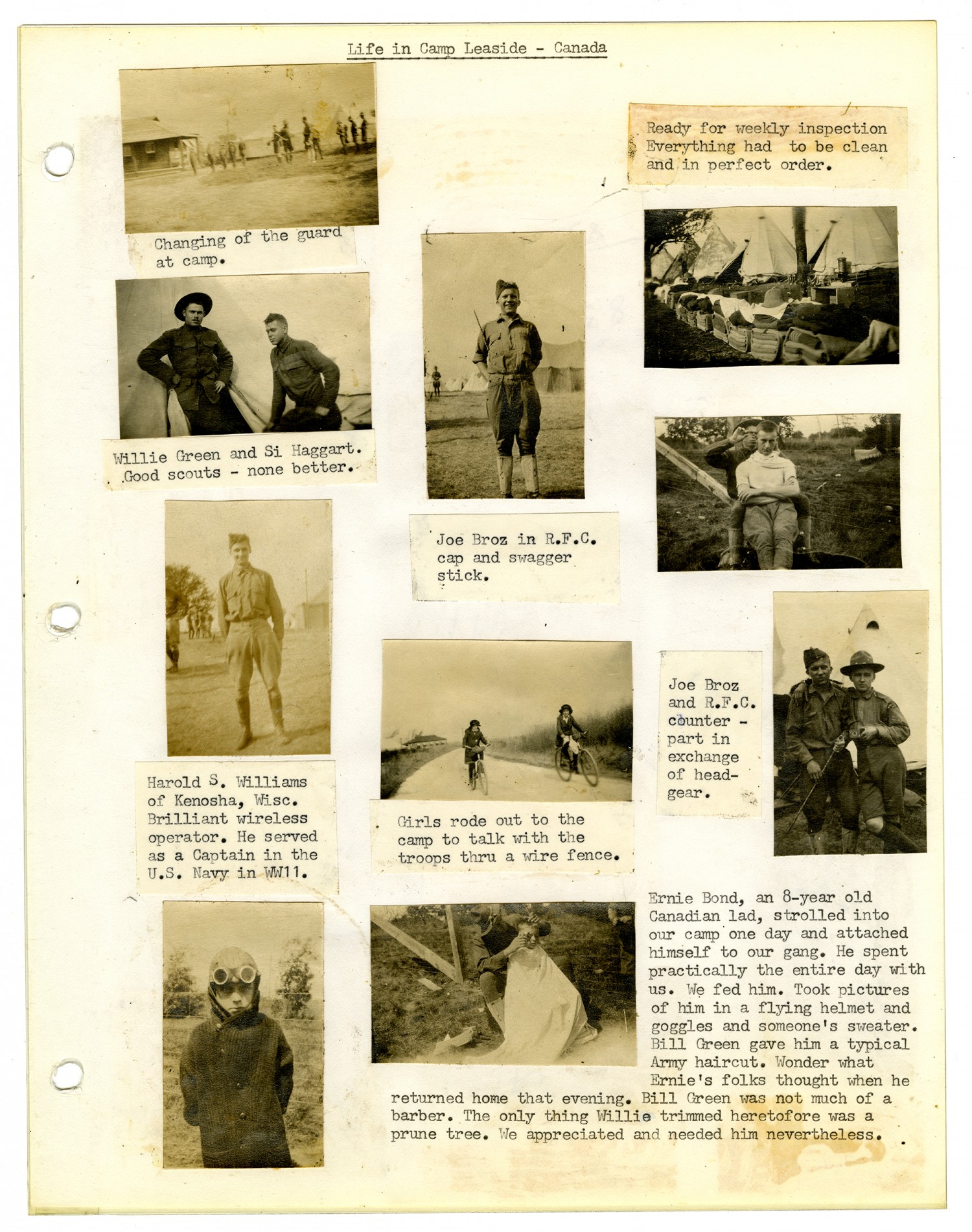
Transcript
Life in Camp Leaside
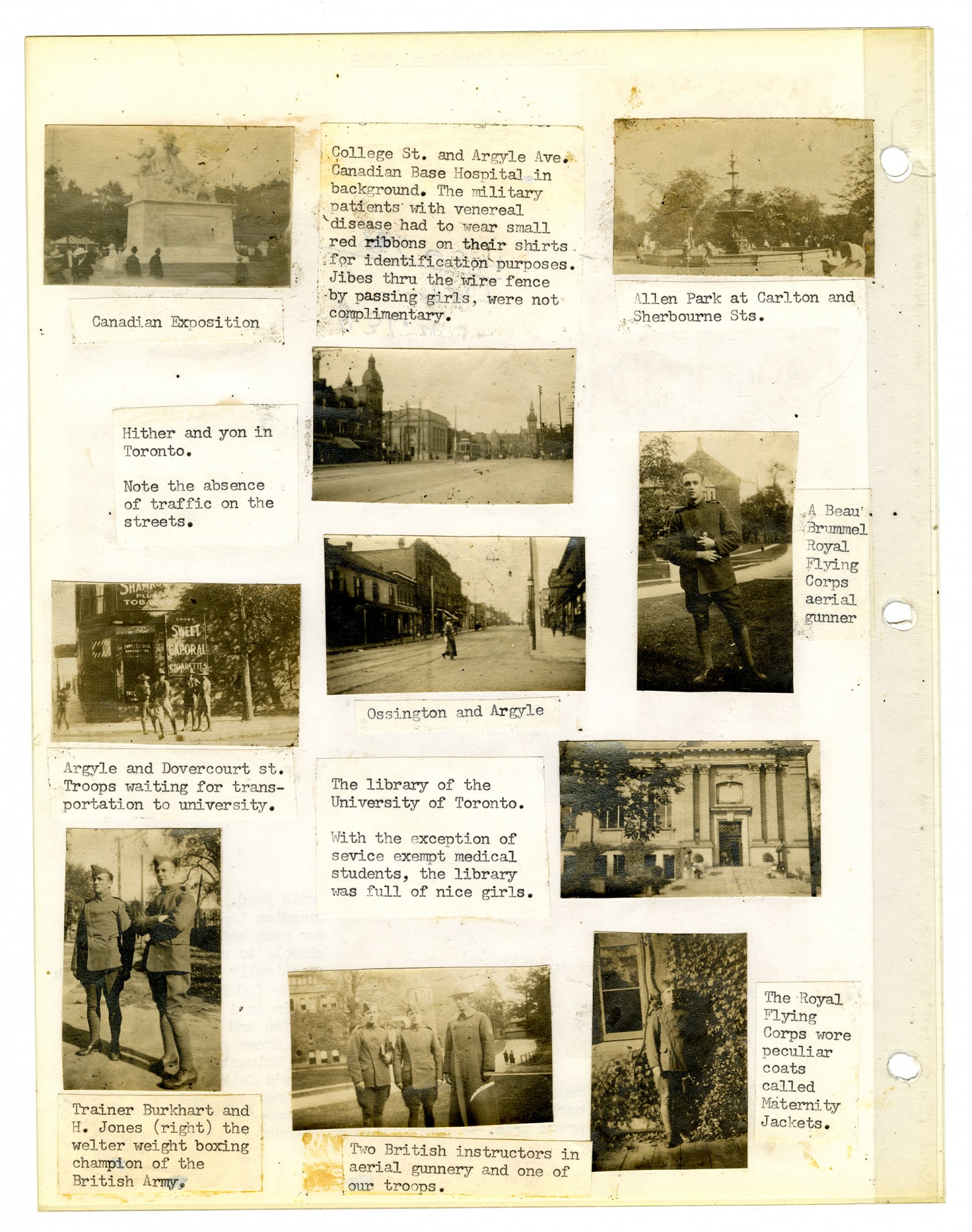
Transcript
[1st row left photograph] Canadian Exposition College St. and Argyle Ave. Canadian Base Hospital in background. The military patients with venereal disease had to wear small red ribbons on their shirts for identification purposes. Jibes thru the wire fence by passing girls, were not complimentary. [1st row right photograph] Allen Park at Carlton and Sherbourne Sts. [2nd row photograph] Hither and yon in Toronto. Note the absence of traffic on the streets. [3rd row left photograph] Argyle and Dovercourt st. Troops waiting for transportation to university. [3rd row middle photograph] Ossington and Argyle [3rd row right photograph] A Beau Brummel Royal Flying Corps aerial gunner [4th row photograph] The library of the University of Toronto. With the exception of service exempt medical students, the library was full of nice girls. [5th row left photograph] Trainer Burkhart and H. Jones (right) the welter weight boxing champion of the British Army. [5th row middle photograph] Two British instructors in aerial gunnery and one of our troops. [5th row right photograph] The Royal Flying Corps wore peculiar coats called Maternity Jackets.
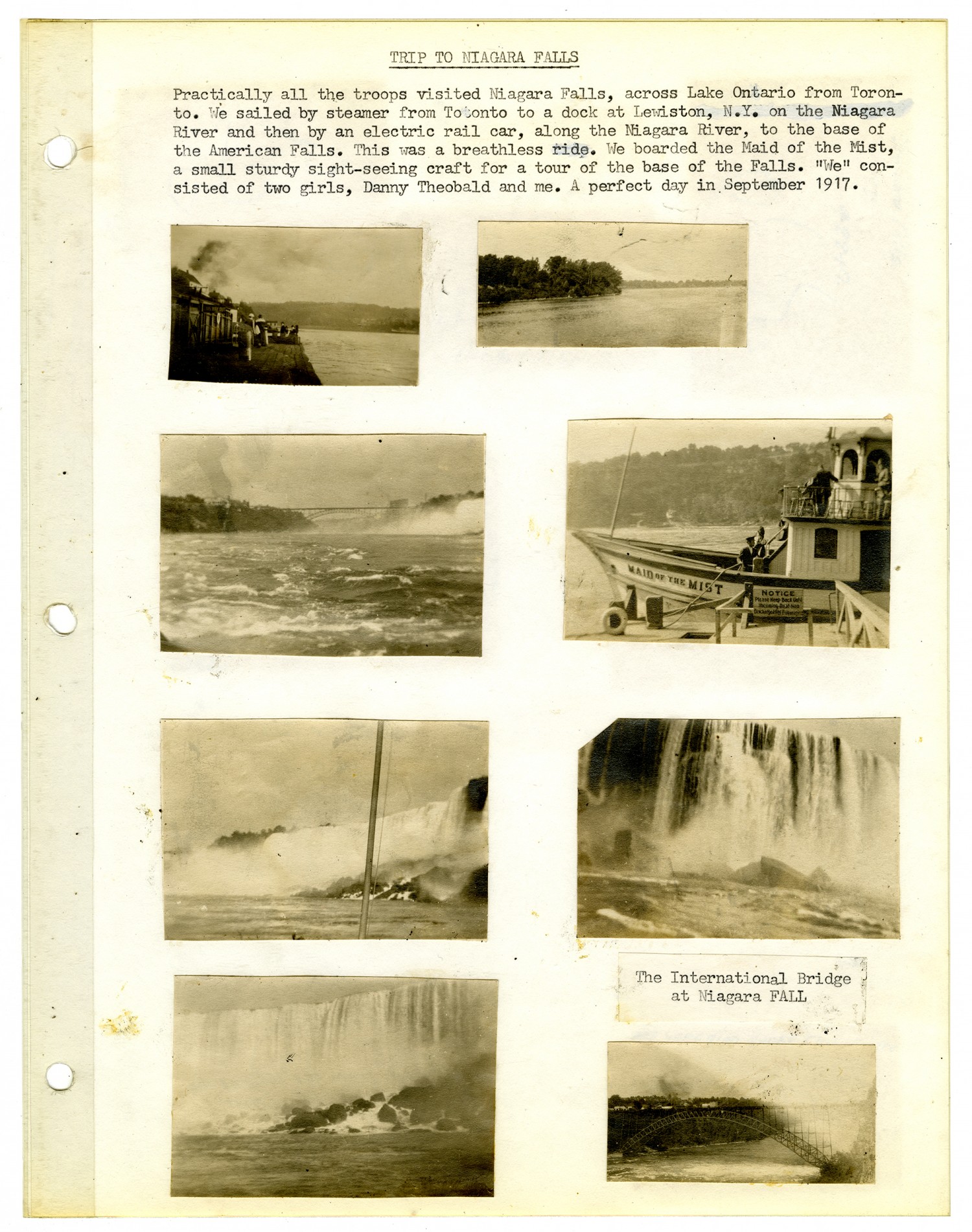
Transcript
TRIP TO NIAGARA FALLS Practically all the troops visited Niagara Falls, across Lake Ontario from Toronto. We sailed by steamer from Toronto to a dock at Lewiston, [New York] on the Niagara River and then by an electric rail car, along the Niagara River, to the base of the American Falls. This was a breathless ride. We boarded the Maid of the Mist, a small sturdy sight-seeing craft for a tour of the base of the Falls.
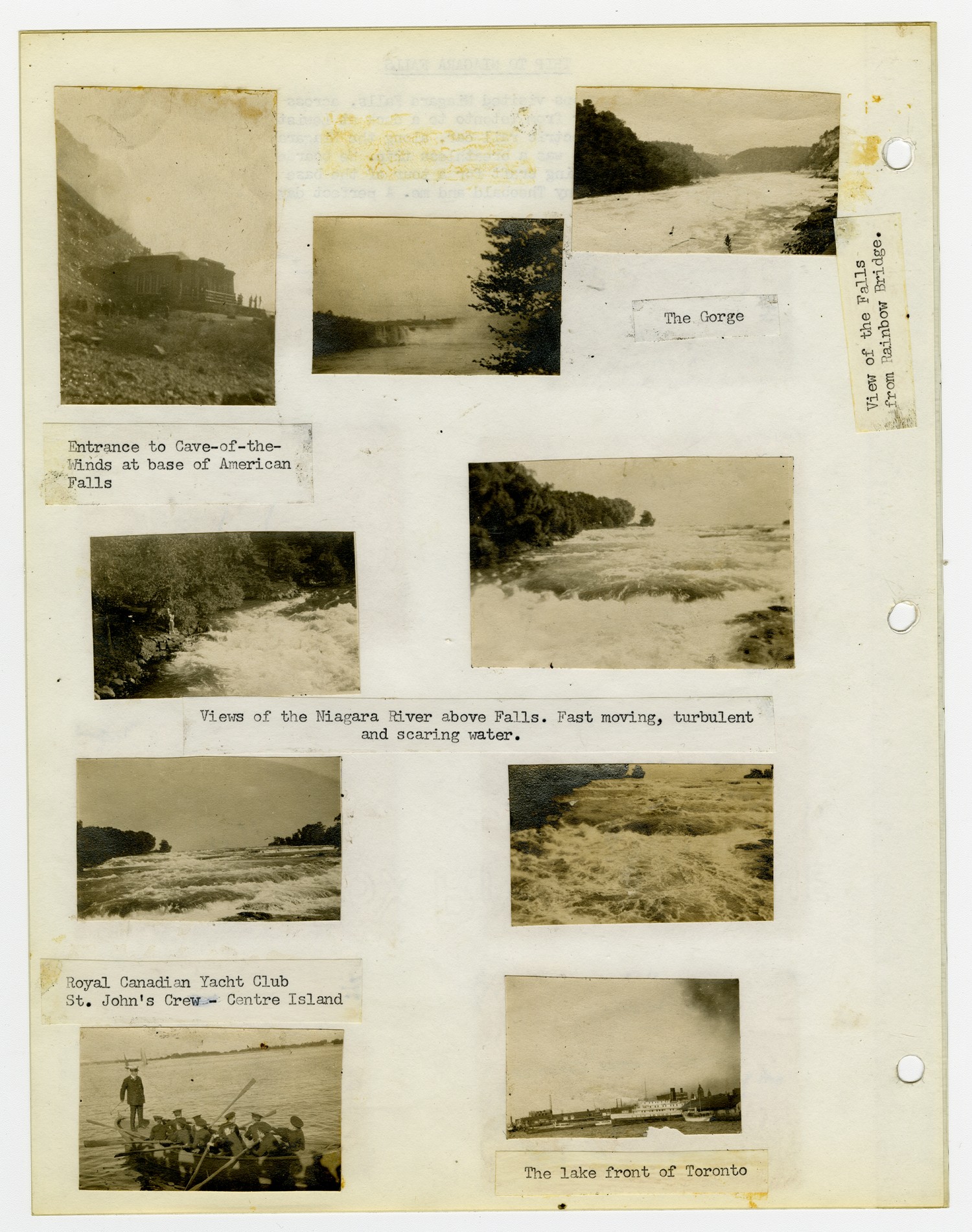
Transcript
[1st row left photograph] Entrance to Cave-of-the-Winds at base of American Falls [1st row left photograph] The Gorge View of the Falls from Rainbow Bridge. [2nd row photographs] Views of the Niagara River above Falls. Fast moving, turbulent and scaring water. [3rd row left photograph] Royal Canadian Yacht Club St. John
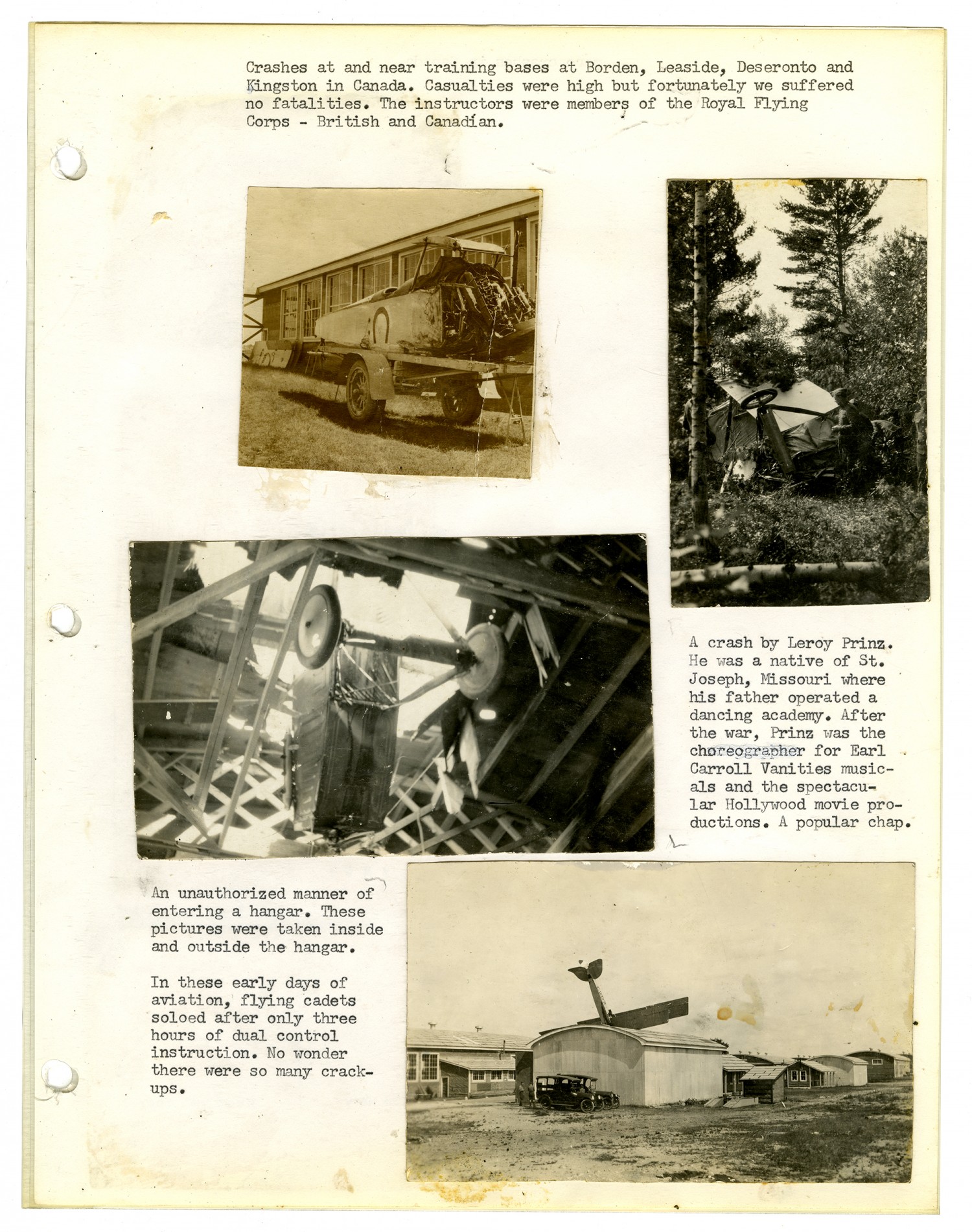
Transcript
Crashes at and near training bases at Borden, Leaside, Deseronto and Kingston in Canada. Casualties were high but fortunately we suffered no fatalities. The instructors were members of the Royal Flying Corps
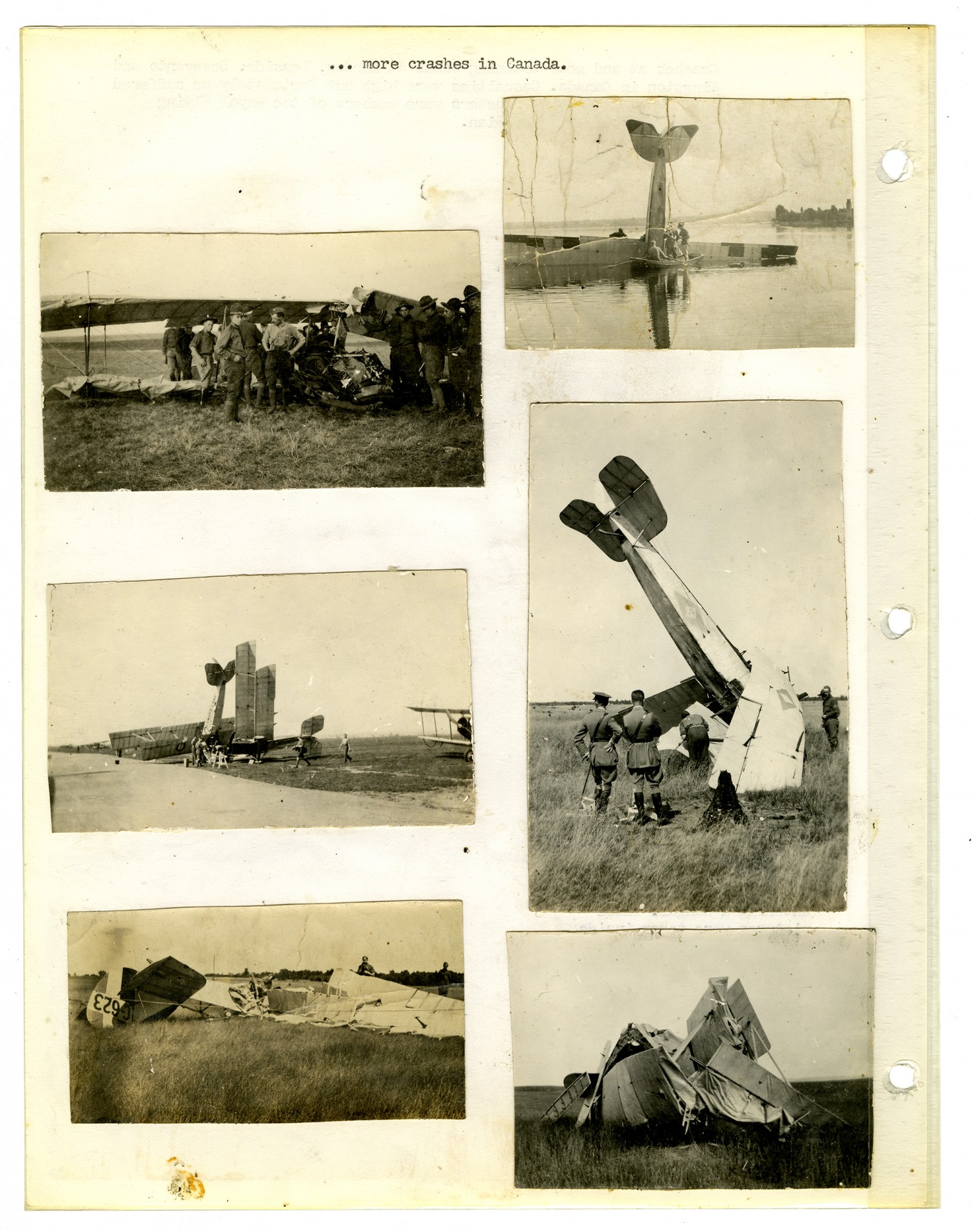
Transcript
... more crashes in Canada.
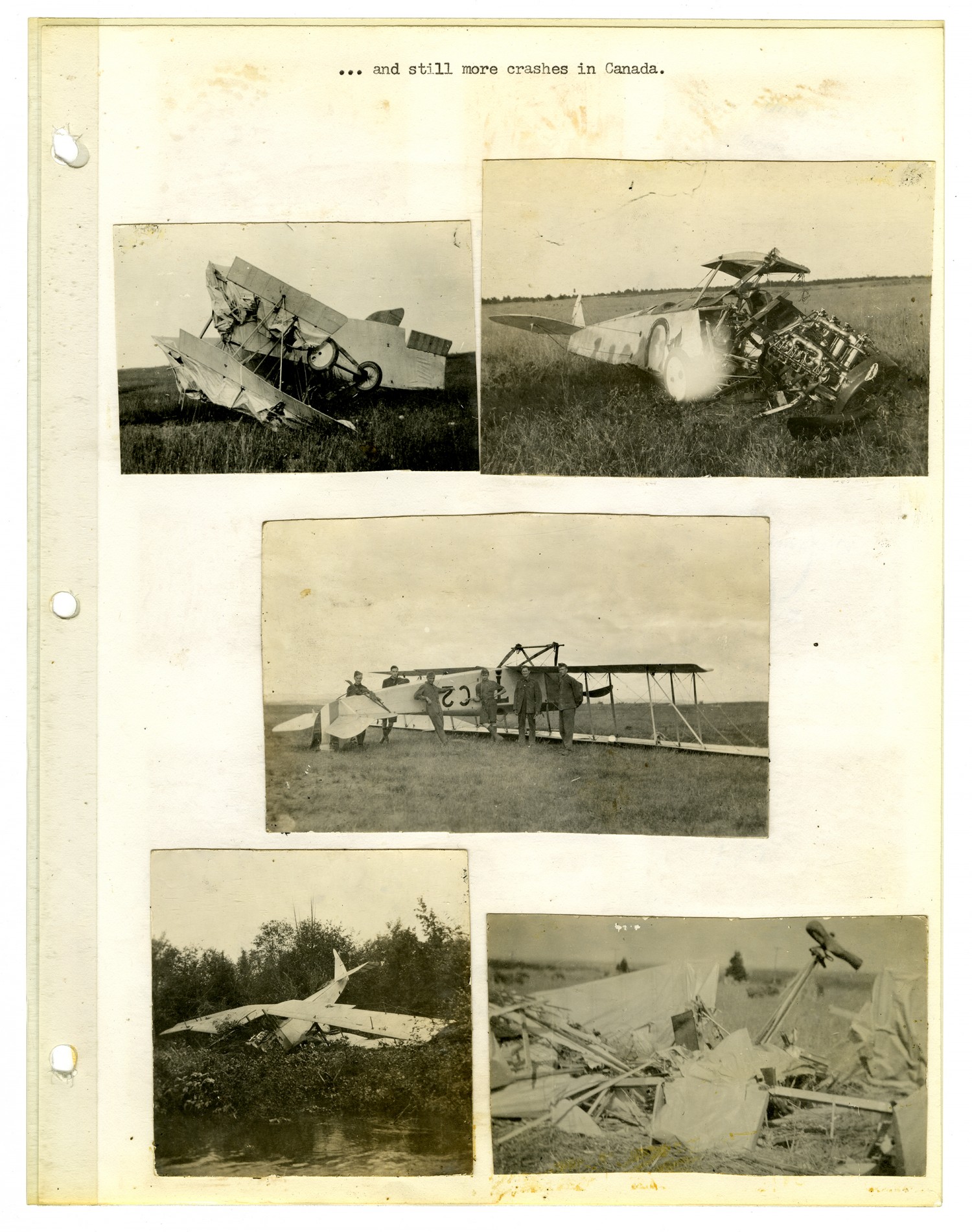
Transcript
... and still more crashes in Canada.
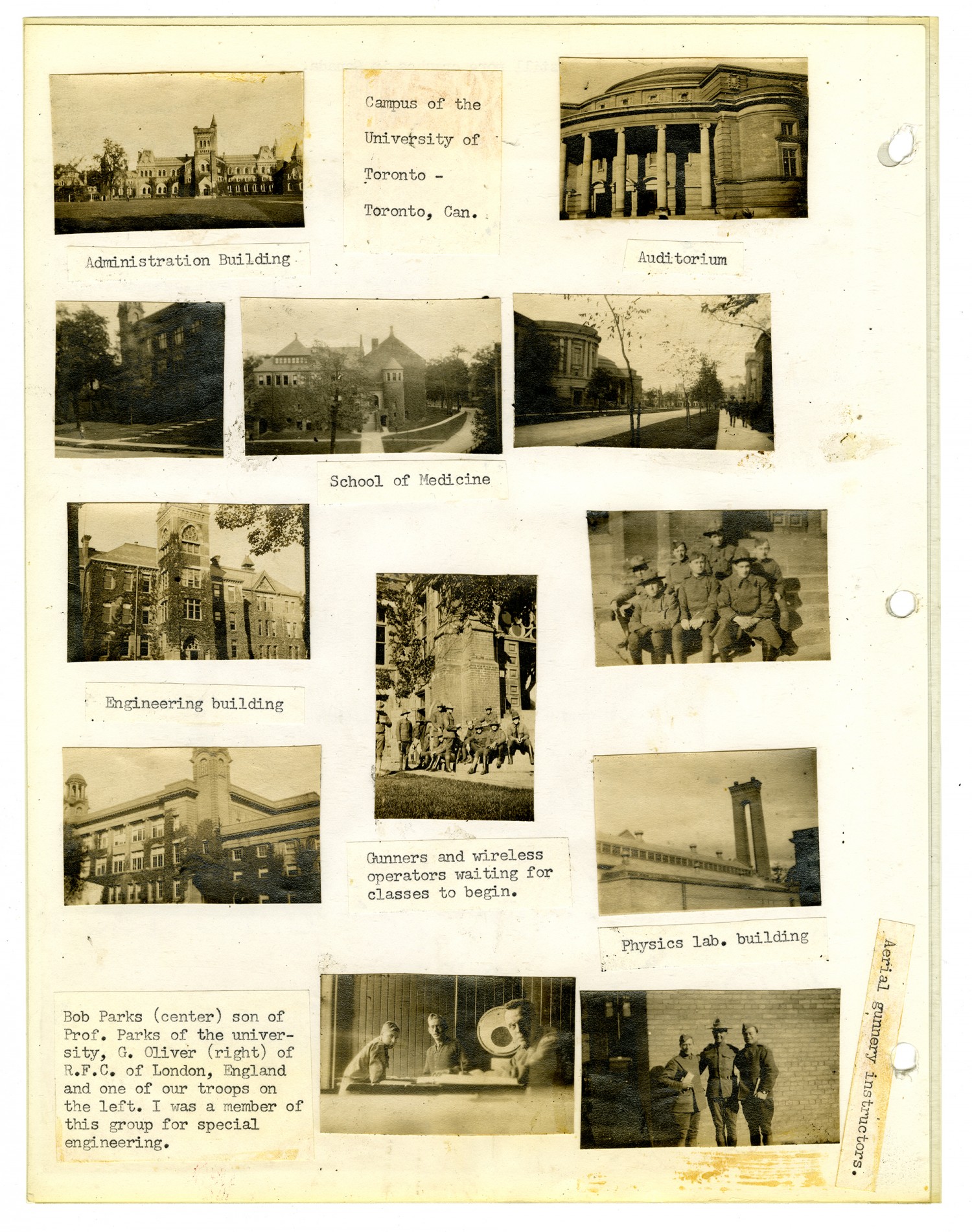
Transcript
[1st row left photograph] Administration Building Campus of the University of Toronto

Transcript
Enroute to Texas once more with Major Harold E. Hartney The troops in training and on assignments at various stations, were recalled to and reunited at Camp Leaside, on October 22, 1917. There we met for the first time, Major Harold E. Hartney, a Canadian with an outstanding combat military record in the British Royal Flying Corps when he assumed command of the 27th Squadron, on the camp parade ground. We passed in review in perfect British formation before him and the camp band. Since Major Hartney had been informed of the proficiency of our squadron, verily, he was proud to be in command of our outfit. The feeling was mutual. We took to him immediately. Major Hartney was born in Saskatchewan, attended the University of Toronto and graduated in law from the University of Saskatchewan. He spent a year in the Canadian Infantry and two years less one month in the Royal Flying Corps, spending some time on the staff of the School of Special Flying at Gosport, England. He was an ace and the recipient of several decorations, one was the Italian Silver Medal of Honor for Valor. He was shot down four times
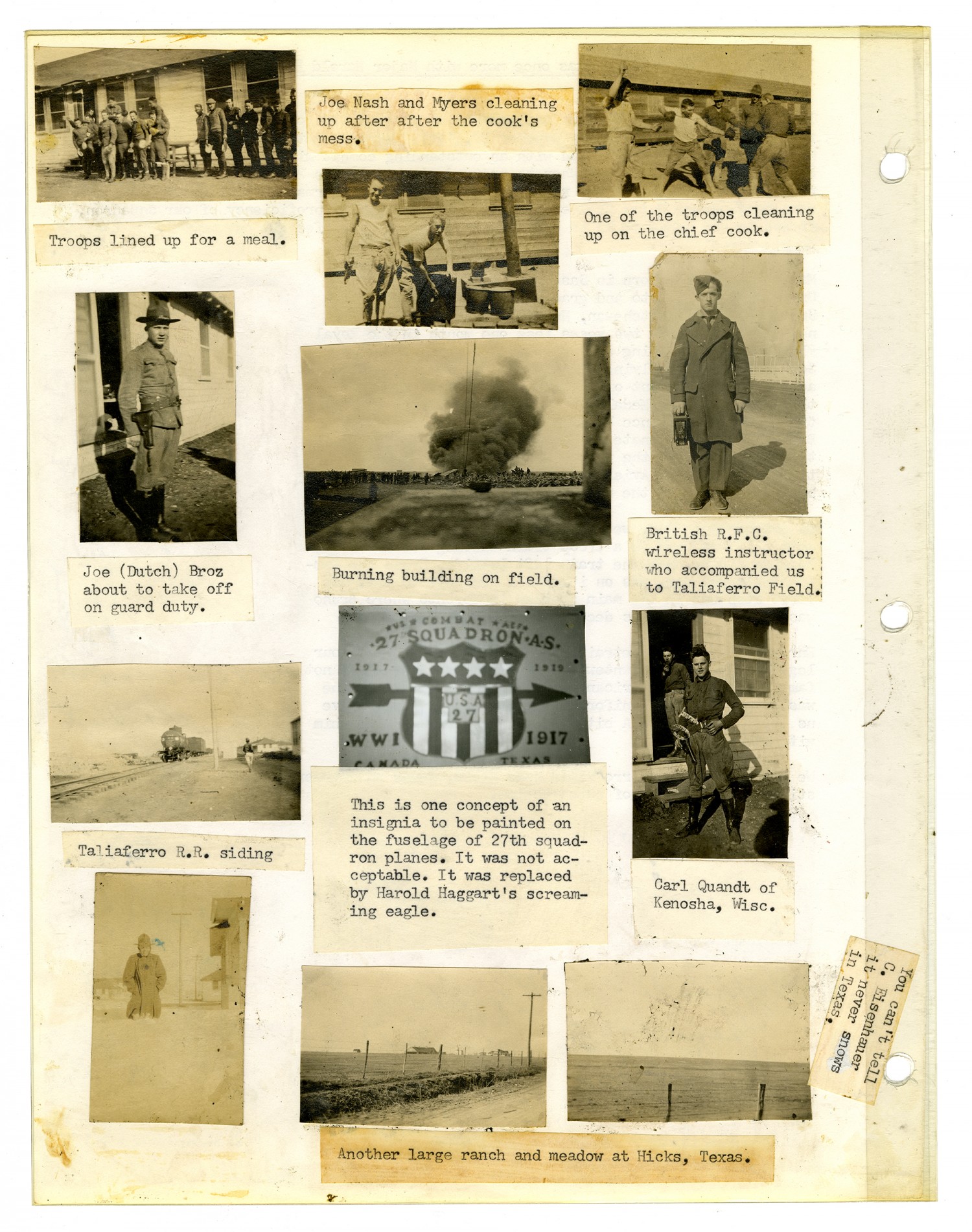
Transcript
[1st row left photograph] Troop lined up for a meal. [1st row middle photograph] Joe Nash and Myers cleaning up after after the cook
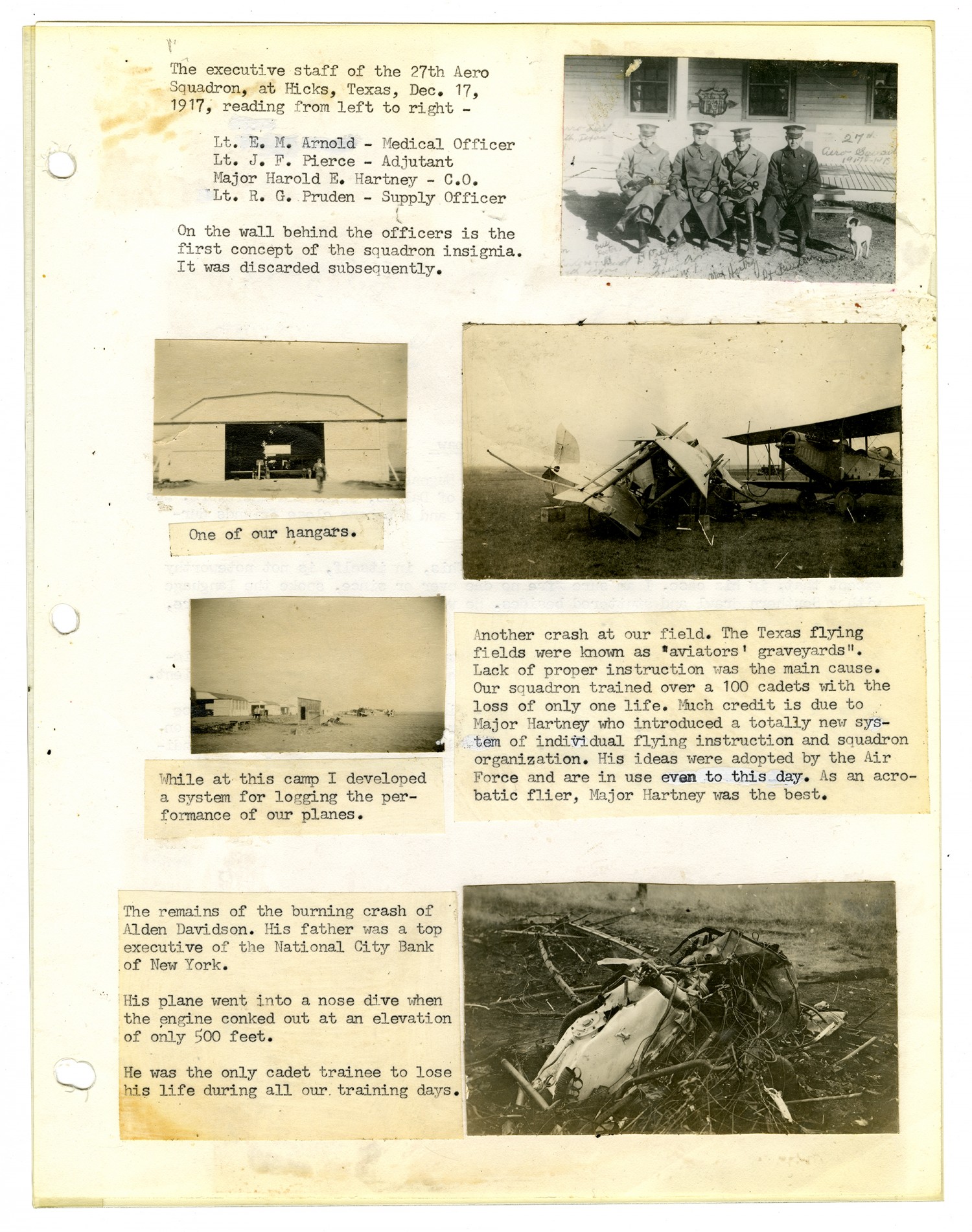
Transcript
[1st row right photograph] The executive staff of the 27th Aero Squadron, at Hicks, Texas, [December] 17, 1917, reading from left to right
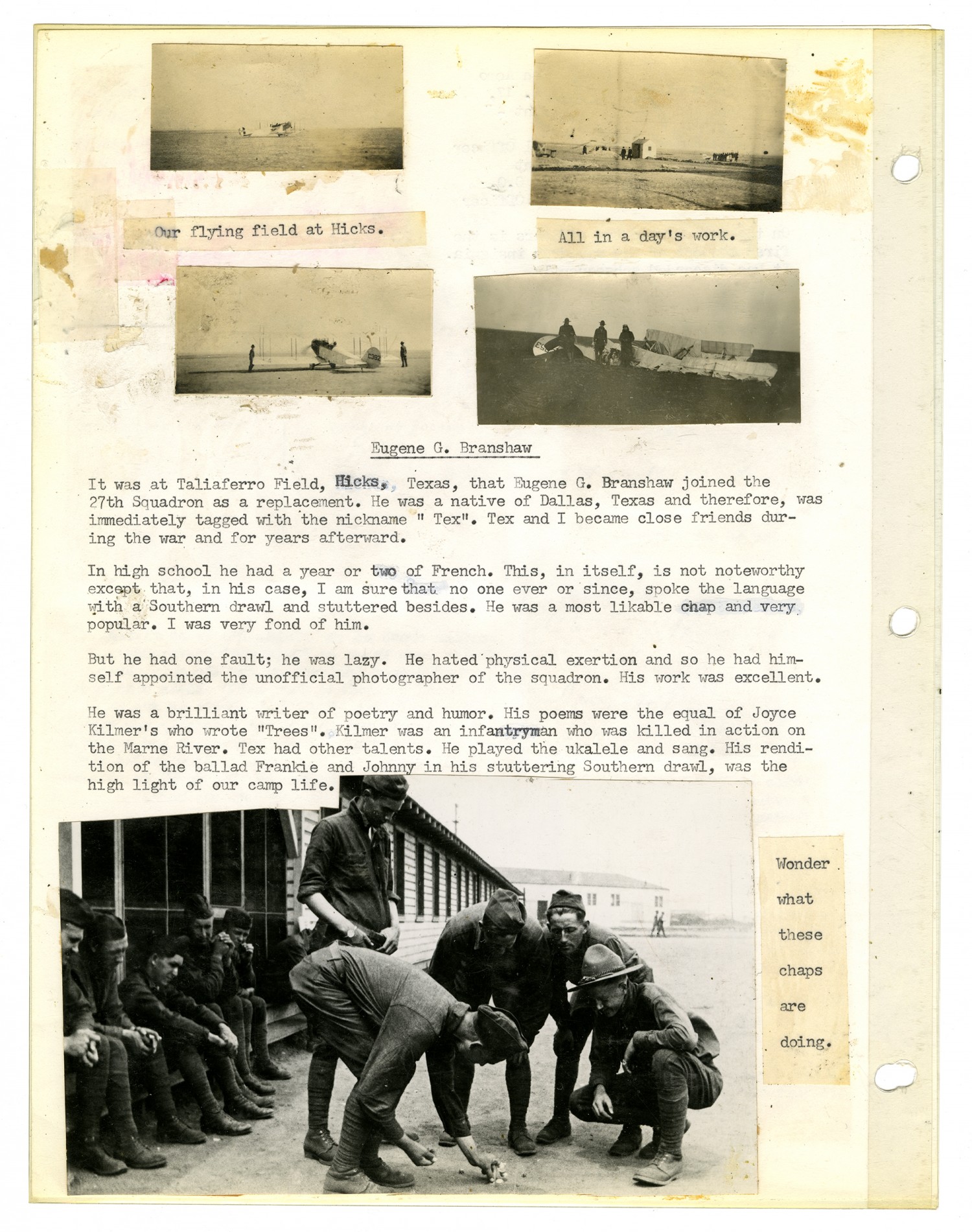
Transcript
[Top left photograph] Our flying field at Hicks. [Top right photograph] All in a day
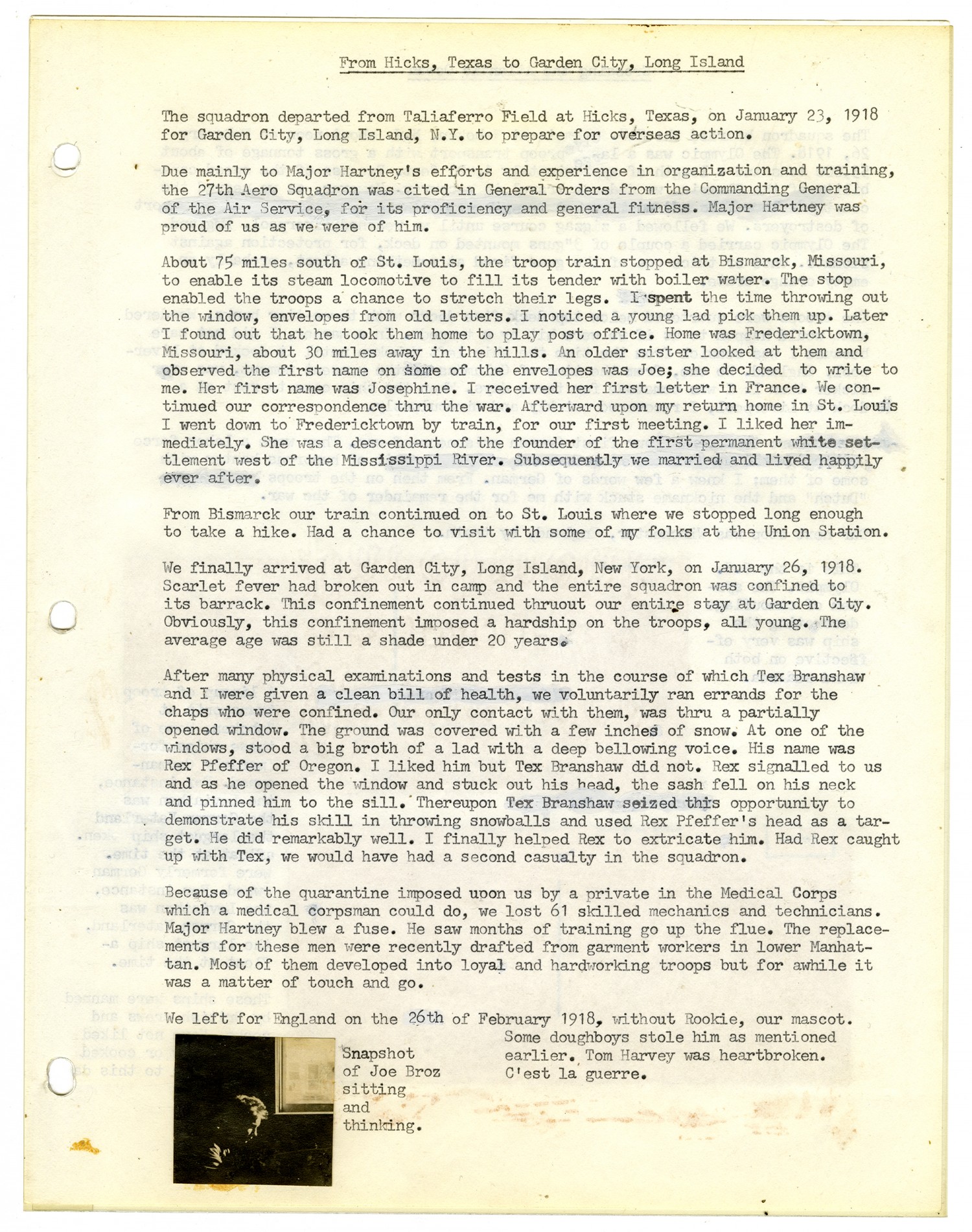
Transcript
From Hicks, Texas to Garden City, Long Island The squadron departed from Taliaferro Field at Hicks, Texas, on January 23, 1918 for Garden City, Long Island, [New York] to prepare for overseas action. Due mainly to Major Hartney
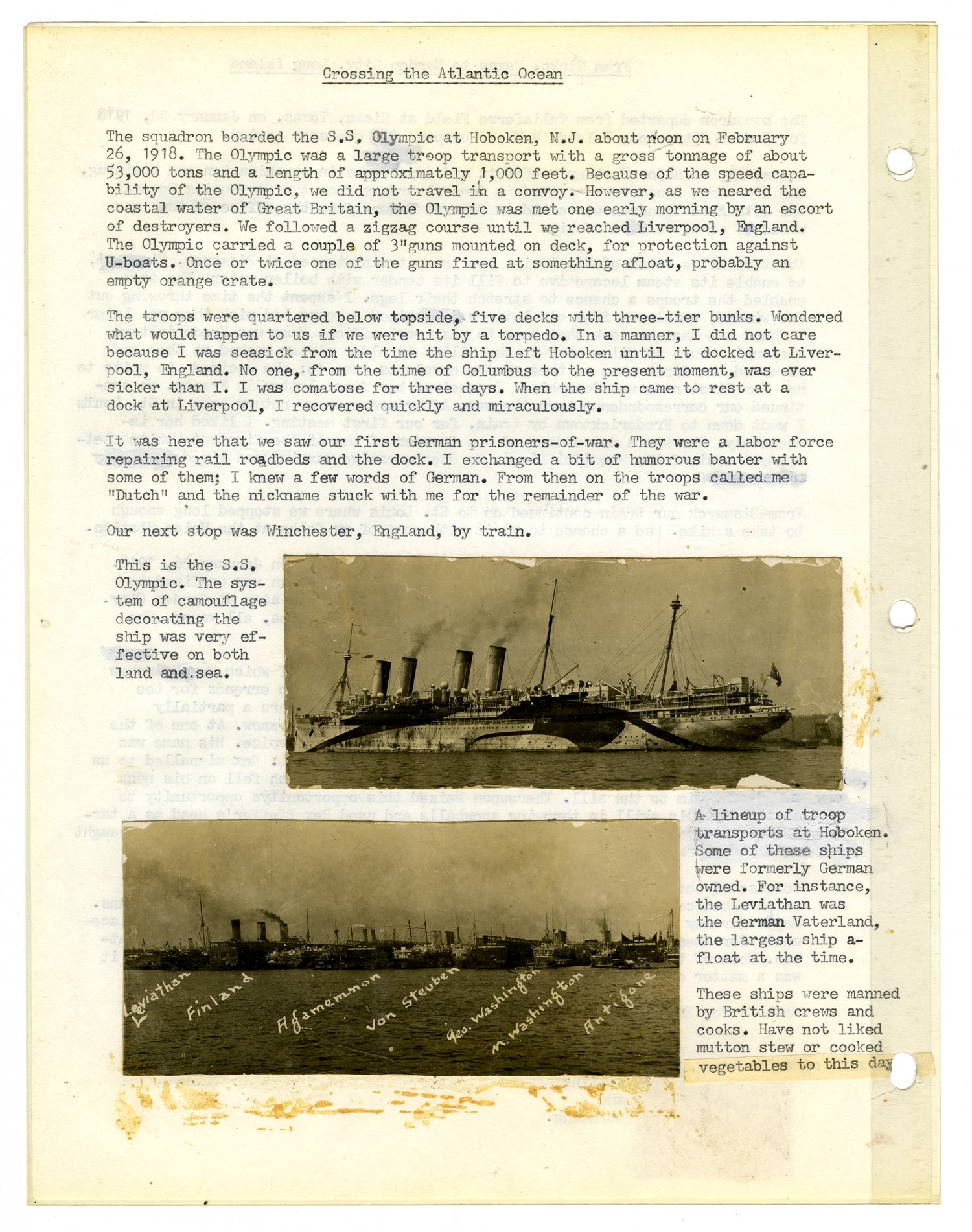
Transcript
Crossing the Atlantic Ocean The squadron boarded the S.S. Olympic at Hoboken, [New Jersey] about noon on February 26, 1918. The Olympic was a large troop transport with a gross tonnage of about 53,000 tons and a length of approximately 1,000 feet. Because of the speed capability of the Olympic, we did not travel in a convoy. However, as we neared the coastal water of Great Britain, the Olympic was met one early morning by an escort of destroyers. We followed a zigzag course until we reached Liverpool, England. The Olympic carried a couple of 3
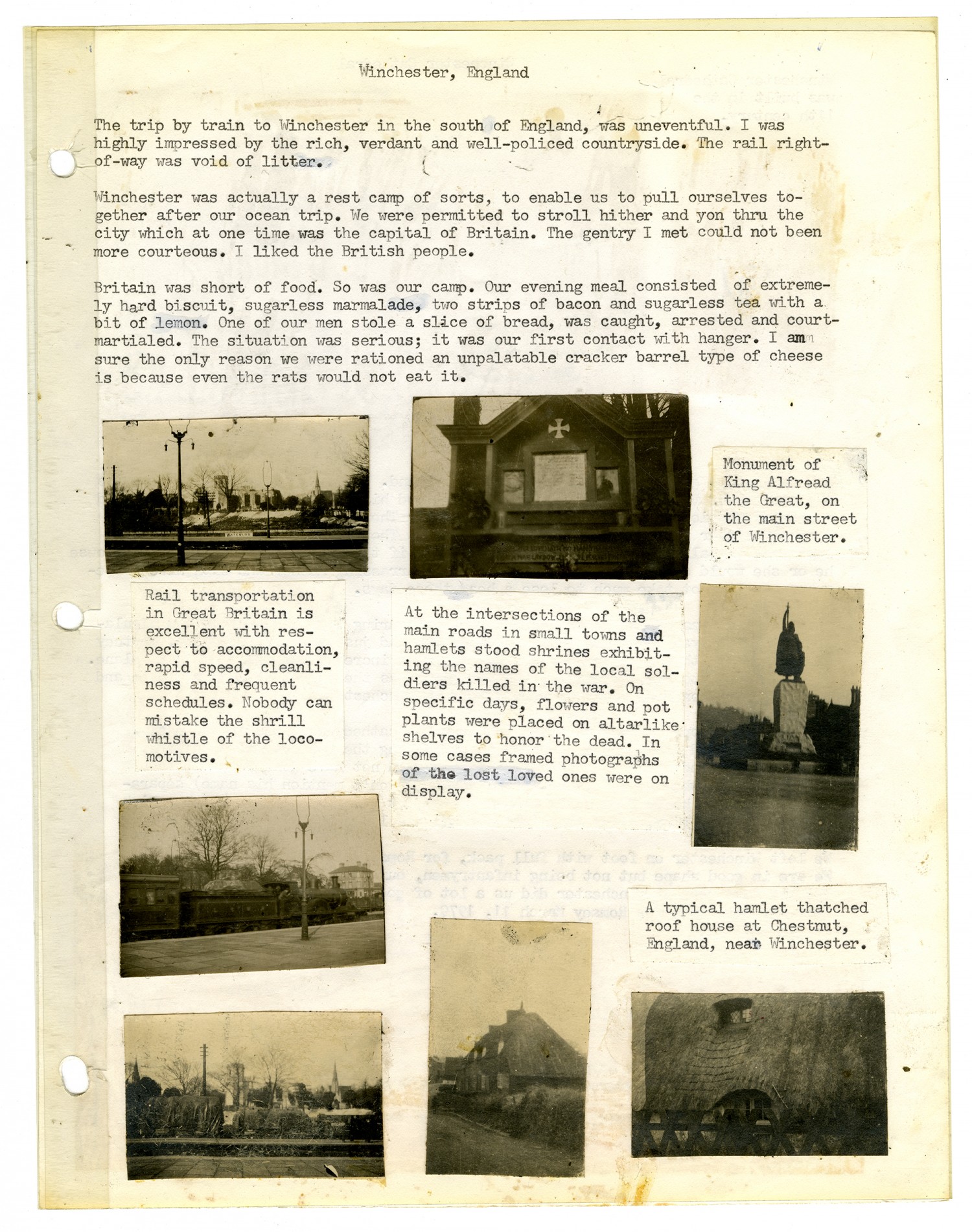
Transcript
Winchester, England The trip by train to Winchester in the south of England, was uneventful. I was highly impressed by the rich, verdant and well-policed countryside. The rail right-of-way was void of litter. Winchester was actually a rest camp of sorts, to enable us to pull ourselves together after our ocean trip. We were permitted to stroll hither and yon thru the city which at one time was the capital of Britain. The gentry I met could not been more courteous. I liked the British people. Britain was short of food. So was our camp. Our evening meal consisted of extremely hard biscuit, surgarless marmalade, two strips of bacon and sugarless tea with a bit of lemon. One of our men stole a slice of bread, was caught, arrested and courtmartialed. The situation was serious; it was our first contact with hanger. I am sure the only reason we were rationed an unpalatable cracker barrel type of chees is because even the rats would not eat it. [1st row left photograph] Rail transportation in Great Britain is excellent with respect to accommodation, rapid speed, cleanliness and frequent schedules. Nobody can mistake the shrill whistle of the locomotives. [1st row right photograph] At the intersections of the main roads in small towns and hamlets stood shrines exhibiting the names of the local soldiers killed in the war. On specific days, flowers and pot plants were placed on altarlike shelves to honor the dead. In some cases framed photographs of the lost loved ones were on display. [2nd row right photograph] Monument of King Alfread the Great, on the main street of Winchester. [3rd row right photograph] A typical hamlet thatched roof house at Chestnut, England, near Winchester.
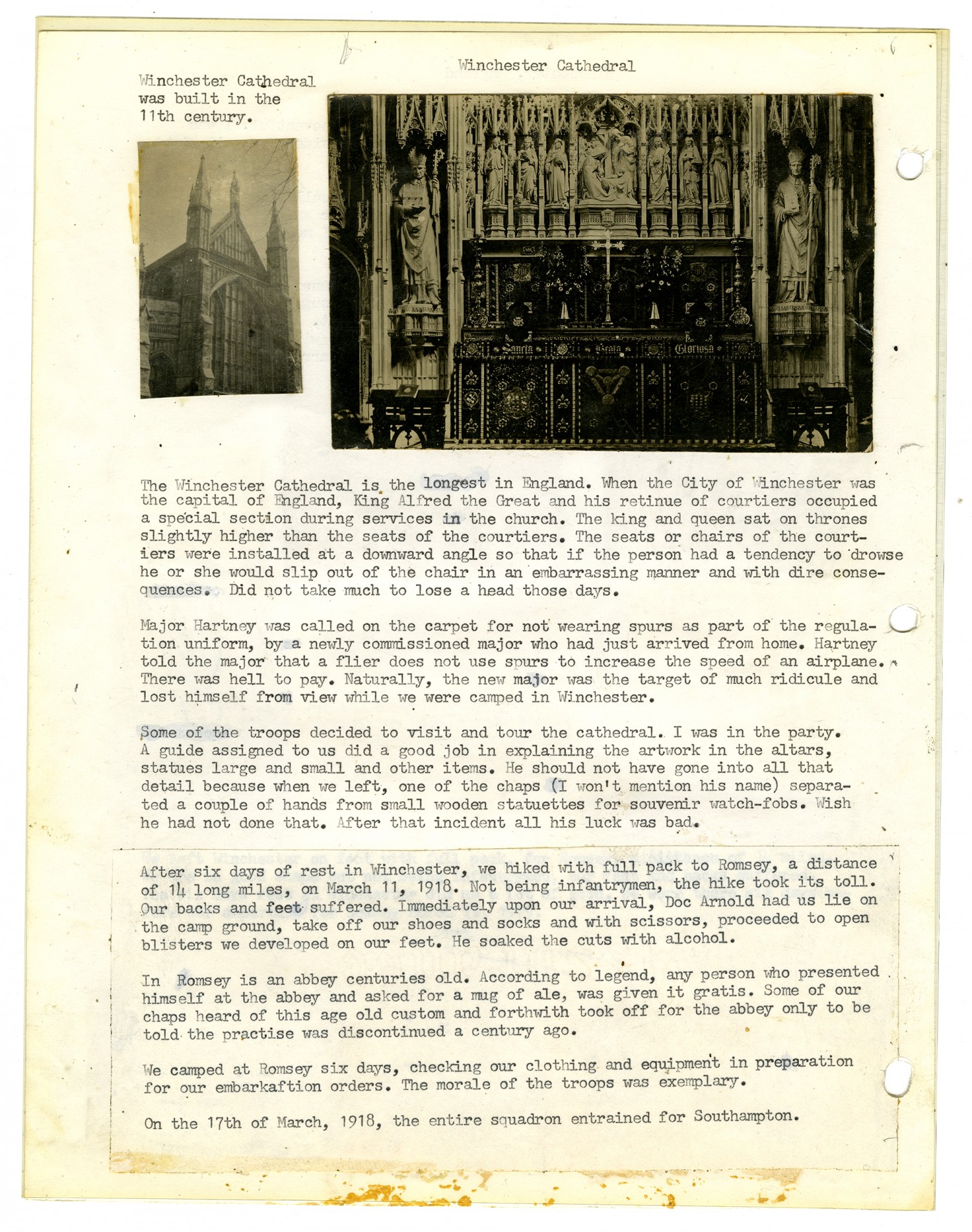
Transcript
Winchester Cathedral [Top left photograph] Winchester Cathedral was built in the 11th century. The Winchester Cathedral is the longest in England. When the City of Winchester was the capital of England, King Alfred the Great and his retinue of courtiers occupied a special section during services in the church. The king and queen sat on thrones slightly higher than the seats of the courtiers. The seats or chairs of the courtiers were installed at a downward angle so that if the person had a tendency to drowse he or she would slip out of the chair in an embarrassing manner and with dire consequences. Did not take much to lose a head those days. Major Hartney was called on the carpet for not wearing spurs as part of the regulation uniform, by a newly commissioned major who had just arrived from home. Hartney told the major that a flier does not use spurs to increase the speed of an airplane. There was hell to pay. Naturally, the new major was the target of much ridicule and lost himself from view while we were camped n Winchester. Some of the troops decided to visit and tour the cathedral. I was in the party. A guide assigned to us did a good job in explaining the artwork in the altars, statues large and small and other items. He should not have gone into all that detail because when we left, one of the chaps (I won
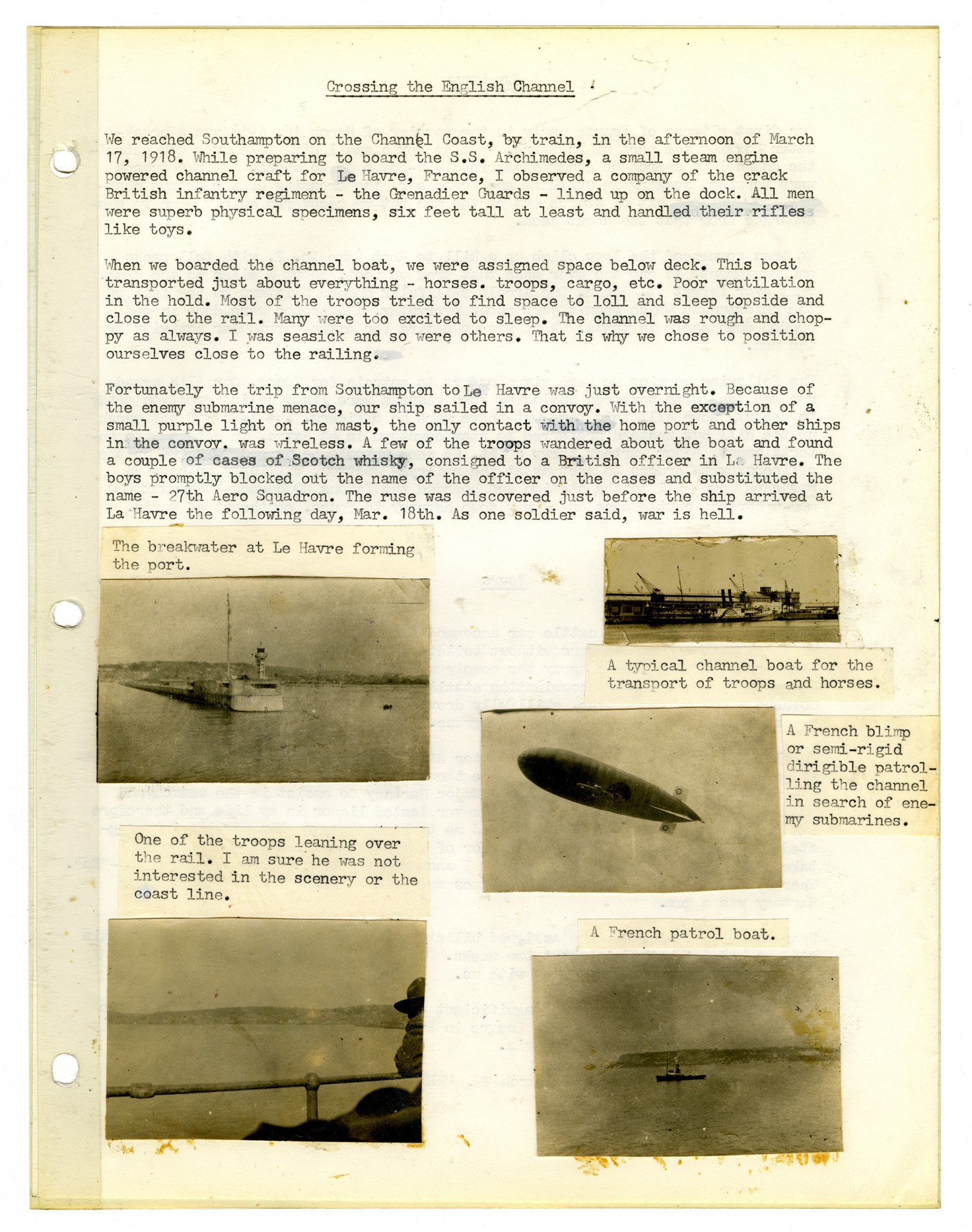
Transcript
Crossing the English Channel We reached Southampton on the Channel Coast, by train, in the afternoon of March 17, 1918. While preparing to board the S.S. Archimedes, a small steam engine powered channel craft for Le Havre, France, I observed a company of the crack British infantry regiment
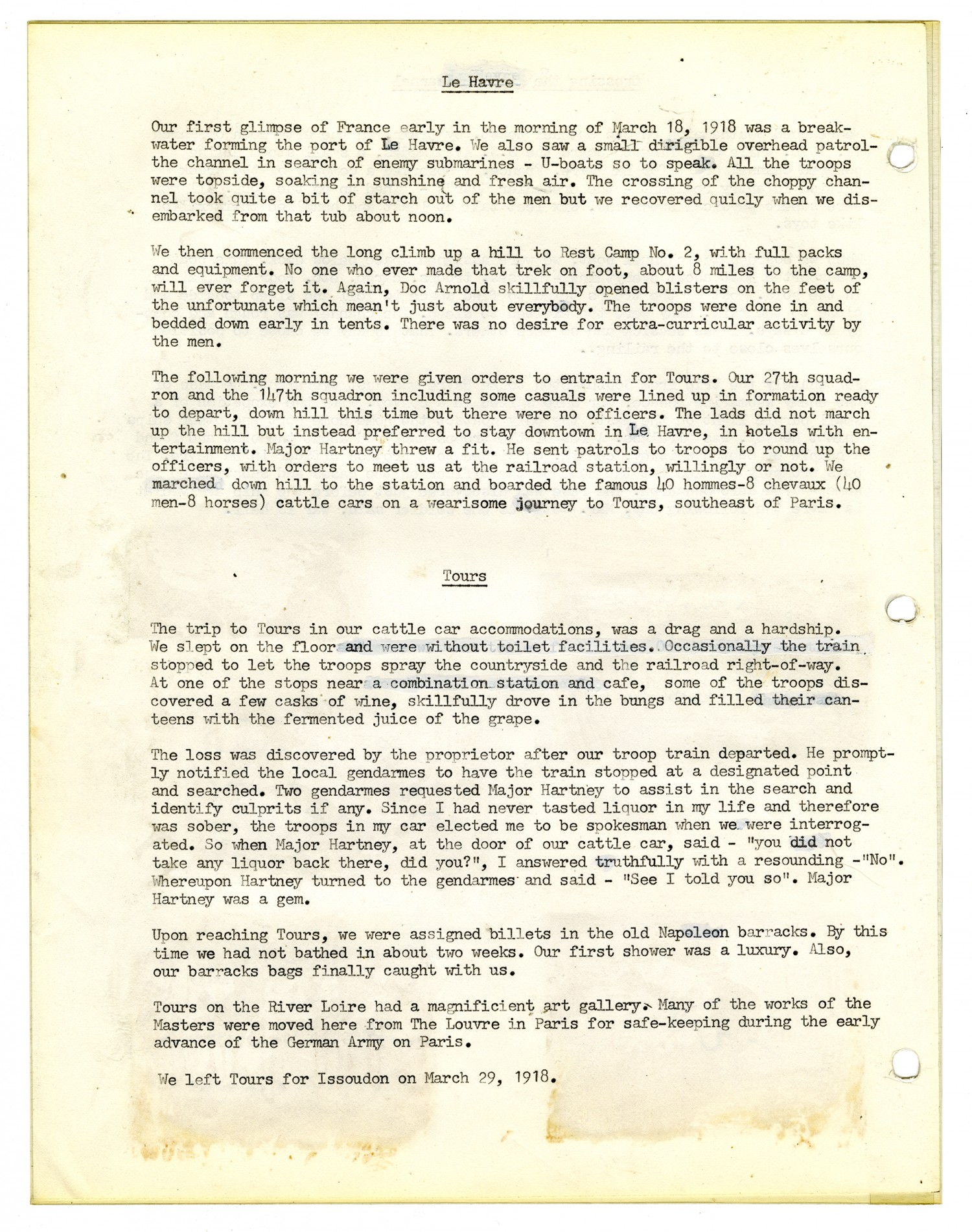
Transcript
Le Havre Our first glimpse of France early in the morning of March 18, 1918 was a breakwater forming the port of Le Havre. We also saw a small dirigible overhead patrol the channel in search of enemy submarines
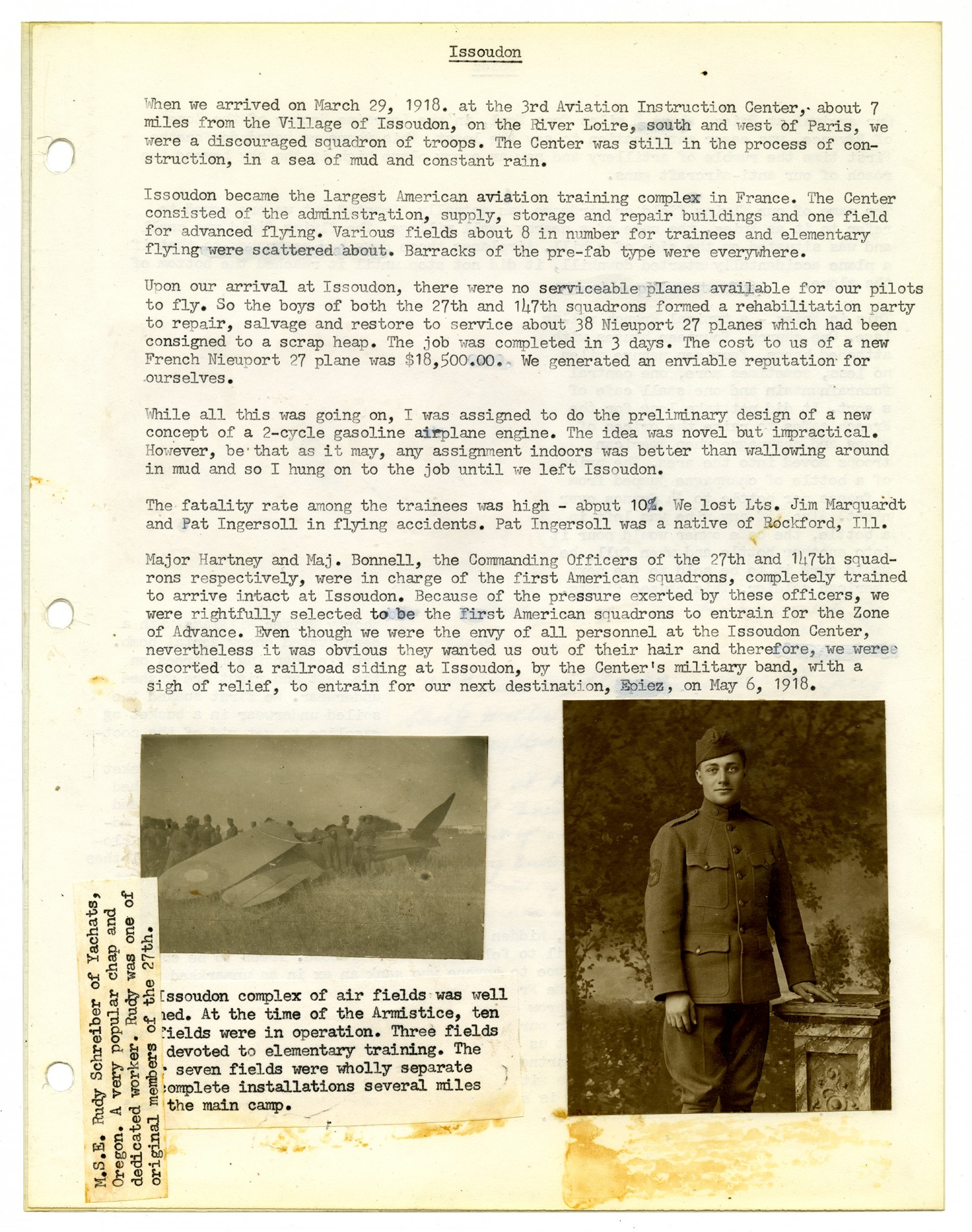
Transcript
Issoudon When we arrived on March 29, 1918. at the 3rd Aviation Instruction Center, about 7 miles from the Village of Issoudon, on the River Loire, south and west of Paris, we were a discouraged squadron of troops. The Center was still in the process of construction, in a sea of mud and constant rain. Issoudon became the largest American aviation training complex in France. The Center consisted of the administration, supply, storage and repair buildings and one field for advanced flying. Various fields about 8 in number for trainees and elementary flying were scattered about. Barracks of the pre-fab type were everywhere. Upon our arrival at Issoudon, there were no serviceable planes available for our pilots to fly. So the boys of both the 27th and 147th squadrons formed a rehabilitation party to repair, salvage and restore to service about 38 Nieuport 27 planes which had been consigned to a scrap heap. The job was completed in 3 days. The cost to us of a new French Nieuport 27 plane was $18,500.00. We generated an enviable reputation for ourselves. While all this was going on, I was assigned to do the preliminary design of a new concept of a 2-cycle gasoline airplane engine. The idea was novel but impractical. However, be that as it may, any assignment indoors was better than wallowing around in mud and so I hung on to the job until we left Issoudon. The fatality rate among the trainees was high
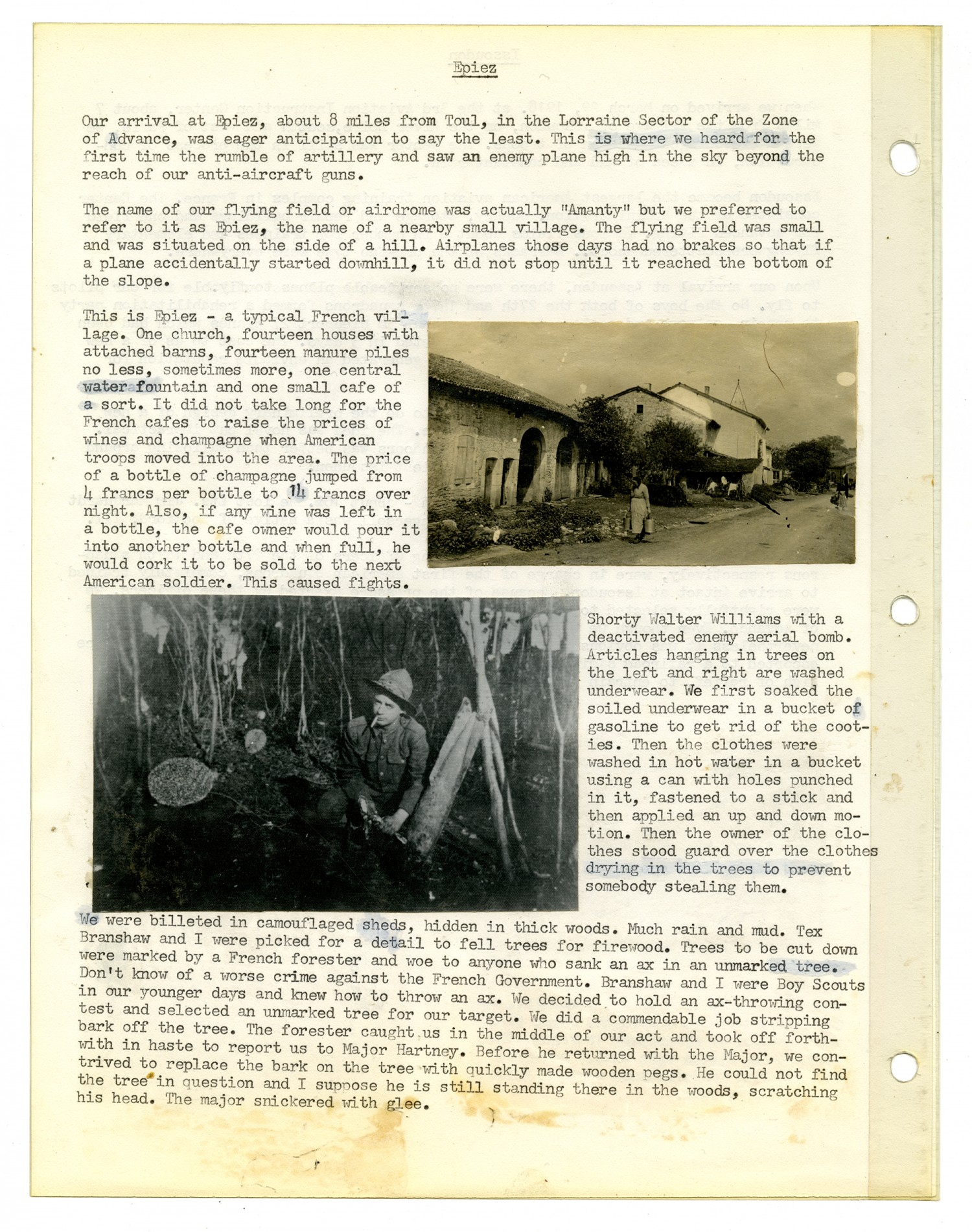
Transcript
Epiez Our arrival at Epiez, about 8 miles from Toul, in the Lorraine Sector of the Zone of Advance, was eager anticipation to say the least. This is where we heard for the first time the rumble of artillery and saw an enemy plane high in the sky beyond the reach of our anti-aircraft guns. The name of our flying field or airdrome was actually
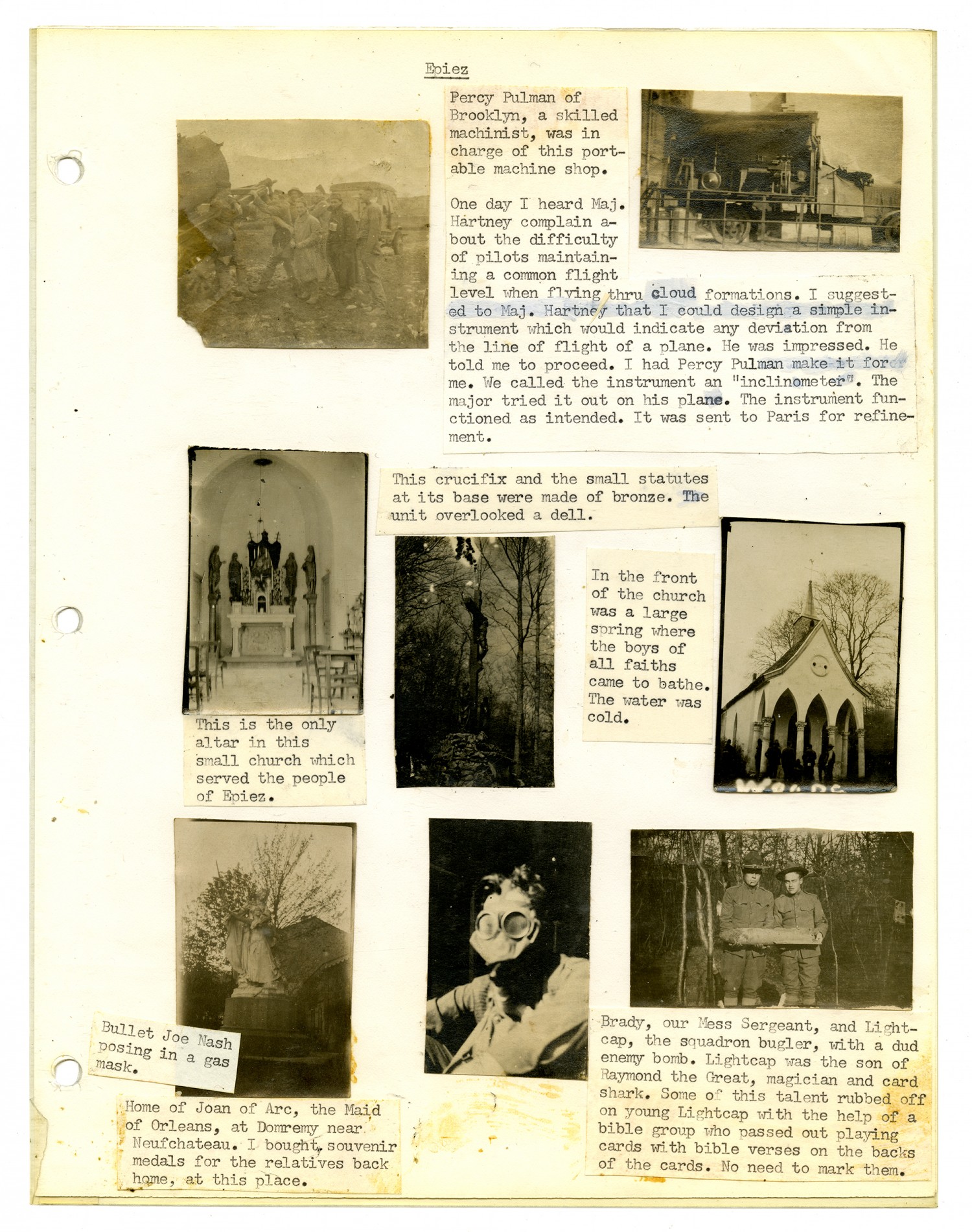
Transcript
Epiez [Top right photograph] Percy Pulman of Brooklyn, a skilled machinist, was in charge of this portable machine shop. One day I heard Maj. Hartney complain about the difficulty of pilots maintaining a common flight level when flying thru cloud formations. I suggested to Maj. Hartney that I could design a simple instrument which would indicate any deviation from the line of flight of a plane. He was impressed. He told me to proceed. I had Percy Pulman make it for me. We called the instrument an

Transcript
Epiez Sgt. Krause and his crew checking over a plane just flown in from Orly near Paris. This is a Nieuport 28. A good plane but the ferry pilots who flew them to our airdrome for our use, cracked up two of three planes on landing. The planes were manufactured and supplied to us by the French Government at a price of $18,500.00 each. We did not lose any of our pilots at Epiez, thanks to the close inspection by our mechanics, of the incoming new planes. Lightning killed one of our men on guard duty at Epiez. This was our only casualty here. We did lose a perfectly good plane and a hangar when someone forgot to ground the hose nozzle causing static to set the engine fuel on fire. Because we were about to advance closer to the fighting area, we were given advice by a young punk in the Medical Corps on brushing our teeth. He drew some uncomplimentary remarks from the troops. But the worst was reserved for the unpopular, unprincipled sergeant who warned us about consorting with women subject to veneral disease. The troops greeted him with a long raucous razzberry. This is the guy who developed a case of gonorrhea at Hicks, Texas and left some germs in a wash in our common latrine which infected the eyes of one of our more popular chaps. He recovered his sight luckily. But, while the top sergeant was giving us a lecture and admonition here in France, he picked up another dose of a venereal disease a short time before. When this was discovered by our Medical Officer, the top sergeant was demoted and transferred to a labor battalion at a seaport. I understand he came to a dismal end. No tears were shed. One night about 2:00 A.M. we had a surprise gas mask drill. Somebody dropped an open can of jam on the face of John Lynch
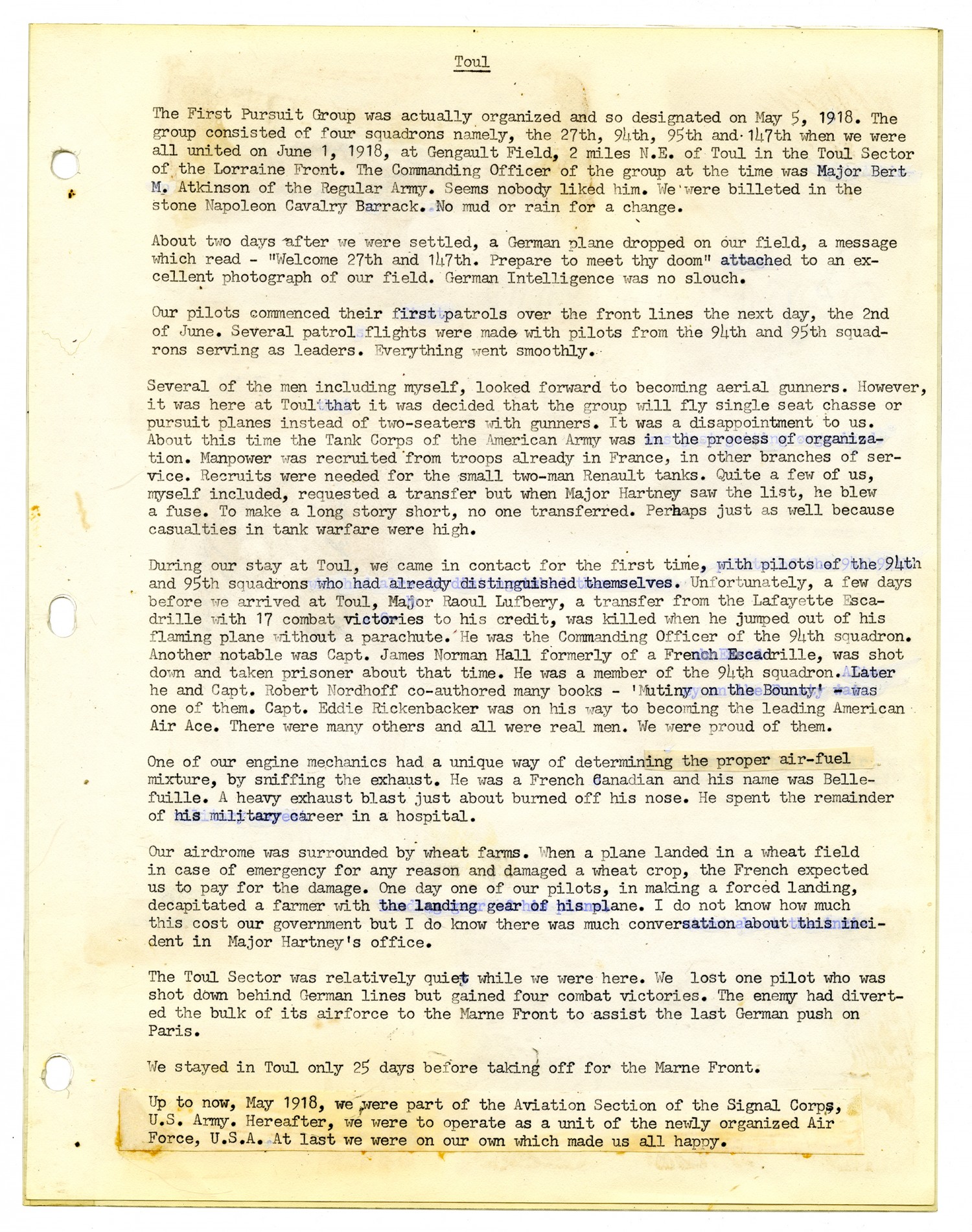
Transcript
Toul The First Pursuit Group was actually organized and so designated on May 5, 1918. The group consisted of four squadrons namely, the 27th, 94th, 95th and 147th when we were all united on June 1, 1918, at Gengault Field, 2 miles N.E. of Toul in the Toul Sector of the Lorraine Front. The Commanding Officer of the group at the time was Major Bert M. Atkinson of the Regular Army. Seems nobody liked him. We were billeted in the stone Napoleon Cavalry Barrack. No mud or rain for a change. About two days after we were settled, a German plane dropped on our field, a message which read
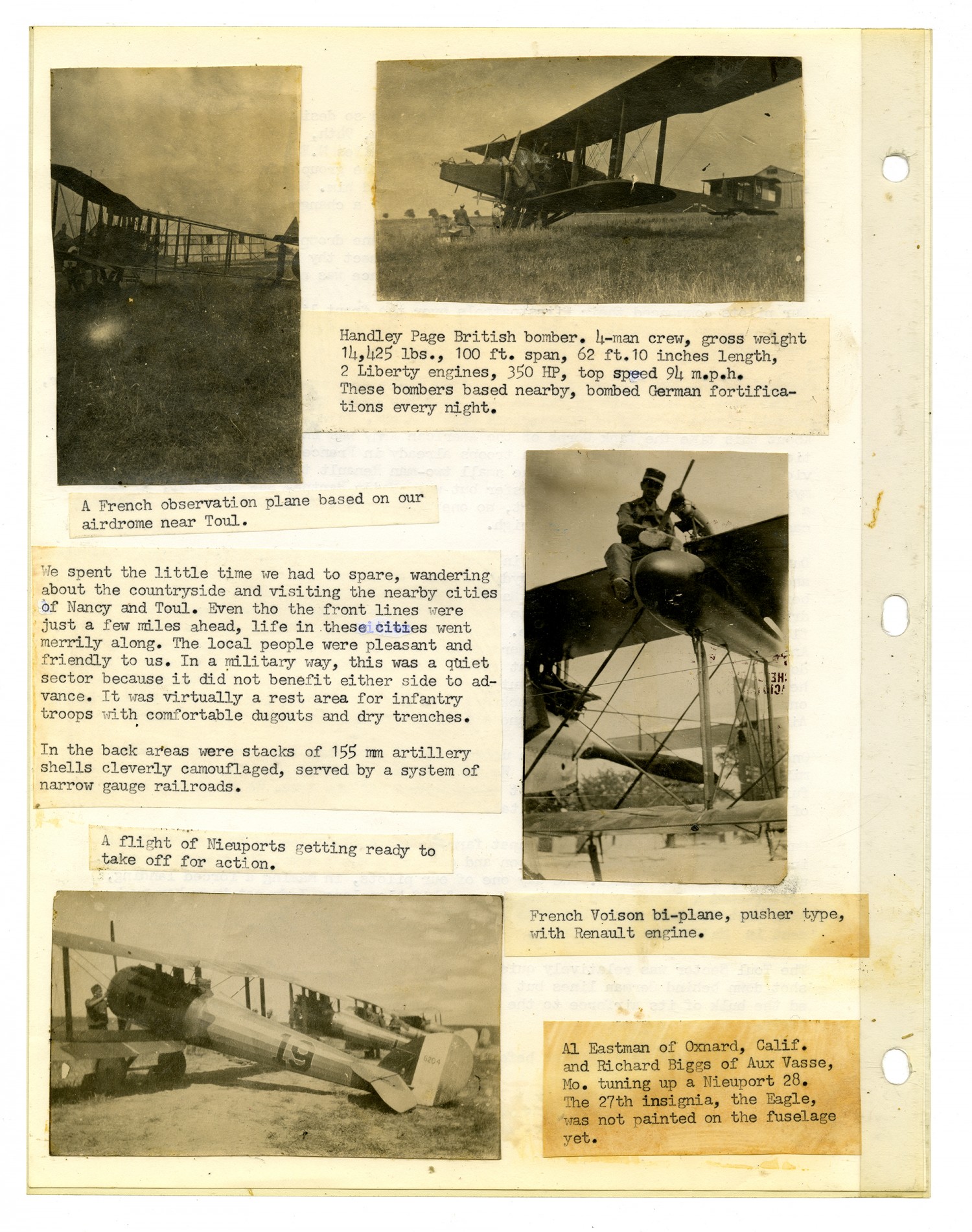
Transcript
[Top left photograph] A French observation plane based on our airdrome near Toul. [Top right photograph] Handley Page British bomber. 4-man crew, gross weight 14,425 lbs., 100 ft. span, 62 ft. 10 inches length, 2 Liberty engines, 350 HP, top speed 94 m.p.h. These bombers based nearby, bombed German fortifications every night. We spent the little time we had to spare, wandering about the countryside and visiting the nearby cities of Nancy and Toul. Even tho the front lines were just a few miles ahead, life in these cities went merrily along. The local people were pleasant and friendly to us. In a military way, this was a quiet sector because it did not benefit either side to advance. It was virtually a rest area for infantry troops with comfortable dugouts and dry trenches. In the back areas were stacks of 155 mm artillery shells cleverly camouflaged, served by a system of narrow gauge railroads. [Bottom left photograph] A flight of Nieuports getting ready to take off for action. French Voison bi-plane, pusher type, with Renault engine. Al Eastman of Oxnard, [California] and Richard Biggs of Aux Vasse, [Missouri] tuning up a Nieuport 28. The 27th insignia, the Eagle, was not painted on the fuselage yet.
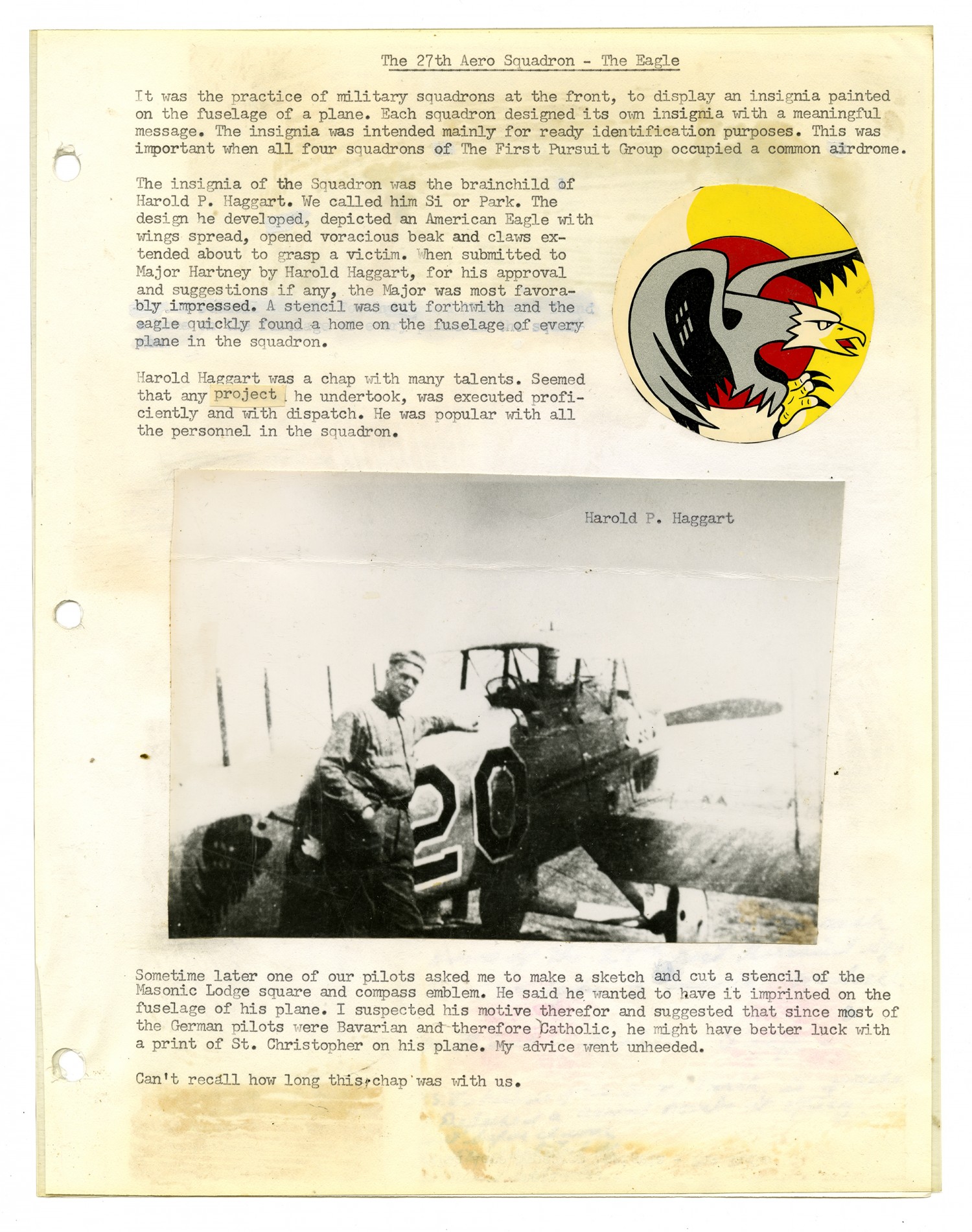
Transcript
The 27th Aero Squadron
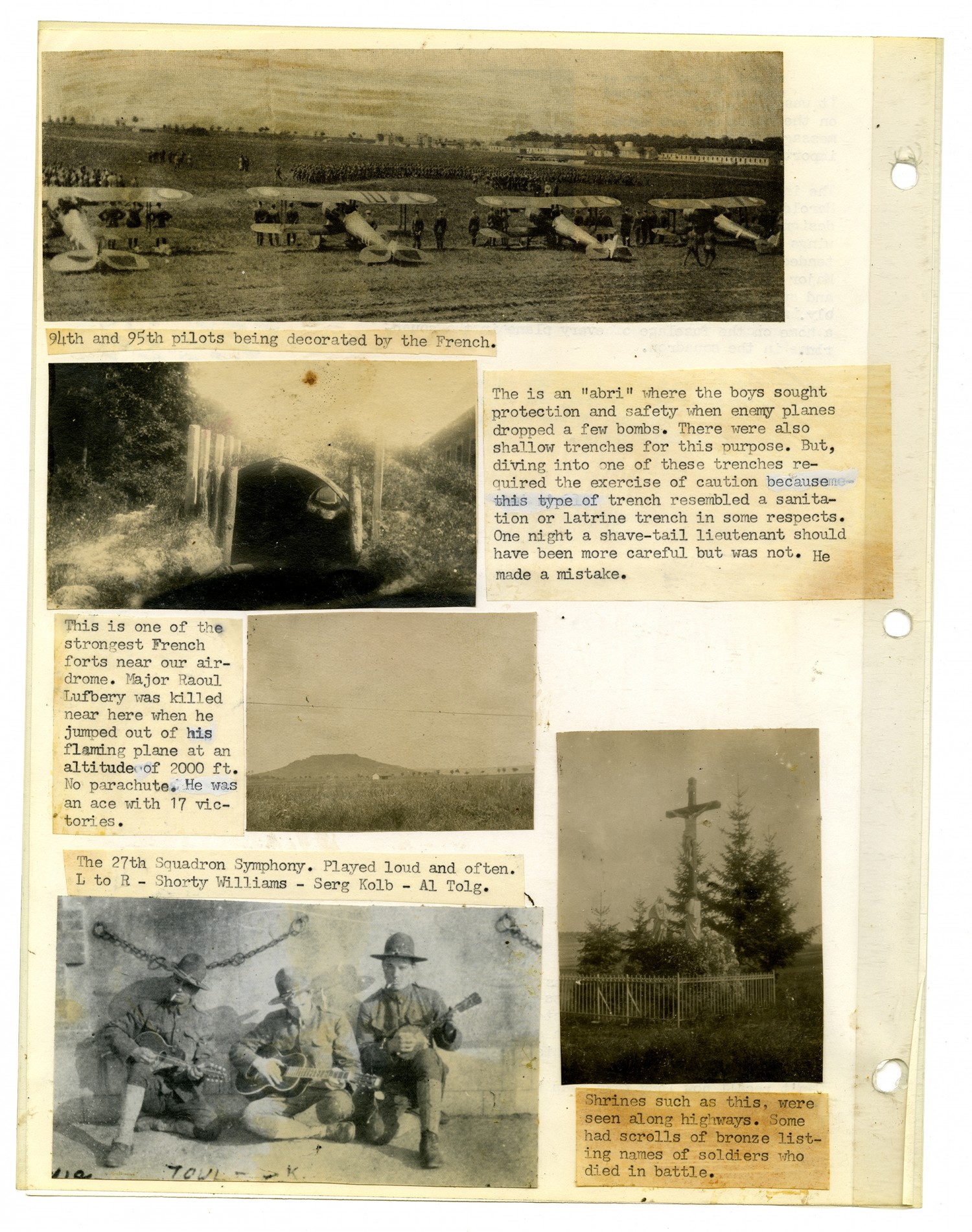
Transcript
[1st row photograph] 94th and 95th pilots being decorated by the French. [2nd row photograph] The is an
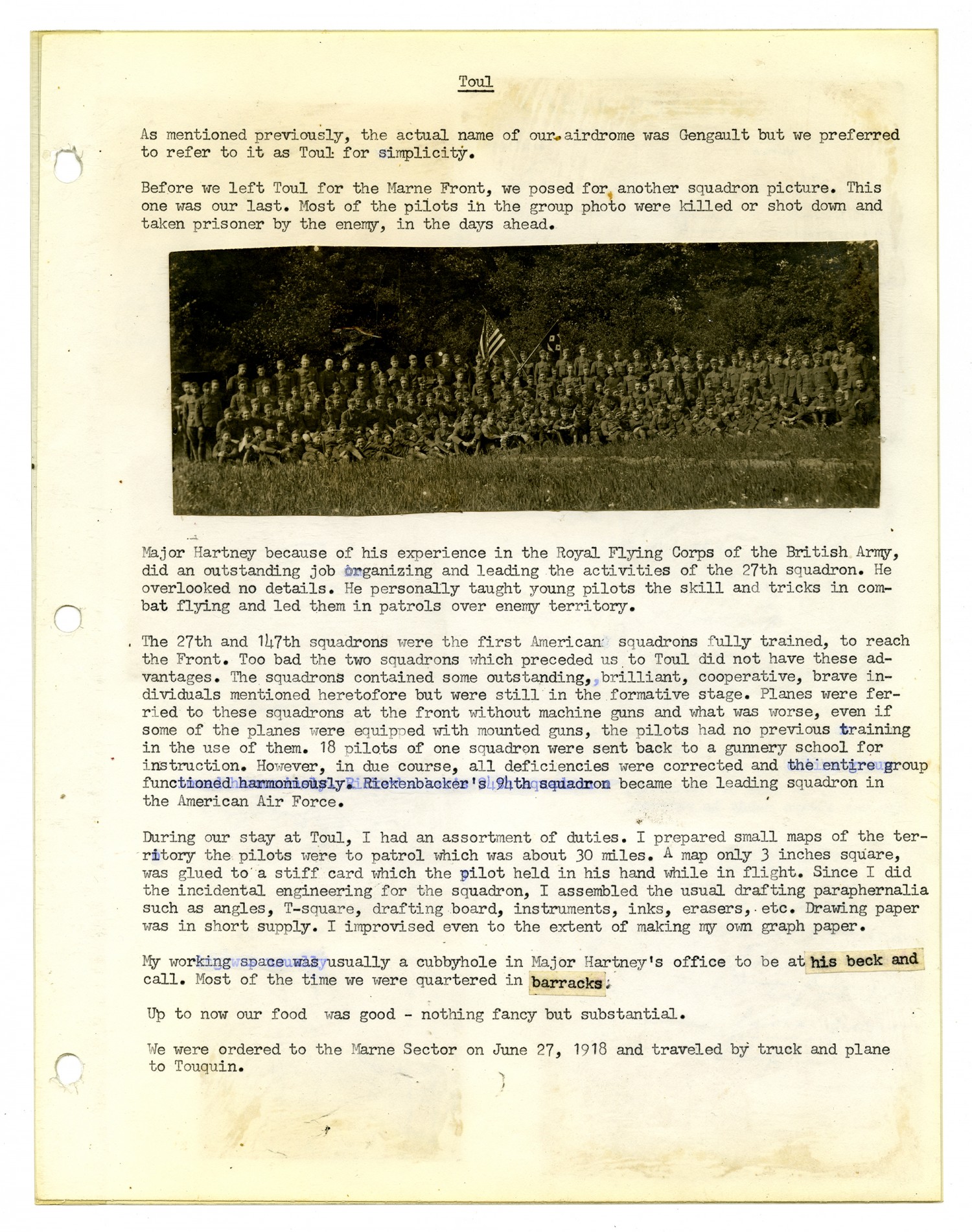
Transcript
Toul As mentioned previously, the actual name of our airdrome was Gengault but we preferred to refer to it as Toul for simplicity. Before we left Toul for the Marne Front, we posed for another squadron picture. This one was our last. Most of the pilots in the group photo were killed or shot down and taken prisoner by the enemy, in the days ahead. Major Hartney because of his experience in the Royal Flying Corps of the British Army, did an outstanding job organizing and leading the activities of the 27th squadron. He overlooked no details. He personally taught young pilots the skill and tricks in combat flying and led them in patrols over enemy territory. The 27th and 147th squadrons were the first American squadrons fully trained, to reach the Front. Too bad the two squadrons which precede us to Toul did not have these advantages. The squadrons contained some outstanding, brilliant, cooperative, brave individuals mentioned heretofore but were still in the formative stage. Planes were ferried to these squadrons at the front without machine guns and what was worse, even if some of the planes were equipped with mounted guns, the pilots had no previous training in the use of them. 18 pilots of one squadron were sent back to a gunnery school for instruction. However, in due course, all deficiencies were corrected and the entire group functioned harmoniously. Rickenbacker

Transcript
[1st row left photograph] Enroute to Touquin in the Marne Sector we camped overnight on this French farm which was within sound of heavy artillery. This farm had been occupied by enemy cavalry during the drive on Paris in 1914. This front was very active. The enemy was making his last big push and had made some progress. Everybody was on alert. Precautions were taken in case of a breakthru by German infantry and tanks. The German air force controlled the air. We were a bit apprehensive. French recruits in single file drill. [2nd row left photograph] An exploding grenade. [2nd row right photograph] A training trench but also available for defense. [3rd row left photograph] Barbed wire entanglement. [4th row left photograph] This farm was not far from the war zone but that did not seem to bother a farmer or interfere with his work in the field. Of course, in case of necessity, the farmer was always ready to retreat.
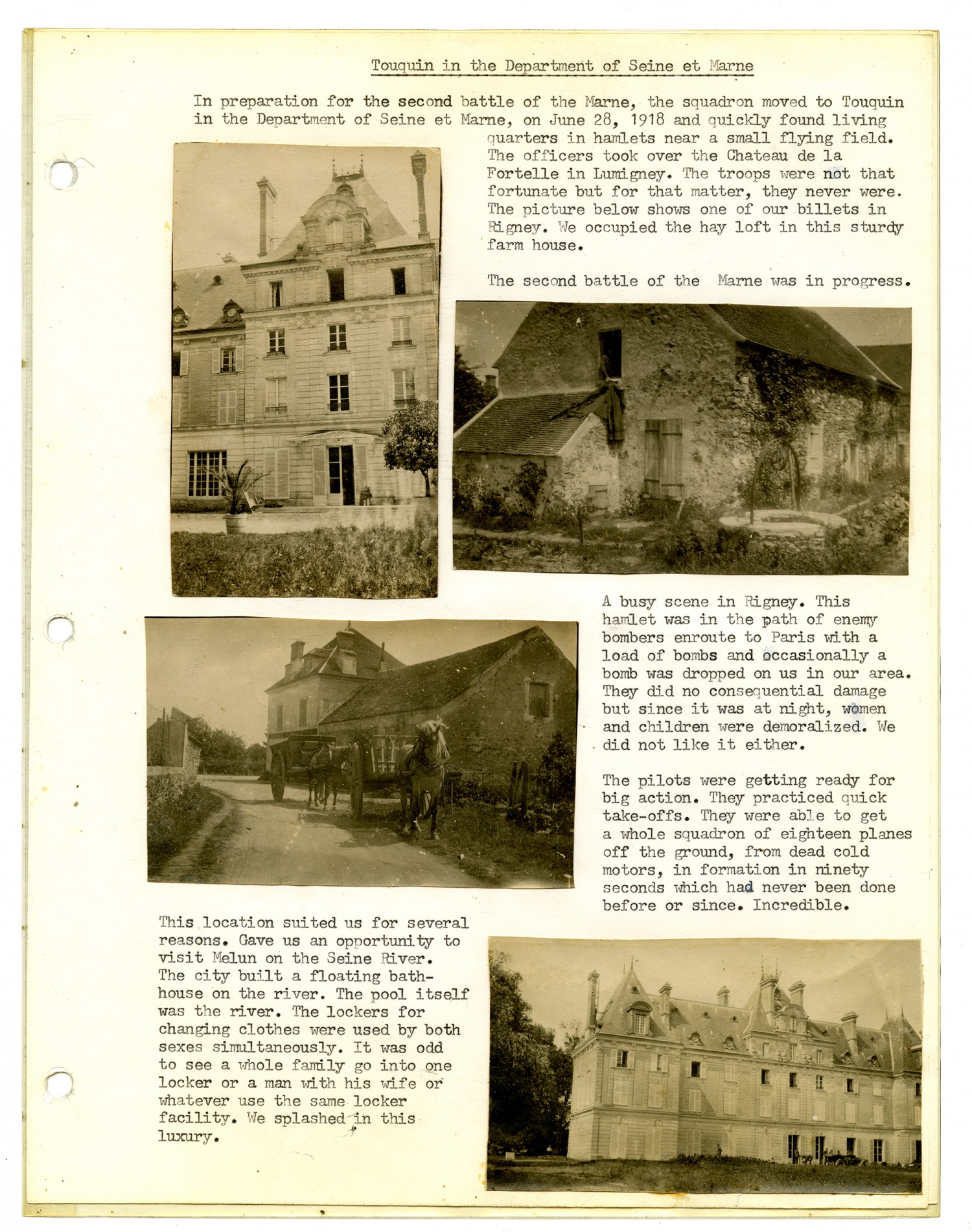
Transcript
Touquin in the Department of Seine et Marne In preparation for the second battle of the Marne, the squadron moved to Touquin in the Department of Seine et Marne, on June 28, 1918 and quickly found living quarters in hamlets near a small flying field. The officers took over the Chateau de la Fortelle in Lumigney. The troops were not that fortunate but for that matter, they never were. The picture below shows one of our billets in Rigney. We occupied the hay loft in this sturdy farm house. The second battle of the Marne was in progress. [2nd row photograph] A busy scene in Rigney. This hamlet was in the path of enemy bombers enroute to Paris with a load of bombs and occasionally a bomb was dropped on us in our area. They did no consequential damage but since it was at night, women and children were demoralized. We did not like it either. The pilots were getting ready for big action. The practiced quick take-offs. They were able to get a whole squadron of eighteen planes off the ground, from dead cold motors, in formation in ninety seconds which had never been done before or since. Incredible. [3rd row photograph] This location suited us for several reasons. Gave us an opportunity to visit Melun on the Seine River. The city built a floating bathhouse on the river. The pool itself was the river. The lockers for changing clothes were used by both sexes simultaneously. It was odd to see a whole family go into one locker or a man with his wife or whatever use the same locker facility. We splashed in this luxury.
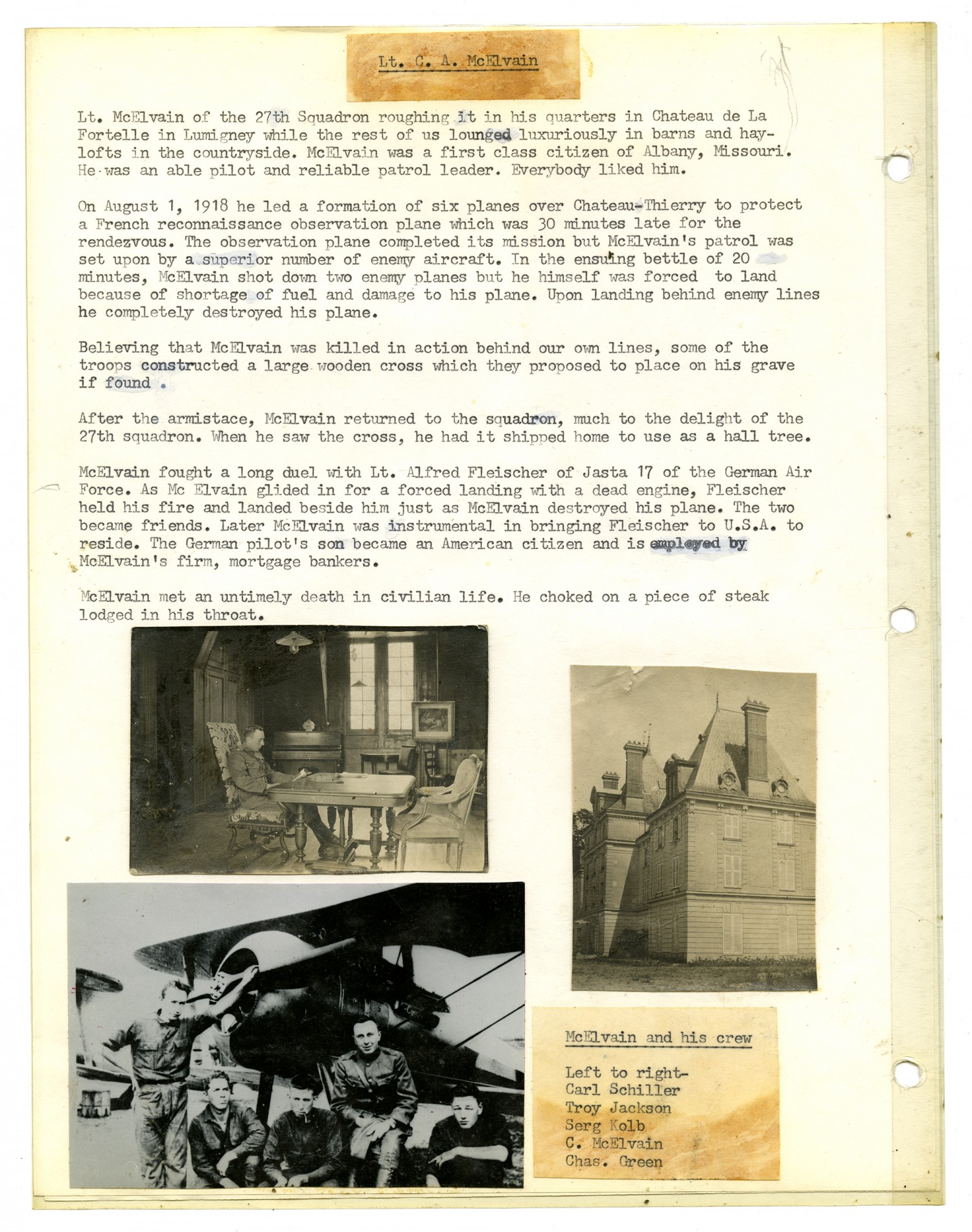
Transcript
Lt. C. A. McElvain Lt. McElvain of the 27th Squadron roughing it in his quarters in Chateau de La Fortelle in Lumigney while the rest of us lounged luxuriously in barns and haylofts in the countryside. McElvain was a first class citizen of Albany, Missouri. He was an able pilot and reliable patrol leader. Everybody liked him. On August 1, 1918 he led a formation of six planes over Chateau-Thierry to protect a French reconnaissance observation plane which was 30 minutes late for the rendezvous. The observation plane completed its mission but McElvain
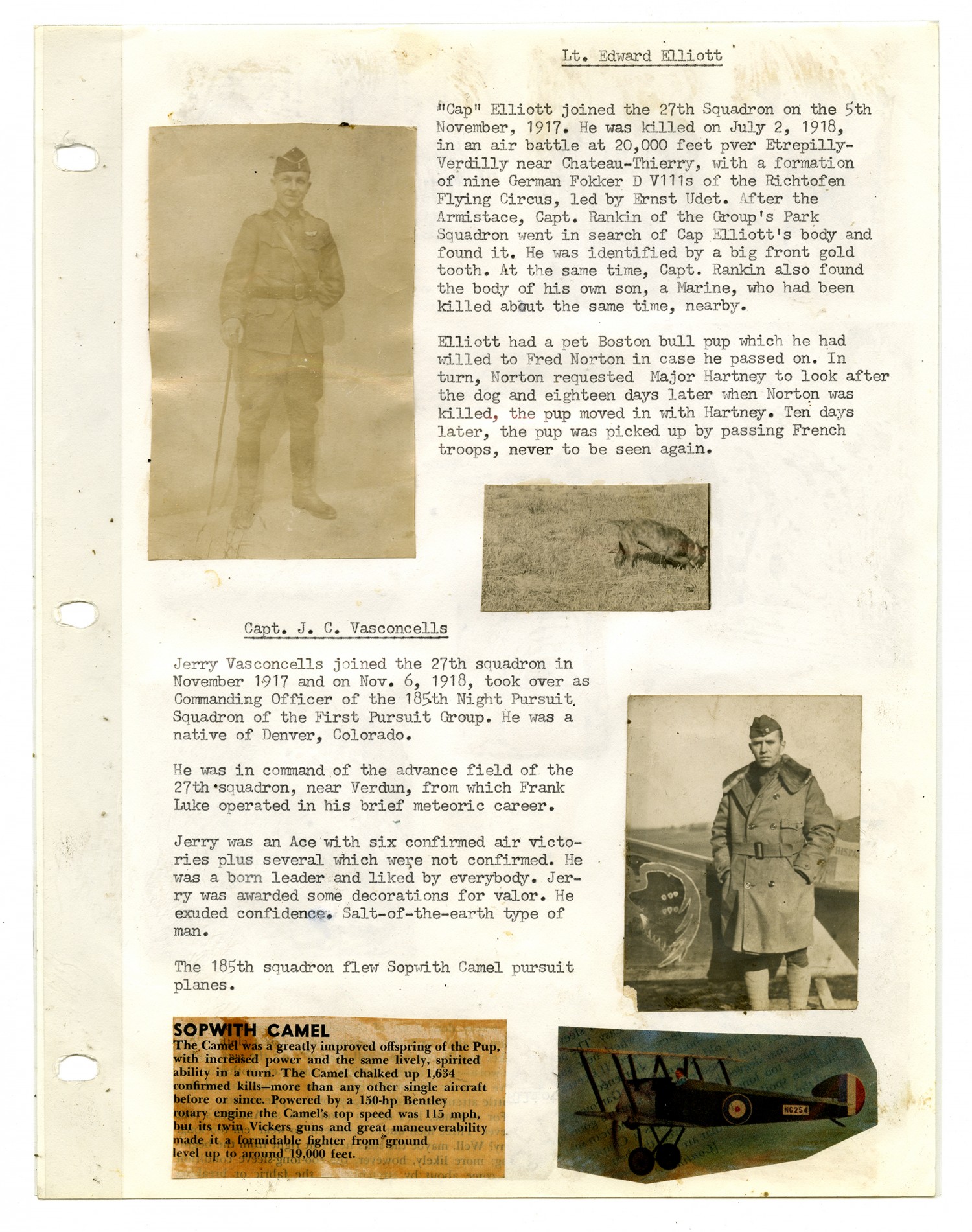
Transcript
Lt. Edward Elliott
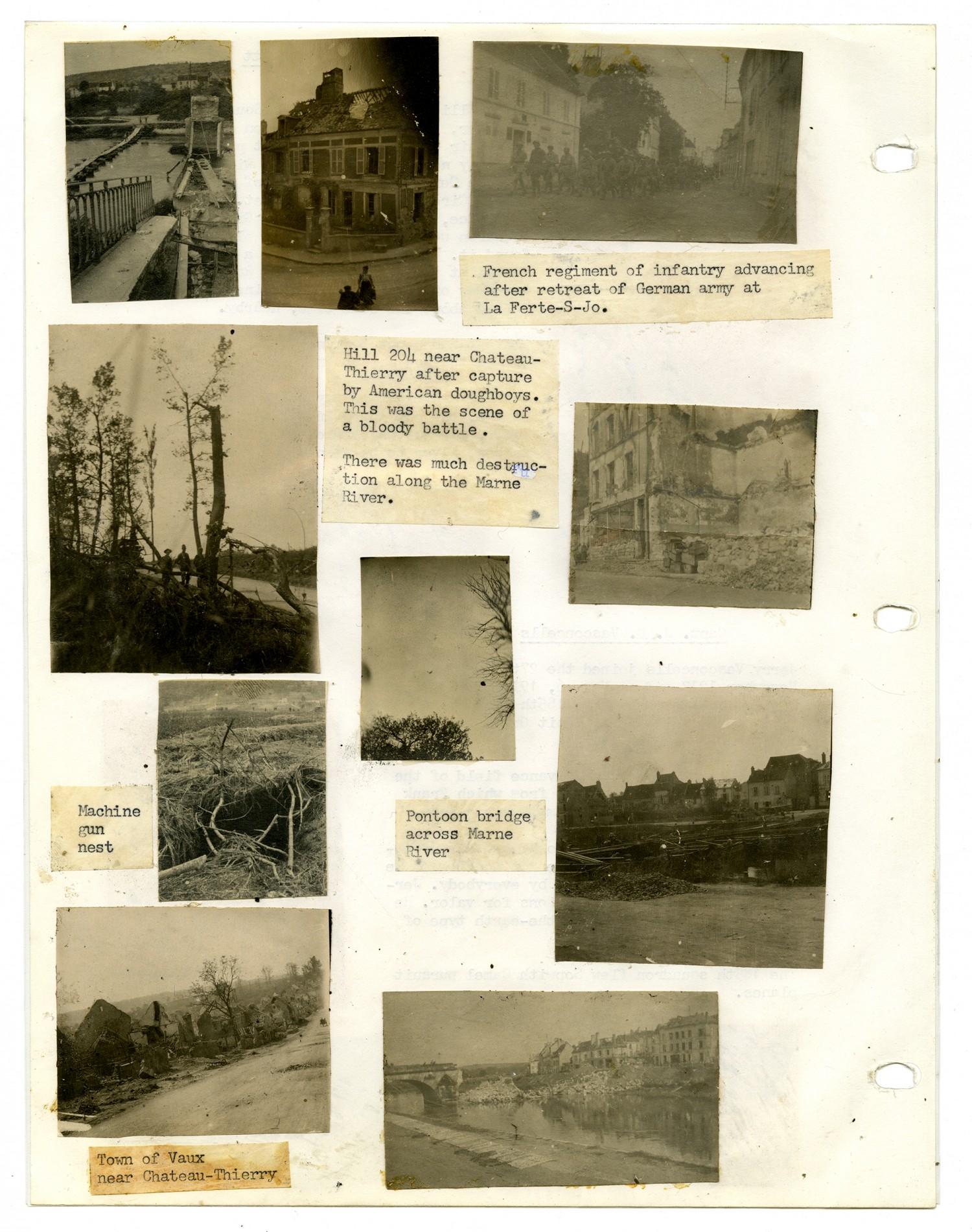
Transcript
[1st row right photograph] French regiment of infantry advancing after retreat of German army at La Ferte-S-Jo. [2nd row left photograph] Hill 204 near Chateau-Thierry after capture by American doughboys. This was the scene of a bloody battle. There was much destruction along the Marne River. [3rd row left photograph] Machine gun nest [3rd row right photograph] Pontoon bridge across Marne River [4th row left photograph] Town of Vaux near Chateau-Thierry

Transcript
Lt. O. T. Beauchamp Beauchamp joined the 27th Squadron on July 23, 1918. He was killed on August 1, 1918. His total elapsed time at the Front was exactly 9 days. He was a good flier and a likable, personable, unpretentious chap. At the Chateau Thierry front the German Air Force was strong and outnumbered us by almost 6 to 1. We lost 6 pilots that day
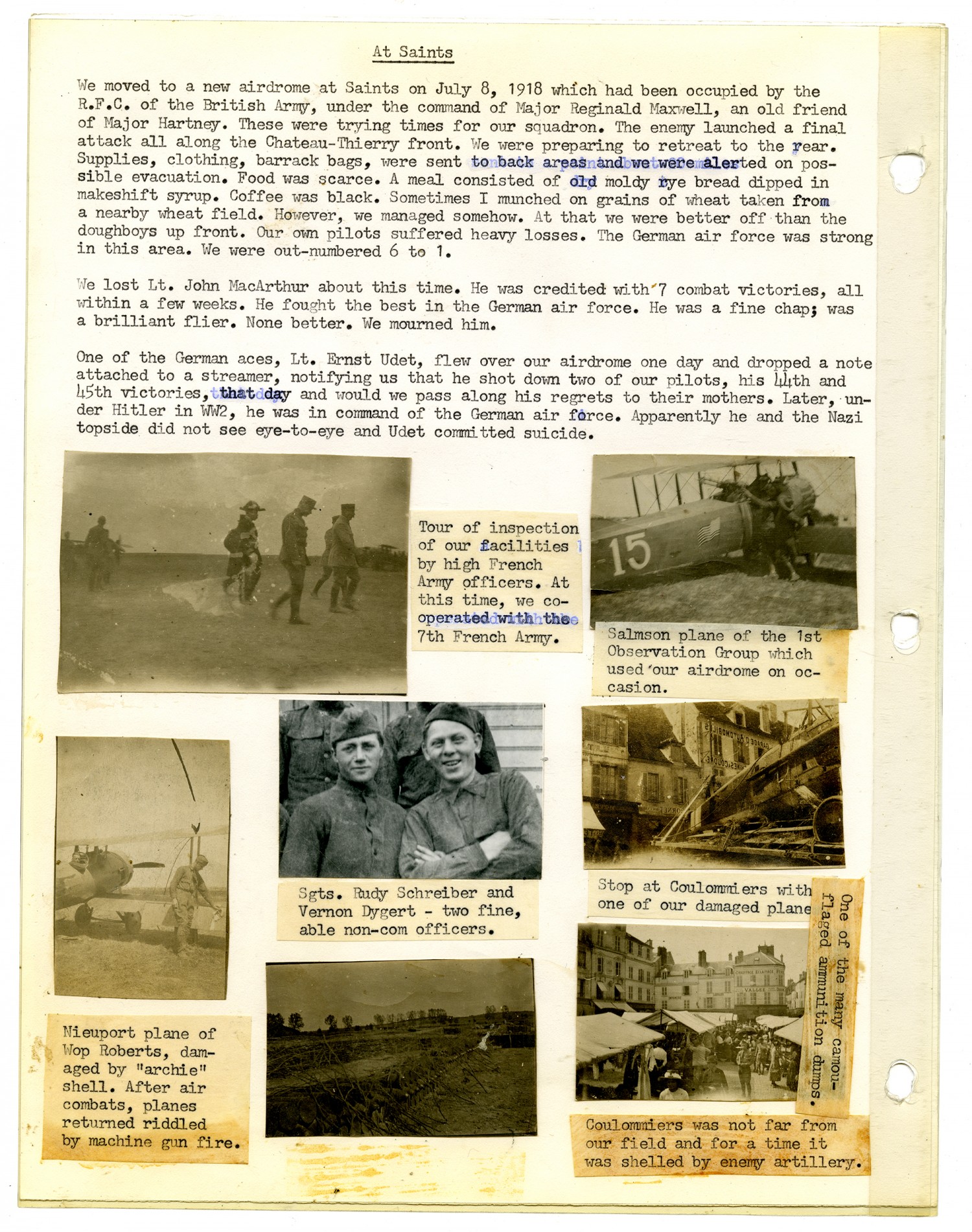
Transcript
At Saints We moved to a new airdrome at Saints on July 8, 1918 which had been occupied by the R.F.C. of the British Army, under the command of Major Reginald Maxwell, an old friend of Major Hartney. These were trying times for our squadron. The enemy launched a final attack all along the Chateau-Thierry front. We were preparing to retreat to the rear. Supplies, clothing, barrack bags, were sent to back areas and we were alerted on possible evacuation. Food was scarce. A meal consisted of old moldy rye bread dipped in makeshift syrup. Coffee was black. Sometimes I munched on grains of wheat taken from a nearby wheat field. However, we managed somehow. At that we were better off than the doughboys up front. Our own pilots suffered heavy losses. The German air force was strong in this area. We were out-numbered 6 to 1. We lost Lt. John MacArthur about this time. He was credited with 7 combat victories, all within a few weeks. He fought the best in the German air force. He was a fine chap; was a brilliant flier. None better. We mourned him. One of the German aces, Lt. Ernst Udet, flew over our airdrome one day and dropped a note attached to a streamer, notifying us that he shot down two of our pilots, his 44th and 45th victories, that day and would we pass along his regrets to their mothers. Later, under Hitler in WW2, he was in command of the German air force. Apparently he and the Nazi topside did not see eye-to-eye and Udet committed suicide. [1st row left photograph] Tour of inspection of our facilities by high French Army officers. At this time, we cooperated with the 7th French Army. [1st row right photograph] Salmson plane of the 1st Observation Group which used our airdrome on occasion. [2nd row left photograph] Nieuport plane of Wop Roberts, damaged by
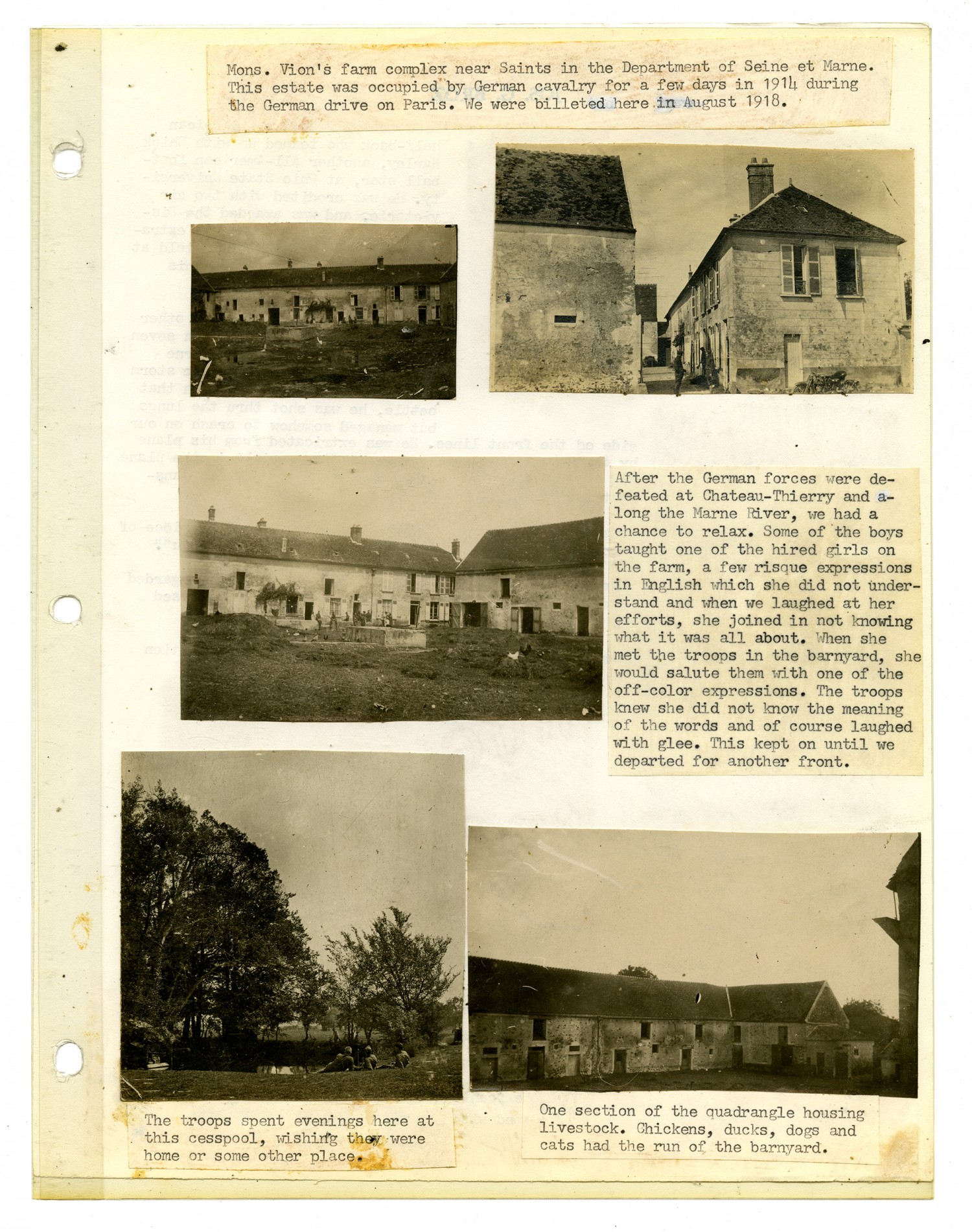
Transcript
[1st row photographs] Mons. Vion

Transcript
[1st row left photograph] Lt. Fred W. Norton of Columbus, Ohio and Cannon-ball Joe Nash, on motorcycle, of Fort Wayne, Indiana. Cannon-ball was a dispatch-rider and a good one. Lt. Fred W. Norton Fred Norton was an All-American half-back who teamed up with Chick Harley, another All-American football star, at Ohio State University. He was credited with two air victories and was awarded the Distinguished Service Cross from extraordinary valor. The Norton Field at Columbus, Ohio was named in his honor. On July 20, 1918, he and two other pilots, in an air battle with seven enemy Albatrosses, on the Marne front, were blown by a severe storm far into German territory. In that battle, he was shot thru the lungs but managed somehow to crash on our side of the front lines. He was extricated from his plane by American infantrymen after spending a night in the plane and died a day later, from pneumonia, while being transported in a truck, to a hospital. Just before he died, he scribbled five words on a piece of paper which read
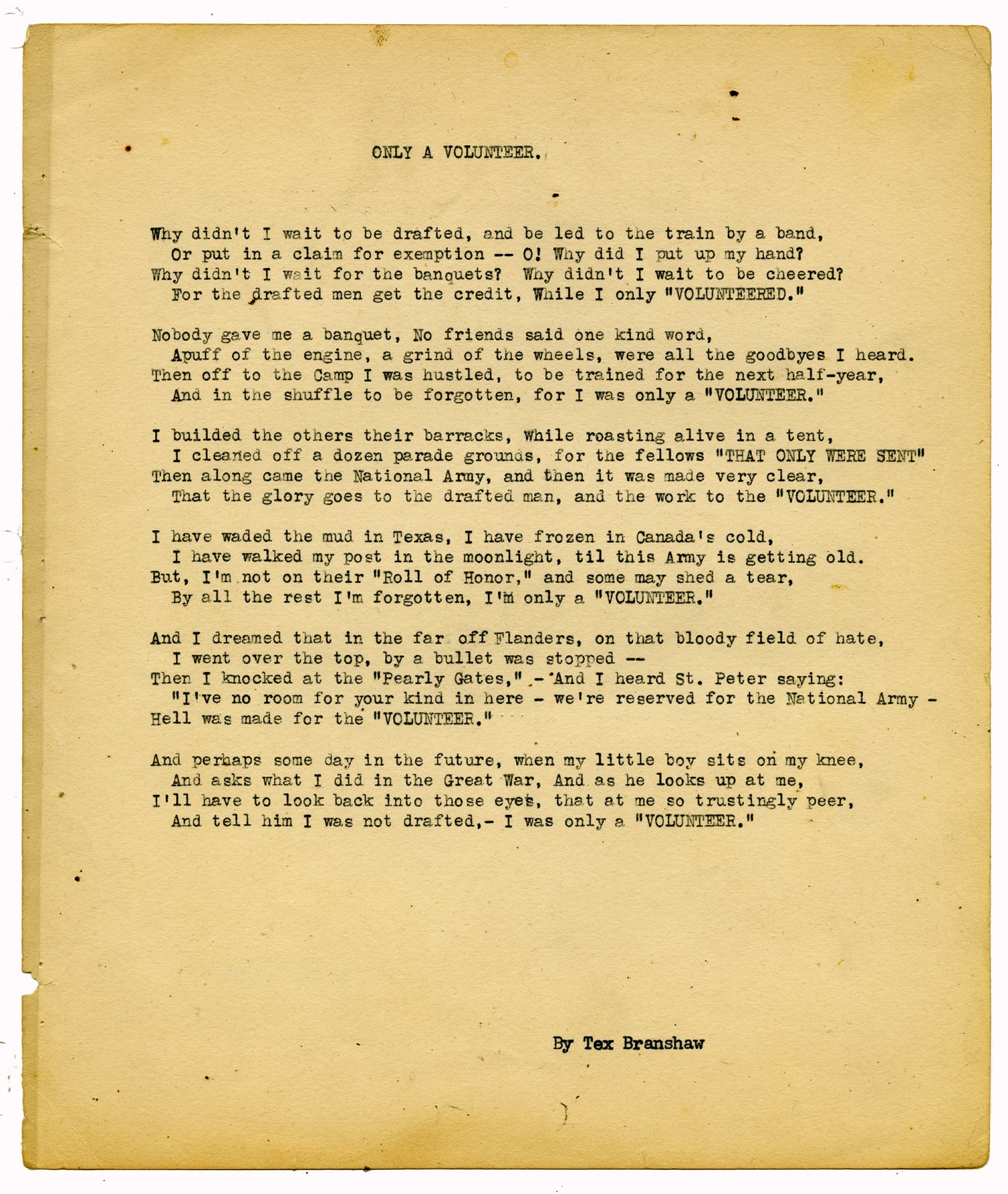
Transcript
ONLY A VOLUNTEER. Why didn
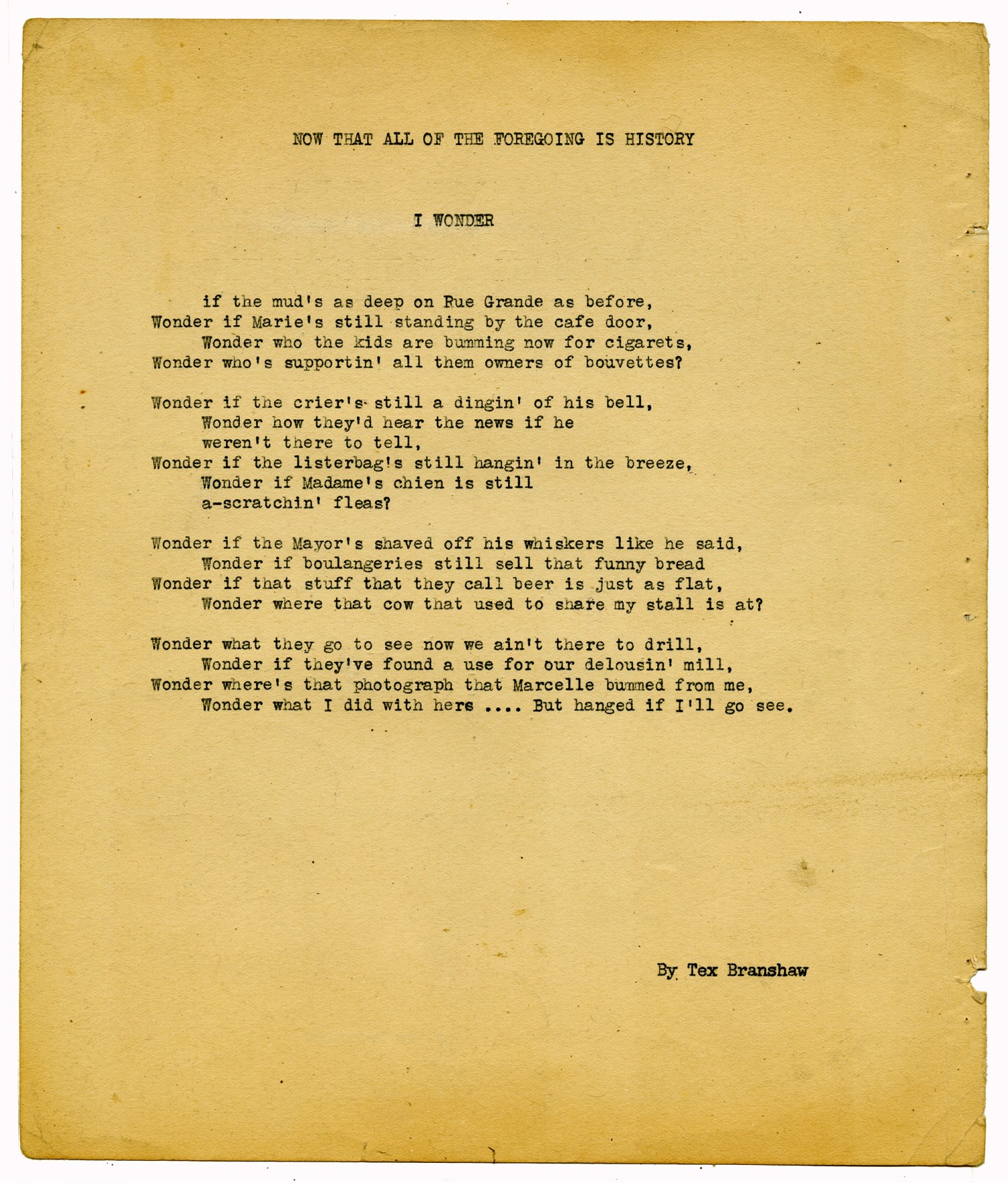
Transcript
NOW THAT ALL OF THE FOREGOING IS HISTORY I WONDER if the mud

Transcript
On the Marne River Front
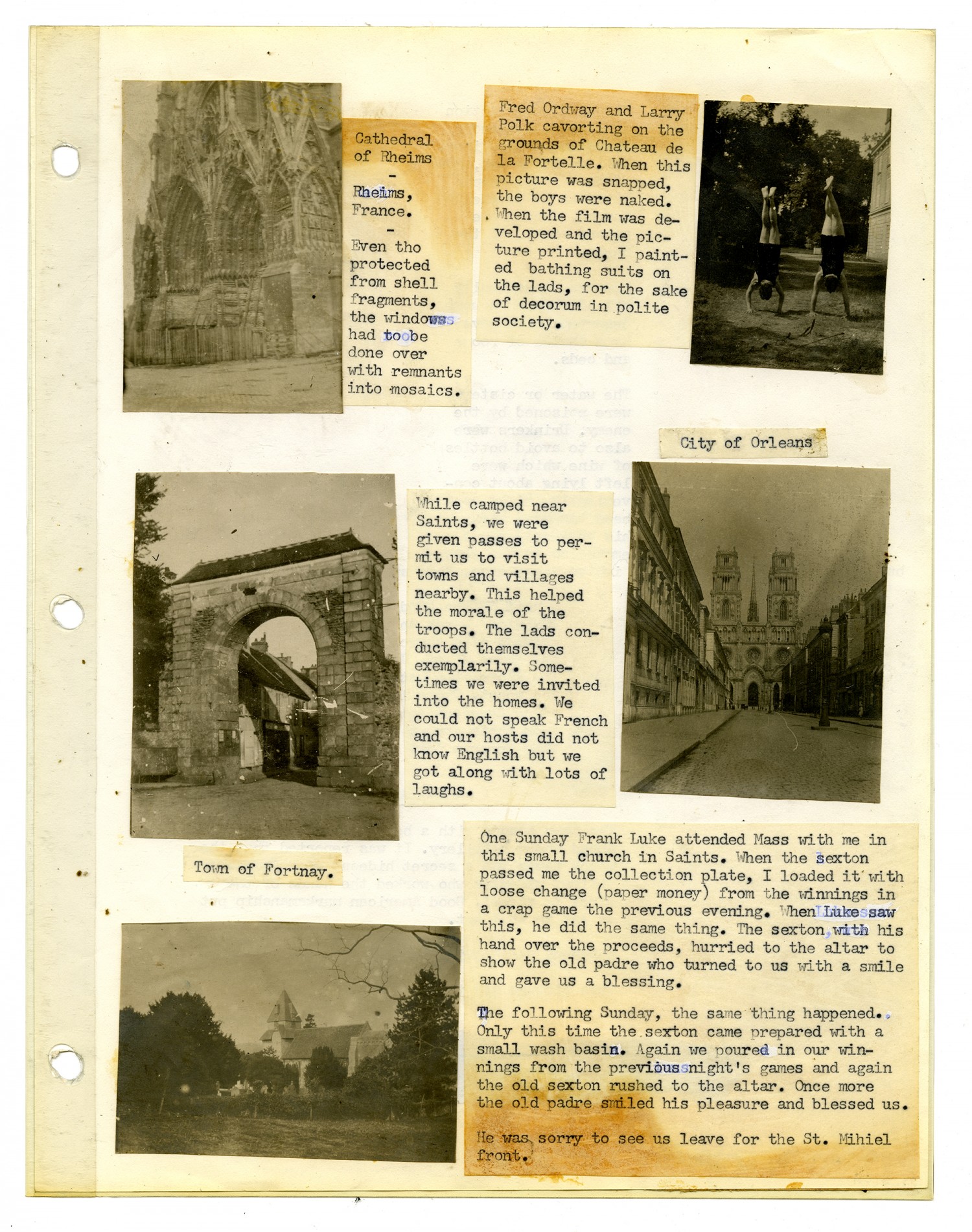
Transcript
[1st row left photograph] Cathedral of Rheims Rheims, France. Even tho protected from shell fragments, the windows had to be done over with remnants into mosaics. [1st row right photograph] Fred Ordway and Larry Polk cavorting on the grounds of Chateau de la Fortelle. When this picture was snapped, the boys were naked. When the film was developed and the picture printed, I painted bathing suits on the lads, for the sake of decorum in polite society. While camped near Saints, we were given passes to permit us to visit towns and villages nearby. This helped the morale of the troops. The lads conducted themselves exemplarily. Sometimes we were invited into the homes. We could not speak French and our hosts did not know English but we got along with lots of laughs. [2nd row left photograph] Town of Fortnay. [2nd row right photograph] City of Orleans [3rd row left photograph] One Sunday Frank Luke attended Mass with me in this small church in Saints. When the sexton passed me the collection plate, I loaded it with loose change (paper money) from the winnings in a crap game the previous evening. When Luke saw this, he did the same thing. The sexton with his hand over the proceeds, hurried to the altar to show the old padre who turned to us with a smile and gave us a blessing. The following Sunday, the same thing happened. Only this time the sexton came prepared with a small wash basin. Again we poured in our winnings from the previous night
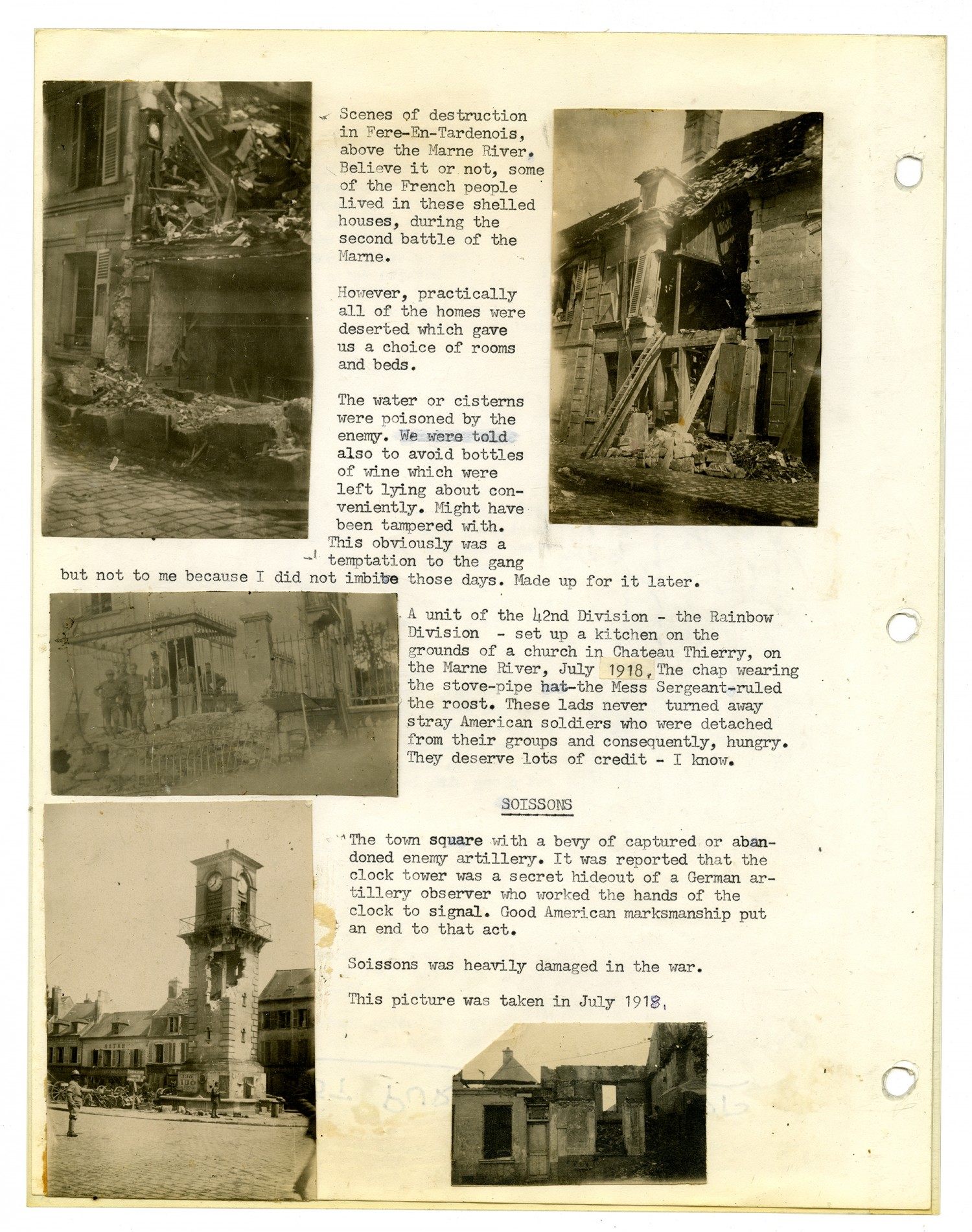
Transcript
[1st row photographs] Scenes of destruction in Fere-En-Tardenois, above the Marne River. Believe it or not, some of the French people lived in these shelled houses, during the second battle of the Marne. However, practically all of the homes were deserted which gave us a choice of rooms and beds. The water or cisterns were poisoned by the enemy. We were told also to avoid bottles of wine which were left lying about conveniently. Might have been tampered with. This obviously was a temptation to the gang but not to me because I did not imbibe those days. Made up for it later. [2nd row left photograph] A unit of the 42nd Division
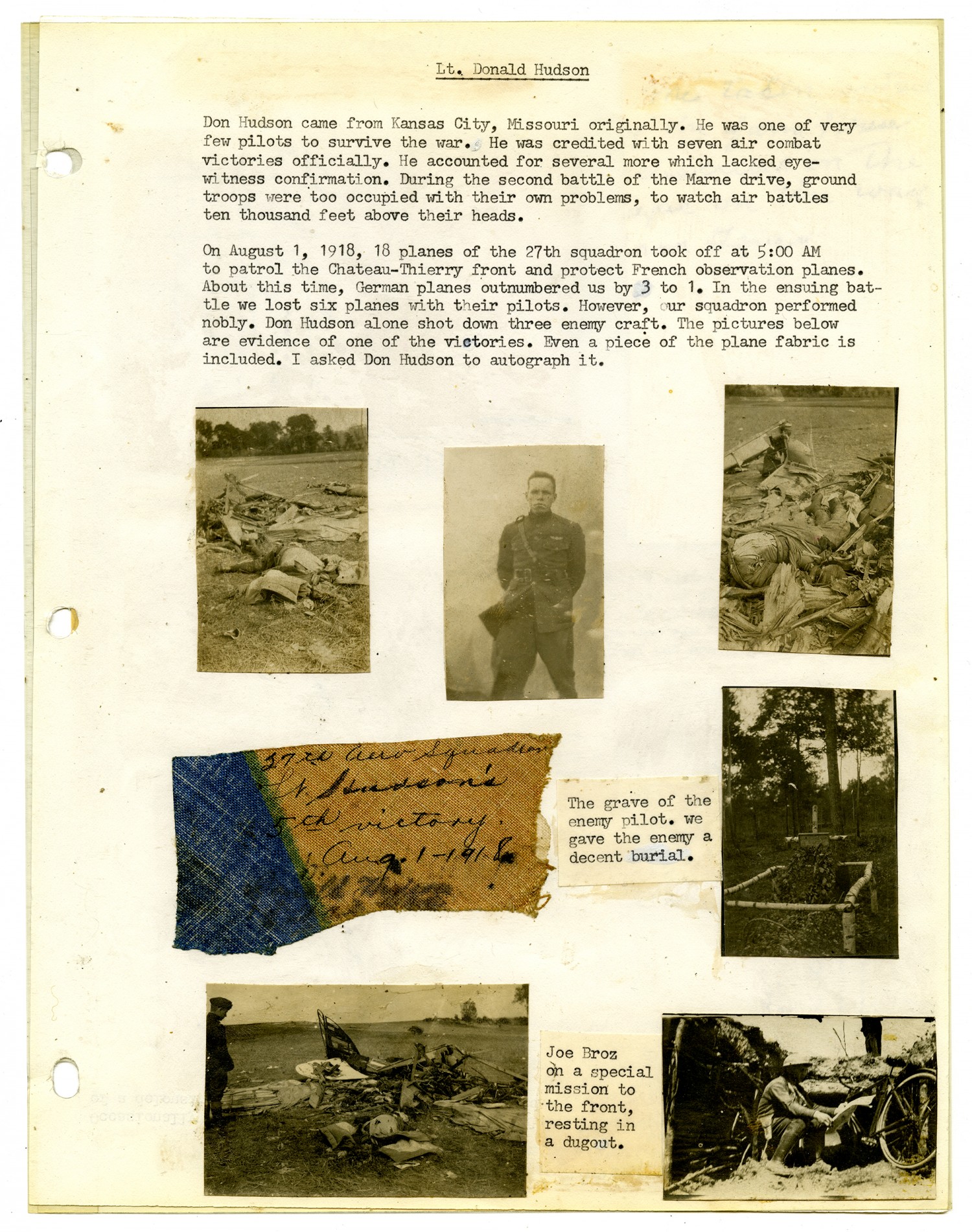
Transcript
Lt. Donald Hudson Don Hudson came from Kansas City, Missouri originally. He was one of very few pilots to survive the war. He was credited with seven air combat victories officially. He accounted for several more which lacked eyewitness confirmation. During the second battle of the Marne drive, ground troops were too occupied with their own problems, to watch air battles ten thousand feet above their heads. On August 1, 1918, 18 planes of the 27th squadron took off at 5:00 AM to patrol the Chateau-Thierry front and protect French observation planes. About this time, German planes outnumbered us by 3 to 1. In the ensuing battle we lost six planes with their pilots. However, our squadron performed nobly. Don Hudson alone shot down three enemy craft. The pictures below are evidence of one of the victories. Even a piece of the plane fabric is included. I asked Don Hudson to autograph it. [2nd row right photograph] The grave of the enemy pilot. we gave the enemy a decent burial. [3rd row right photograph] Joe Broz on a special mission to the front, resting in a dugout.

Transcript
[1st row left photograph] Tom Harvey of Vallejo, [California] Everybody liked Tom. Always willing to lend a helping hand. Tom was heartbroken when some doughboys stole
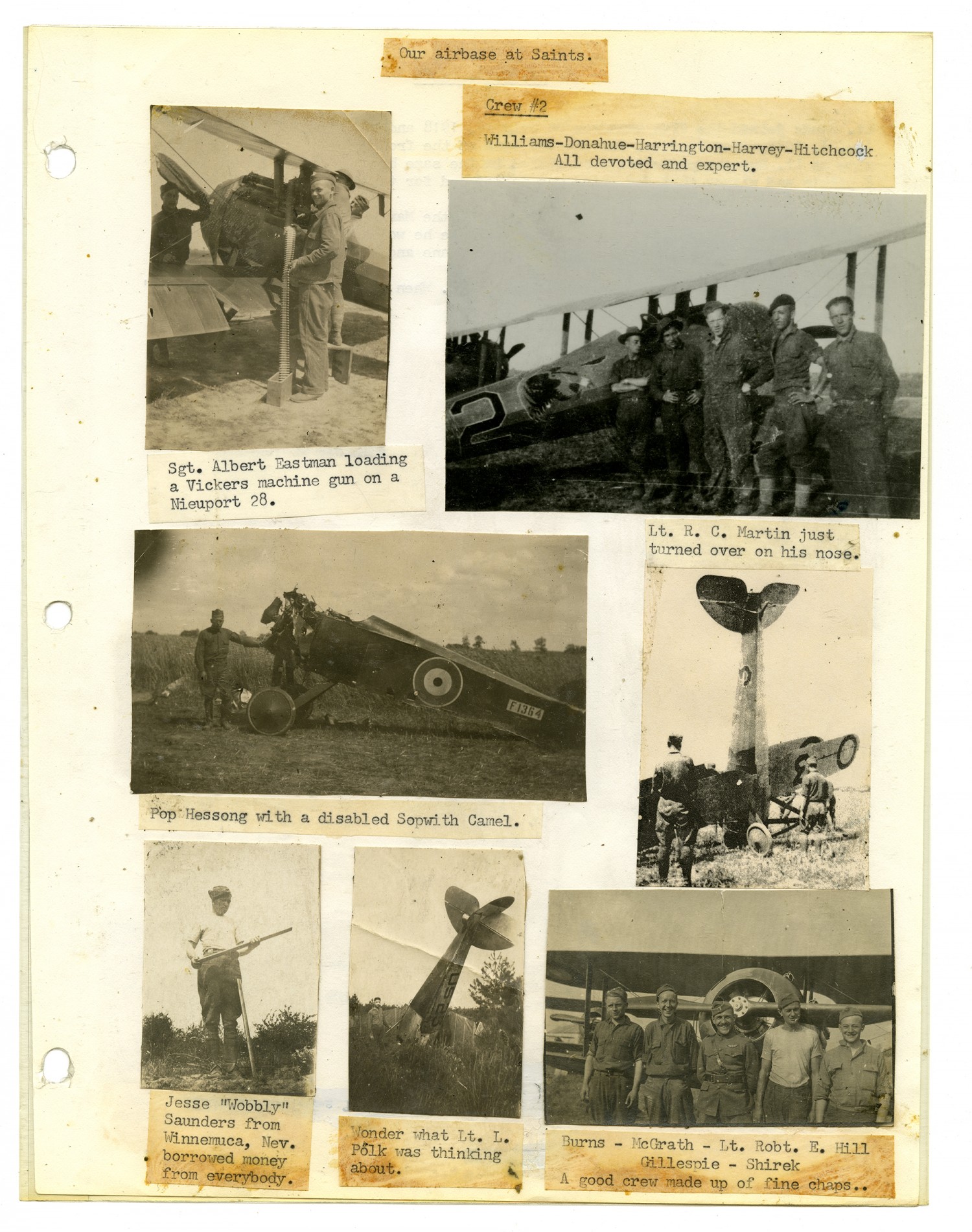
Transcript
Our airbase at Saints. [1st row left photograph] Sgt. Albert Eastman loading a Vickers machine gun on a Nieuport 28. [1st row right photograph] Crew #2 Williams-Donahue-Harrington-Harvey-Hitchcock All devoted and expert. [2nd row left photograph] Pop Hessong with a disabled Sopwith Camel. [2nd row right photograph] Lt. R. C. Martin just turned over on his nose. [3rd row left photograph] Jesse

Transcript
Lt. C. B. Sands Lt. Sands joined the 27th squadron on July 25, 1918 and was killed in combat on [August] 1, 1918, over Saponay. His elapsed times at the front was only 9 days, the same as Lt. Beauchamp who was killed in the same battle. The squadron lost 6 pilots and planes that day which was indeed sad for the squadron. After Lt. Sands landed in the wheat field along the Marne River near Chateau-Thierry, he no doubt was mortally wounded or else he would have attempted to get out of his plane. Enemy artillery spotted his plane and damaged it-shell fire. We organized a rescue party to salvage the plane. When we arrived there, Lt. Sands

Transcript
Change of Command
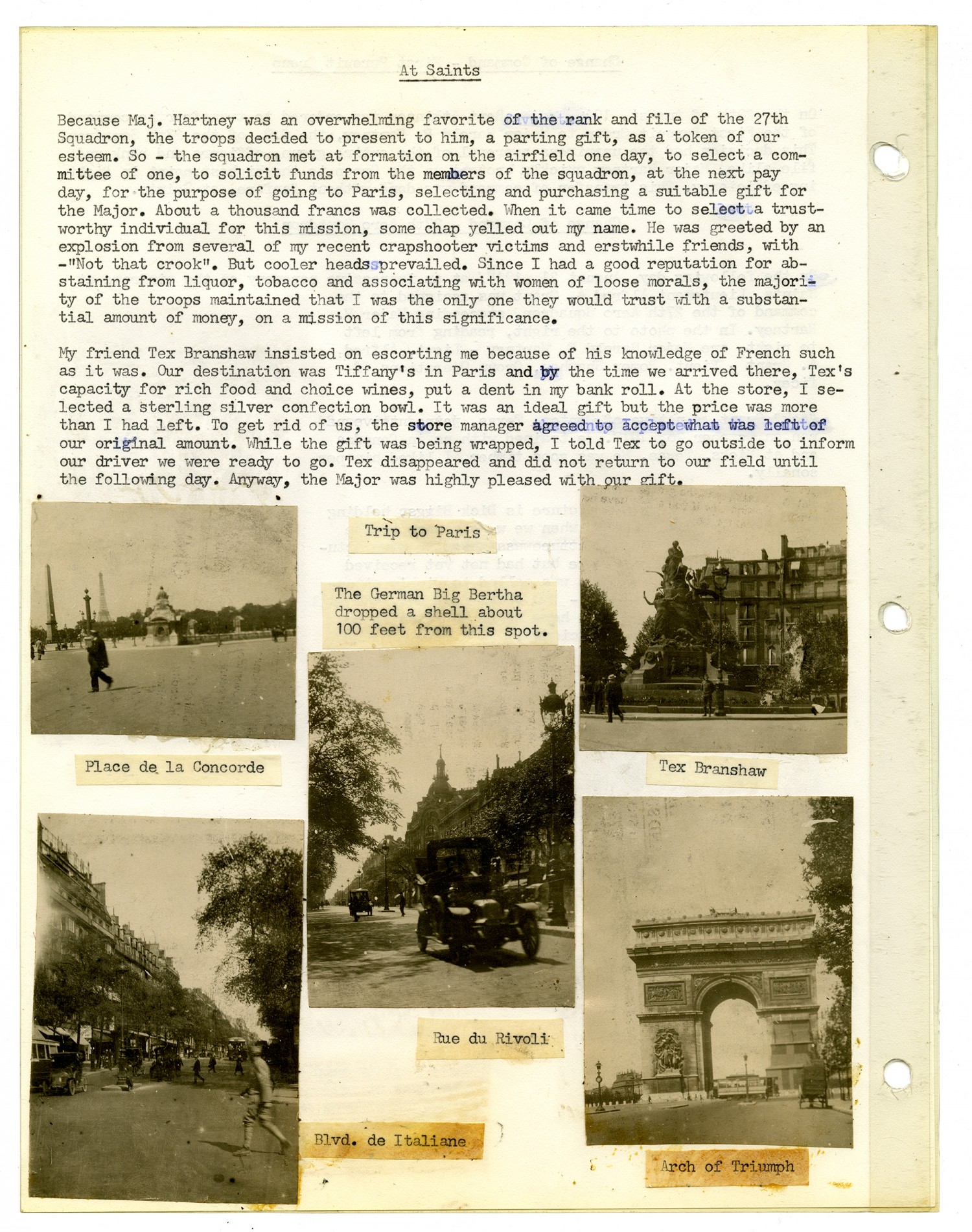
Transcript
At Saints Because Maj. Hartney was an overwhelming favorite of the rank and file of the 27th Squadron, the troops decided to present to him, a parting gift, as a token of our esteem. So

Transcript
Still at Saints The latter part of the month of August, 1918, was tranquil along the Western Front. The enemy was driven back and in retreat. German aerial activity was sporadic and definitely defensive. This gave us a chance to re-group and work with eleven new replacement pilots who had just joined the squadron. They spent much of their time in the air, practicing acrobatics, mock combat tactics, familiarizing themselves with the countryside and landmarks and increasing their proficiency in take-offs and landings. After all, this was a small tricky field. Two of the new pilots were Lt. Frank Luke, Jr. and Lt. Joseph Wehner. Much will be heard from and of the two fliers shortly. They were eager, excellent pilots and often performed mock air duels at low altitudes, over our field. Luke was impetuous whereas Wehner was calculating. They made a perfect team. One day the engine in Luke
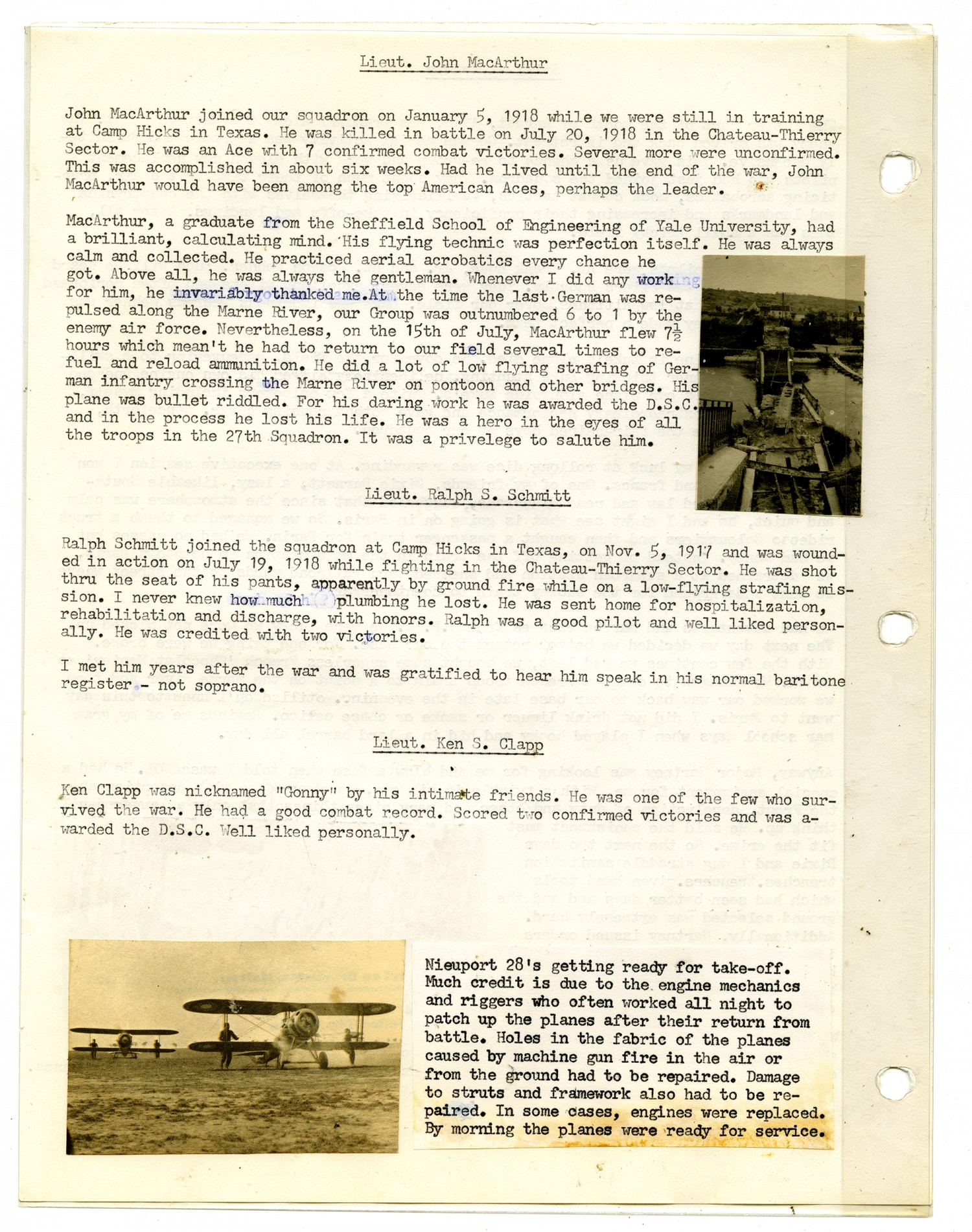
Transcript
Lieut. John MacArthur John MacArthur joined our squadron on January 5, 1918 while we were still in training at Camp Hicks in Texas. He was killed in battle on July 20, 1918 in the Chateau-Thiery Sector. He was an Ace with 7 confirmed combat victories. Several more were unconfirmed. This was accomplished in about six weeks. Had he lived until the end of the war, John MacArthur would have been among the top American Aces, perhaps the leader. MacArthur, a graduate from the Sheffield School of Engineering of Yale University, had a brilliant, calculating mind. His flying technic was perfection itself. He was always calm and collected. He practiced aerial acrobatics every chance he got. Above all, he was always the gentleman. Whenever I did any work for him, he invariably thanked me. At the time the last German was repulsed along the Marne River, our Group was outnumbered 6 to 1 by the enemy air force. Nevertheless, on the 15th of July, MacArthur flew 7
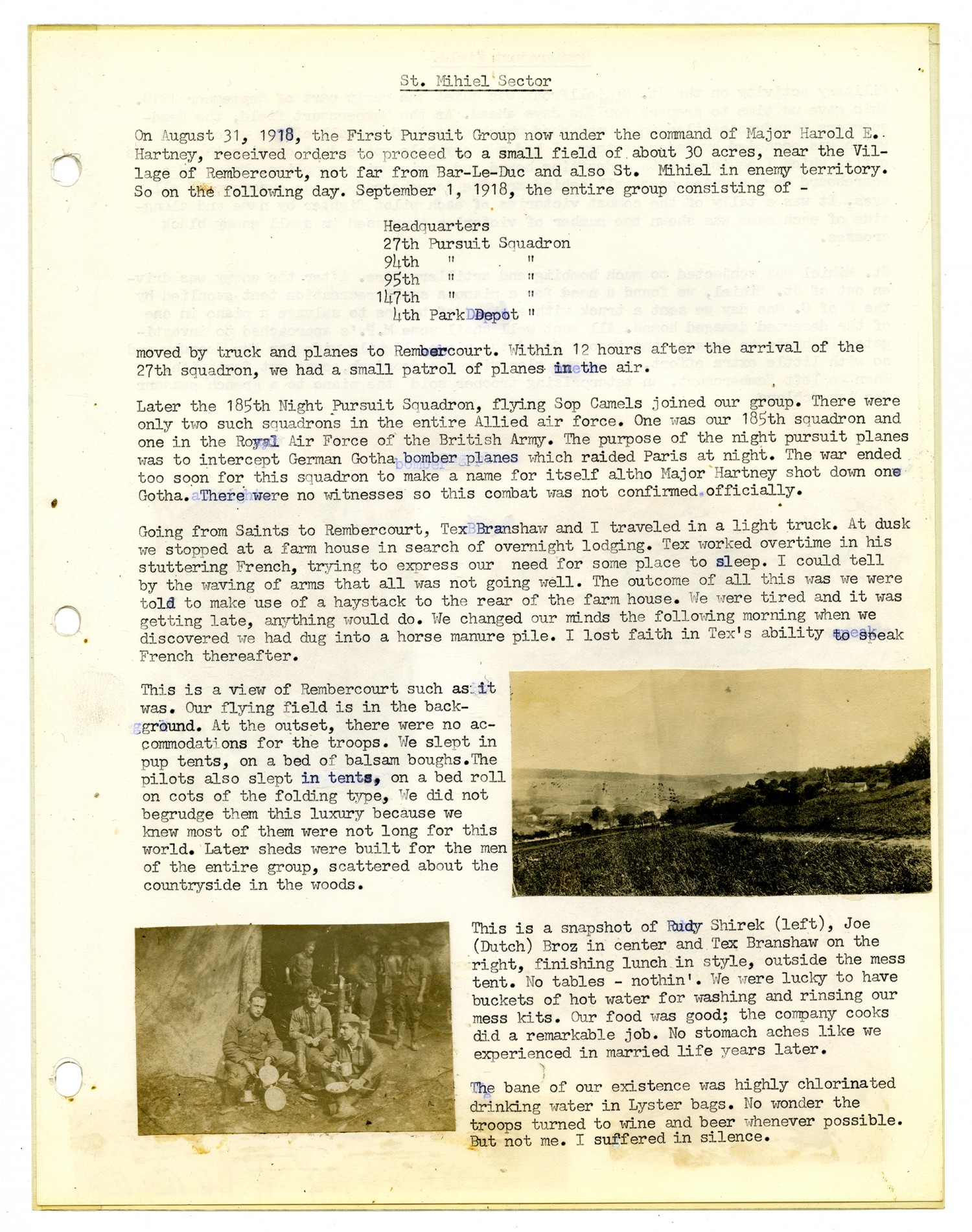
Transcript
St. Mihiel Sector On August 31, 1918, the First Pursuit Group now under the command of Major Harold E. Hartney, received orders to proceed to a small field of about 30 acres, near the Village of Rembercourt, not far from Bar-Le-Duc and also St. Mihiel in enemy territory. So on the following day. September 1, 1918, the entire group consisting of
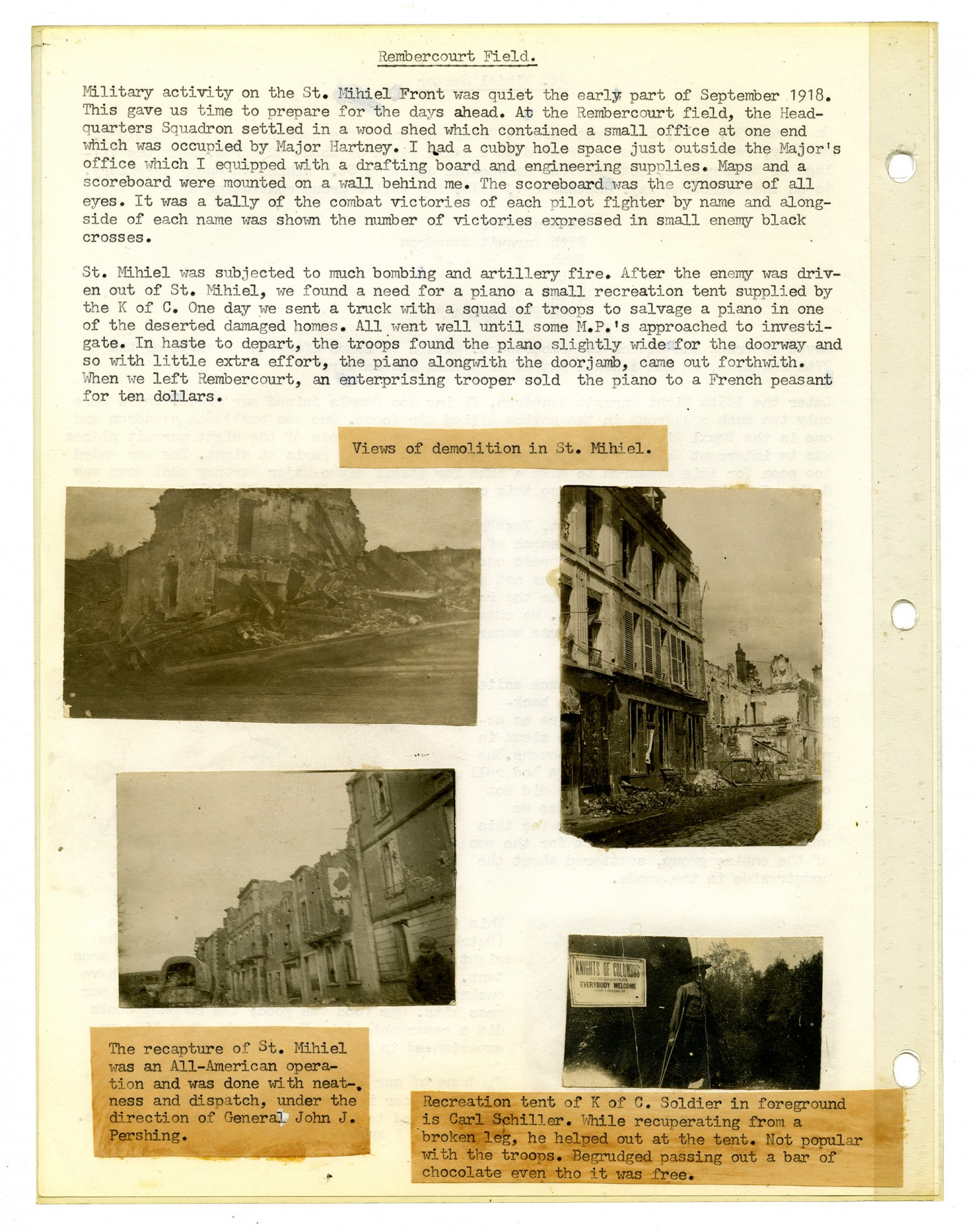
Transcript
Rembercourt Field. Military activity on the St. Mihiel Front was quiet the early part of September 1918. This gave us time to prepare for the days ahead. At the Rembercourt field, the Headquarters Squadron settled in a wood shed which contained a small office at one end which was occupied by Major Hartney. I had a cubby hole space just outside the Major
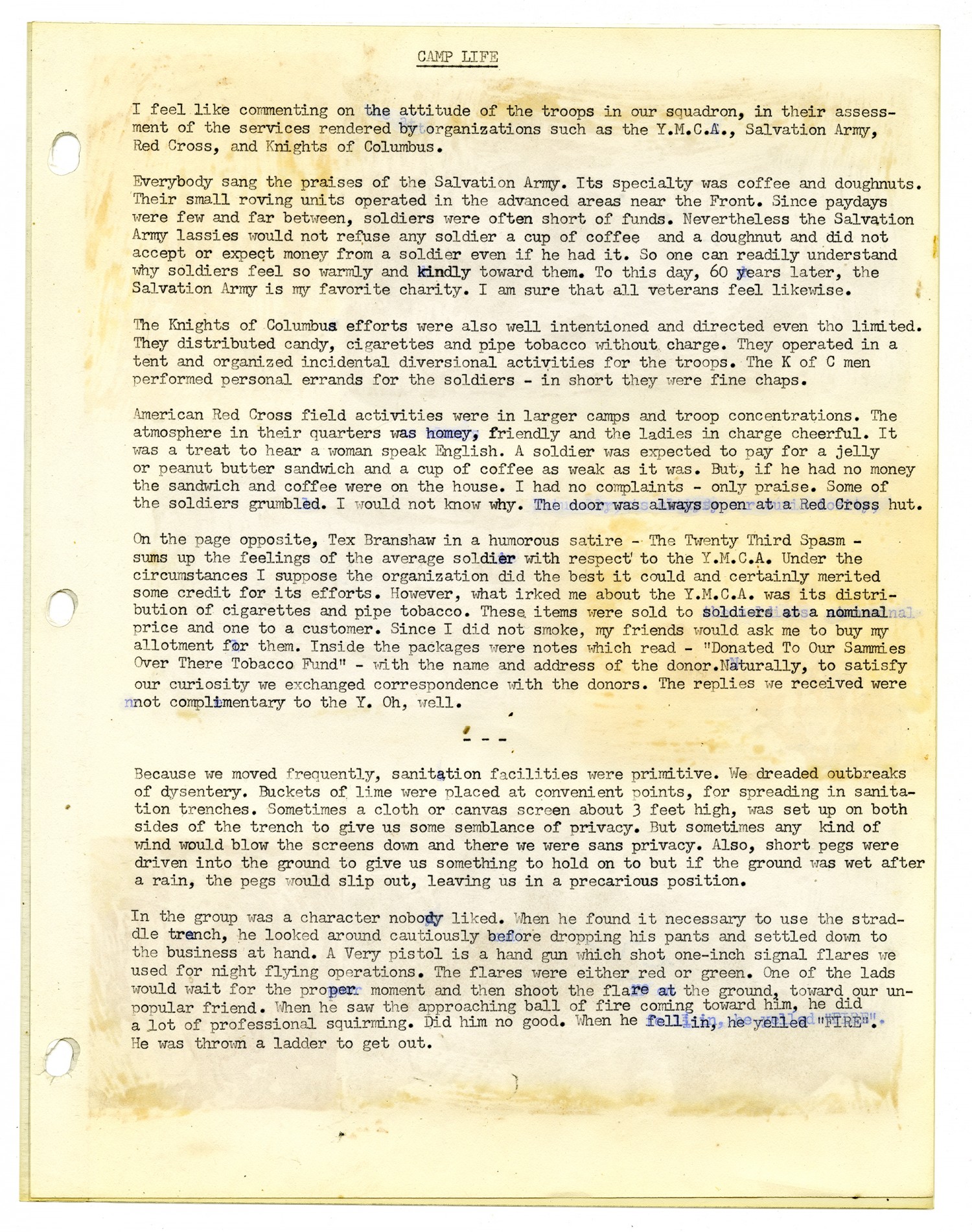
Transcript
CAMP LIFE I feel like commenting on the attitude of the troops in our squadron, in their assessment of the services rendered by organizations such as the Y.M.C.A., Salvation Army, Red Cross, and Knights of Columbus. Everybody sang the praises of the Salvation Army. Its specialty was coffee and doughnuts. Their small roving units operated in the advanced areas near the Front. Since paydays were few and far between, soldiers were often short of funds. Nevertheless the Salvation Army lassies would not refuse any soldier a cup of coffee and a doughnut and did not accept or expect money from a soldier even if he had it. So one can readily understand why soldiers feel so a warmly and kindly toward them. To this day, 60 years later, the Salvation Army is my favorite charity. I am sure that all veterans feel likewise. The Knights of Columbus efforts were also well intentioned and directed even tho limited. They distributed candy, cigarettes and pipe tobacco without charge. They operated in a tent and organized incidental diversional activities for the troops. The K of C men performed personal errands for the soldiers
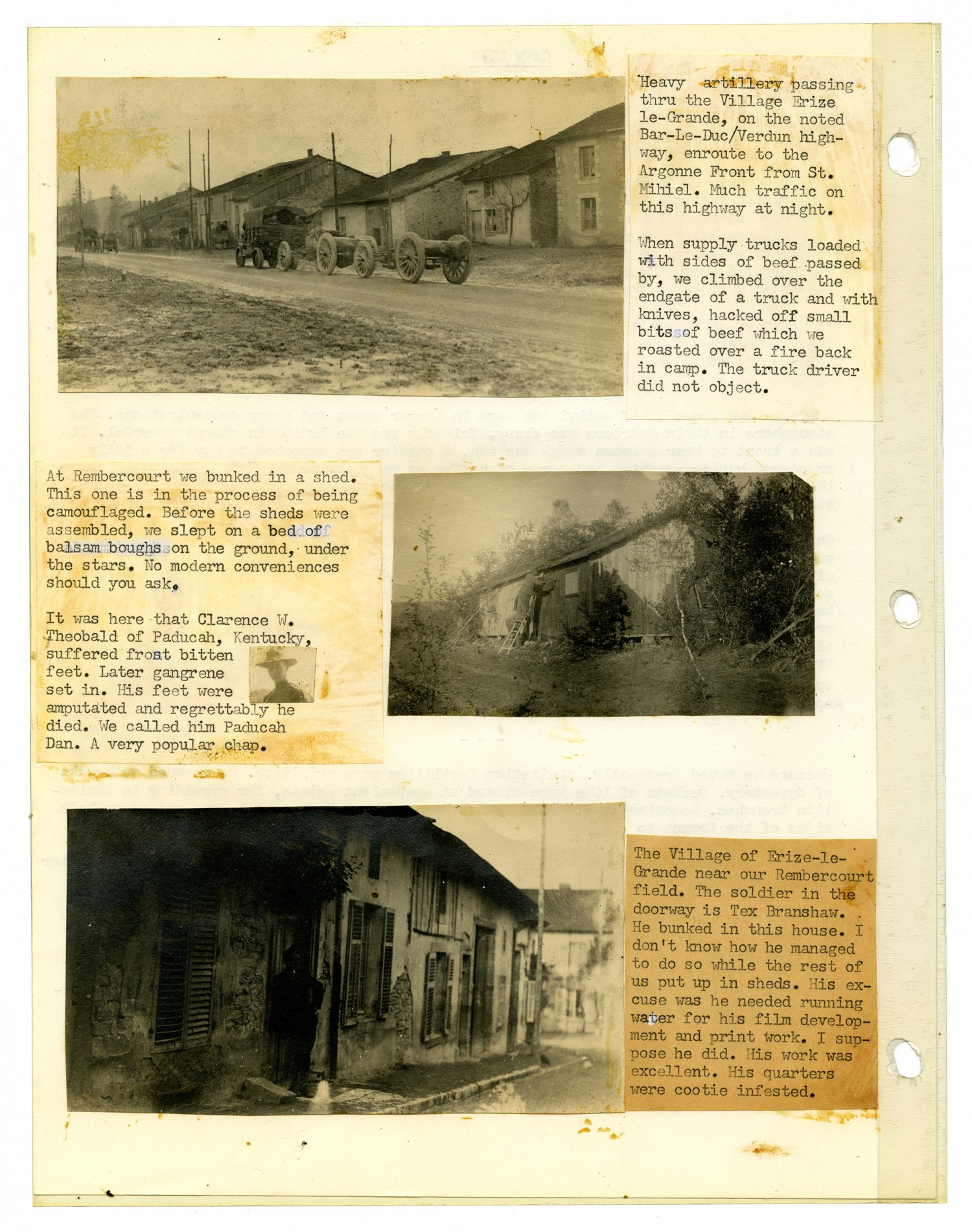
Transcript
[Top left photograph] Heavy artillery passing thru the Village Erize le-Grande, on the noted Bar-Le-Duc/Verdun highway, enroute to the Argonne Front from St. Mihiel. Much traffic on this highway at night. When supply trucks loaded with sides of beef passed by, we climbed over the endgate of a truck and with knives, hacked off small bits of beef which we roasted over a fire back in camp. The truck driver did not object. [Center right photograph] At Rembercourt we bunked in a shed. This one is in the process of being camouflaged. Before the sheds were assembled, we slept on a bed of balsam boughs on the ground, under the stars. No modern conveniences should you ask. It was here that Clarence W. Theobald of Paducah, Kentucky, suffered frost bitten feet. Later gangrene set in. His feet were amputated and regrettably he died. We called him Paducah Dan. A very popular chap. [Bottom left photograph] The Village of Erize-le-Grande near our Rembercourt field. The soldier in the doorway is Tex Branshaw. He bunked in this house. I don
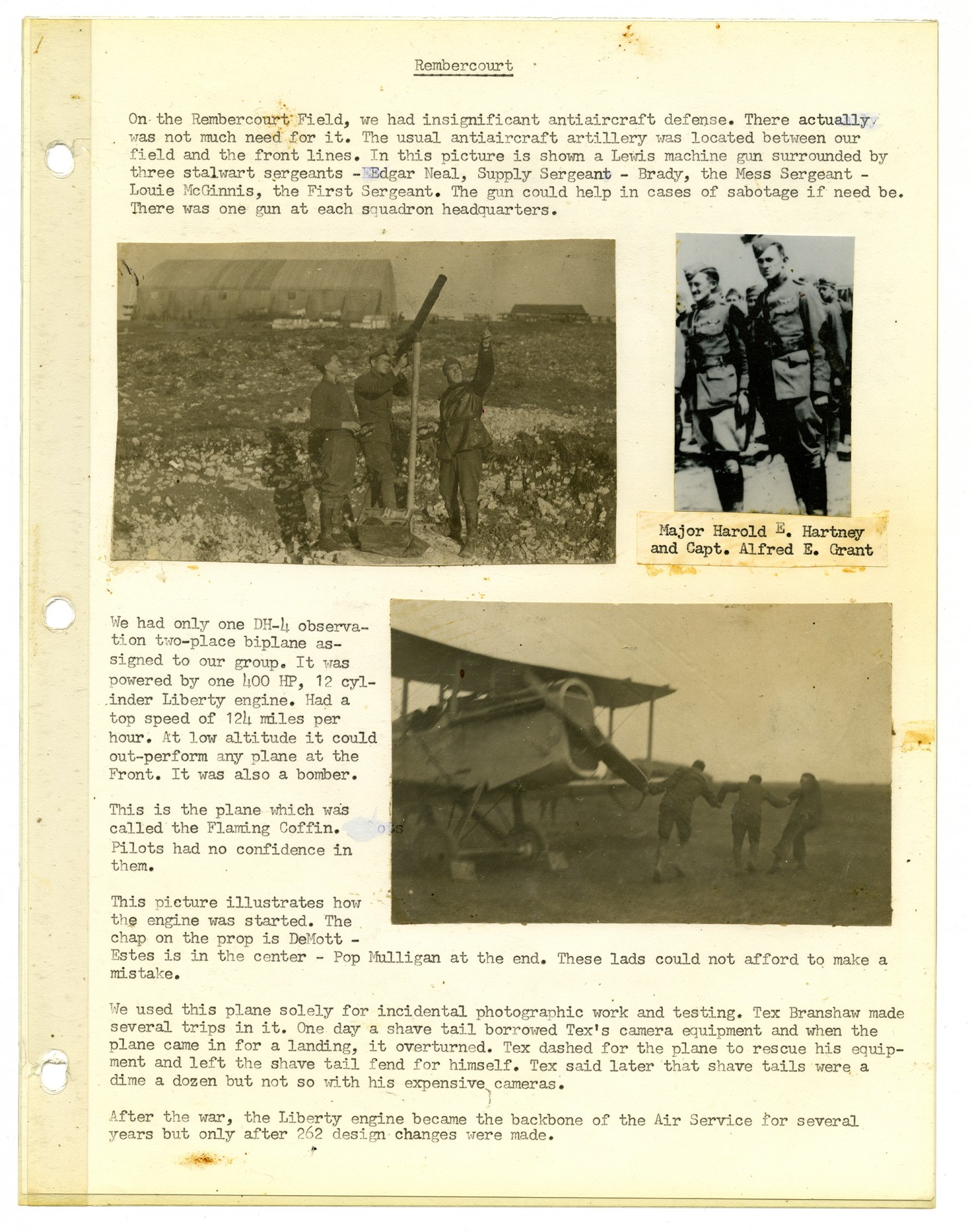
Transcript
Rembercourt On the Rembercourt Field, we had insignificant antiaircraft defense. There actually was not much need for it. The usual antiaircraft artillery was located between our field and the front lines. In this picture is shown a Lewis machine gun surrounded by three stalwart sergeants

Transcript
Lt. Joseph F. Wehner Joe Wehner was a native of Everett, [Massachusetts] Of German descent he was followed by our Secret Service suspected of being an enemy agent. In a few days he became in his own right, a legend as the flying combat partner of Frank Luke. He joined the 27th Squadron with Frank Luke on July 25, 1918 and was killed on [September] 18, 1918, 12 days prior to the death of Luke. He was an Ace with 5 confirmed combat victories altho he actually shot down 6 balloons and 2 planes. This was accomplished in less than one week in addition to saving Frank Luke

Transcript
When I snapped this picture of a doughboy
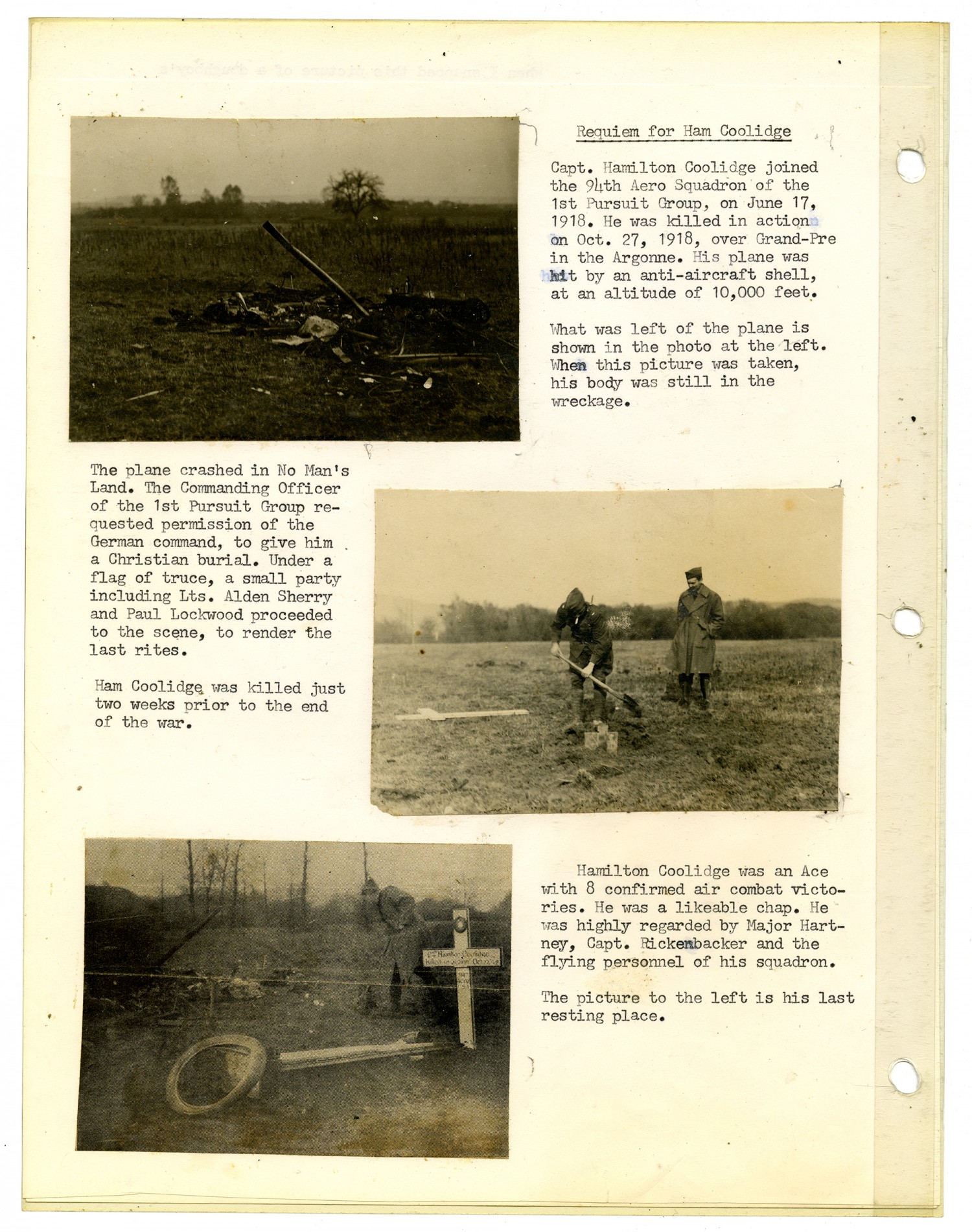
Transcript
Requiem for Ham Coolidge Capt. Hamilton Coolidge joined the 94th Aero Squadron of the 1st Pursuit Group, on June 17, 1918. He was killed in action on [October] 27, 1918, over Grand-Pre in the Argonne. His plane was hit by an anti-aircraft shell, at an altitude of 10,000 feet. [Top left photograph] What was left of the plane is shown in the photo at the left. When this picture was taken, his body was still in the wreckage. The plane crashed in No Man
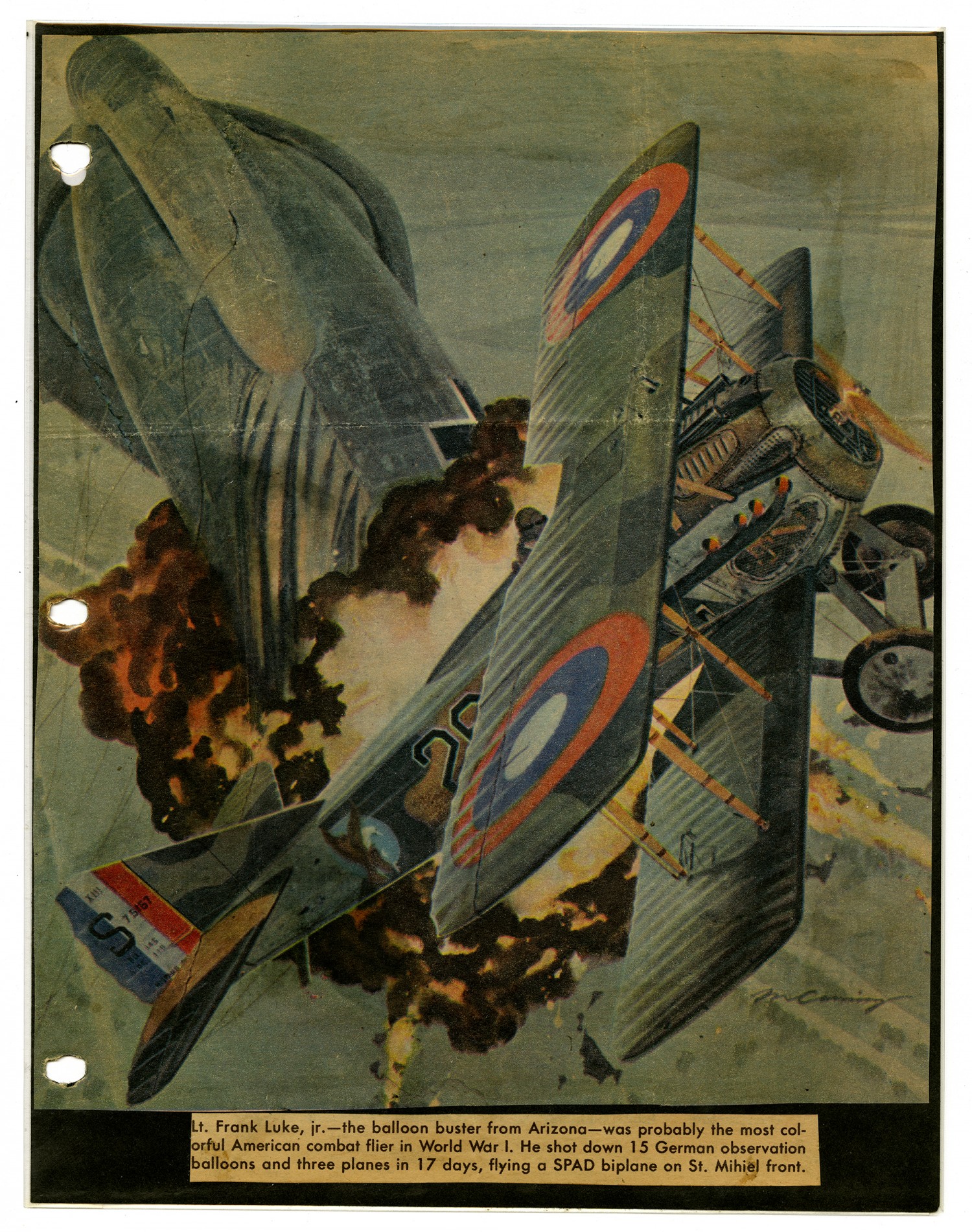
Transcript
Lt. Frank Luke, jr.-the balloon buster from Arizona-was probably the most colorful American combat flier in World War I. He shot down 15 German observation balloons and three planes in 17 days, flying a SPAD biplane on St. Mihiel front.
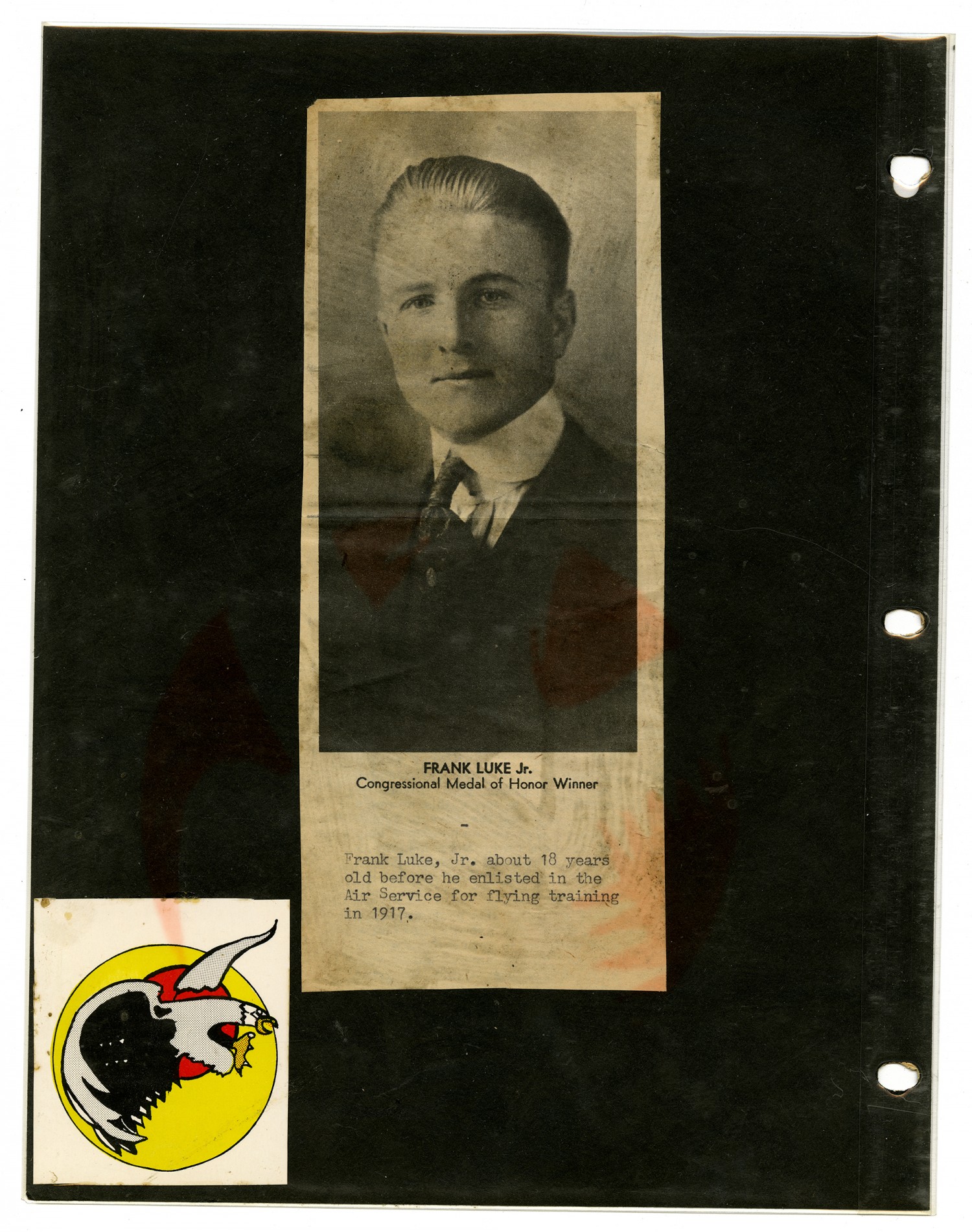
Transcript
FRANK LUKE Jr. Congressional Medal of Honor Winner

Transcript
Lt. Frank Luke, Jr. Frank Luke, Jr. of Phoenix, Arizona, joined the 27th Squadron, with the rank of 2nd lieutenant, on July 25, 1918. Approximately two months later, he was killed in action on [September] 29, 1918. 41 days after his death, he was promoted to the rank of 1st lieutenant. Frank Luke, who was but twenty years old, had the most remarkable and spectacular career in the history of aviation, chalked up 18 victories confirmed in 17 days. There were at least ten more which he reported but never confirmed. In one encounter Frank Luke shot down 3 observation balloons and two enemy planes, killed 11 infantrymen and wounded several others with hand bombs and then, altho seriously wounded, he managed to crawl out of this grounded plane and continued to defend himself with his automatic .45 pistol. He then died in enemy territory. Among other decorations he was the recipient of the Congressional Medal of Honor, the only flier so honored during the war. Eddie Rickenbacker also received this medal but this was 12 years after the Armistice. Luke was an admirer of Rickenbacker and in turn Rickenbacker told war correspondents that Frank Luke was the greatest flier that ever lived. Frank Luke was a precision flier. He and his close friend, Joe Wehner, performed acrobatics over the airdrome at Saints which were hard to believe. Both were daring and brave and made an excellent team. On two occasions Joe Wehner saved Frank Luke
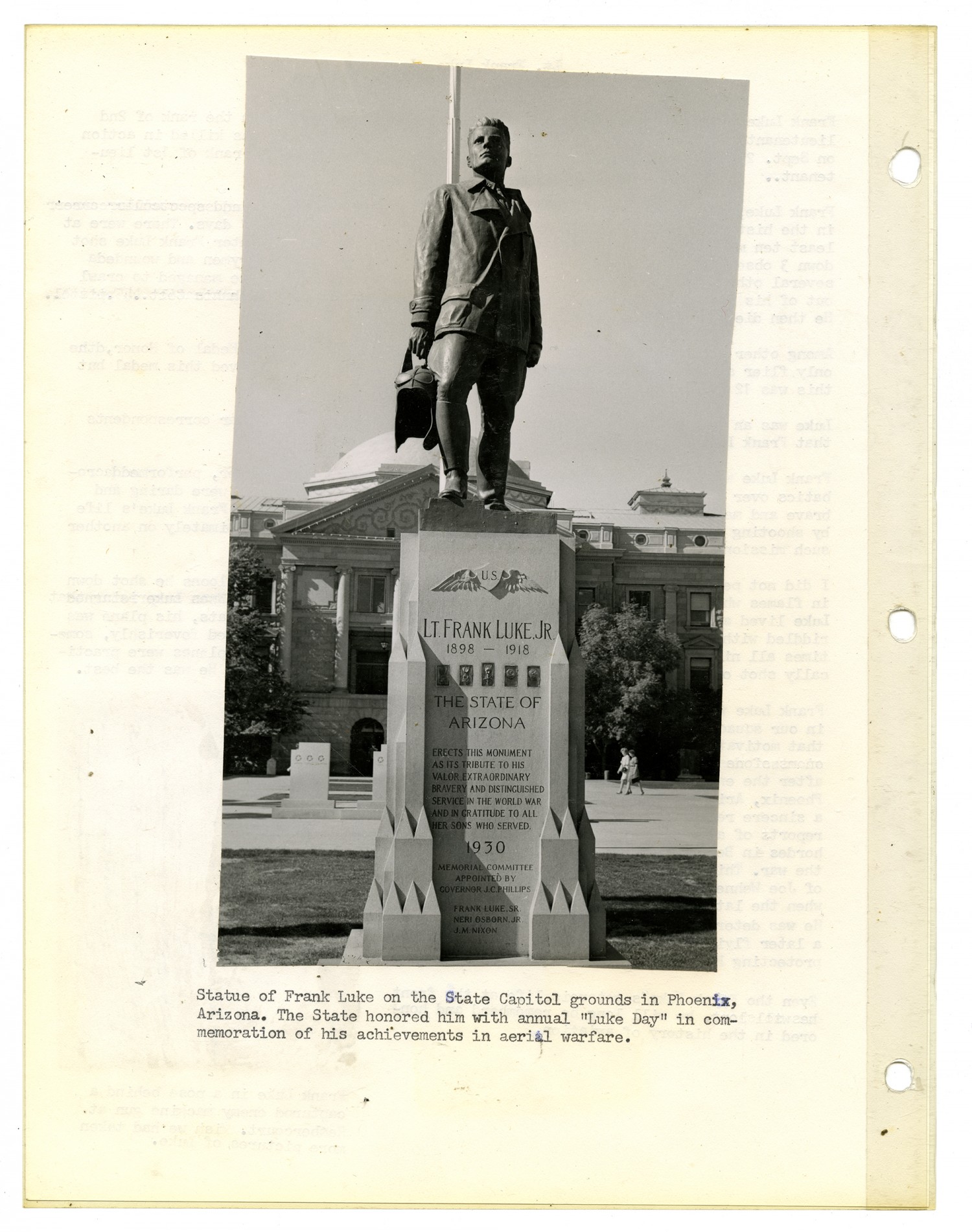
Transcript
[Photograph] Statue of Frank Luke on the State Capitol grounds in Phoenix, Arizona. The State honored him with annual

Transcript

Transcript
[Map] THE SAGA OF

Transcript
By Tex Branshaw BILLETS. I
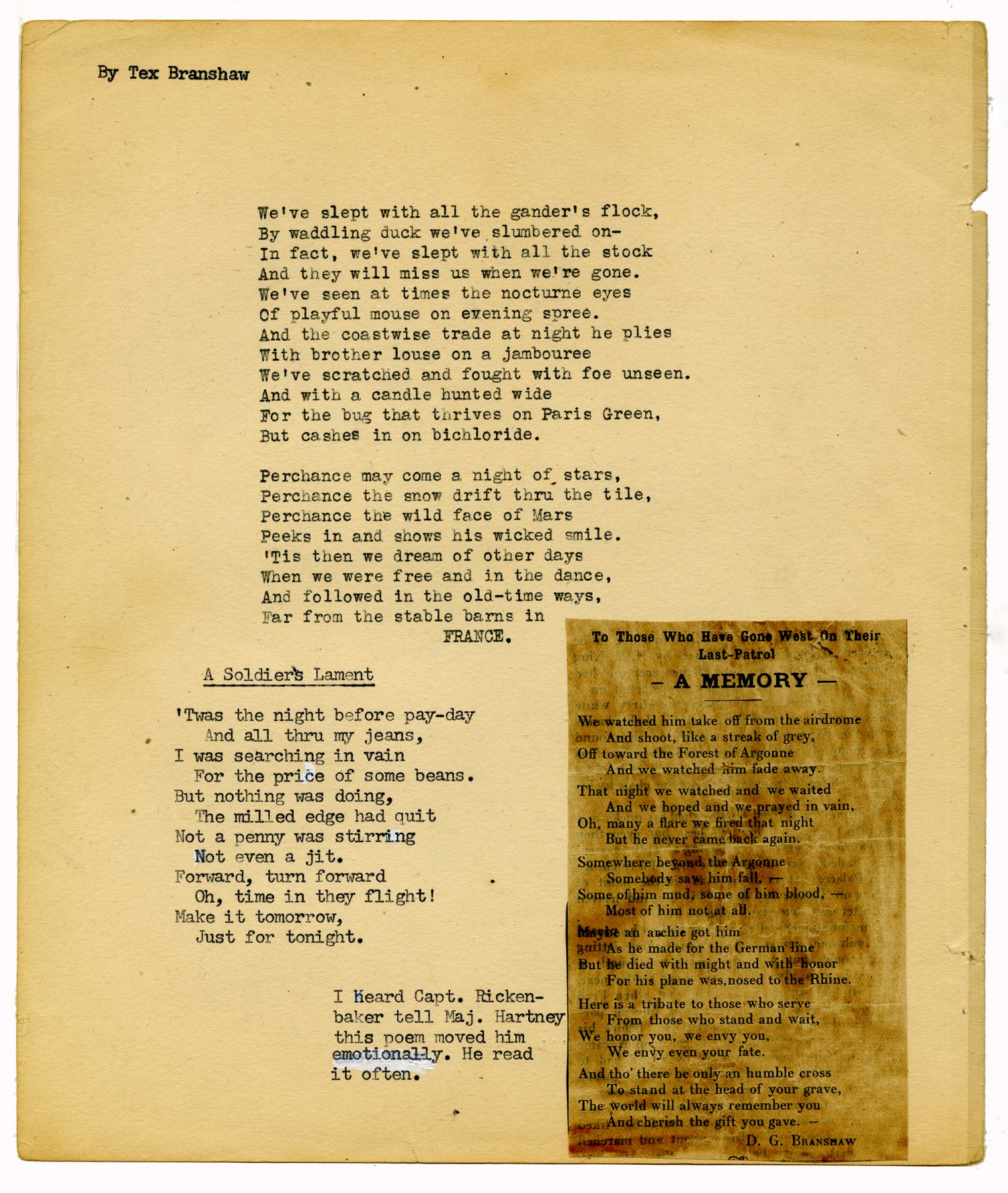
Transcript
By Tex Branshaw We
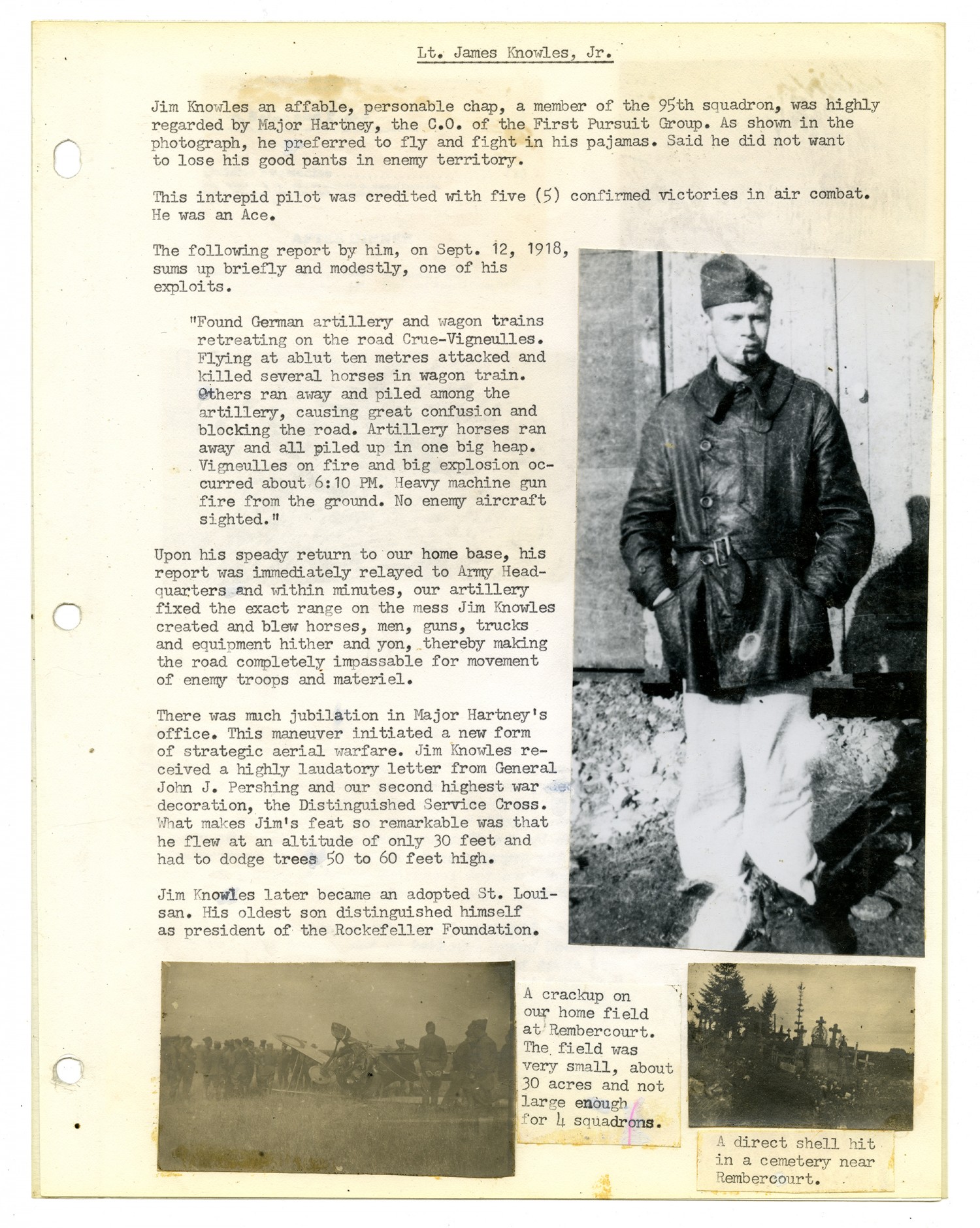
Transcript
Lt. James Knowles, Jr. Jim Knowles an affable, personable chap, a member of the 95th squadron, was highly regarded by Major Hartney, the C.O. of the First Pursuit Group. As shown in the photograph, he preferred to fly and fight in his pajamas. Said he did not want to lose his good pants in enemy territory. This intrepid pilot was credited with five (5) confirmed victories in air combat. He was an Ace. The following report by him, on [September] 12, 1918, sums up briefly and modestly, one of his exploits.
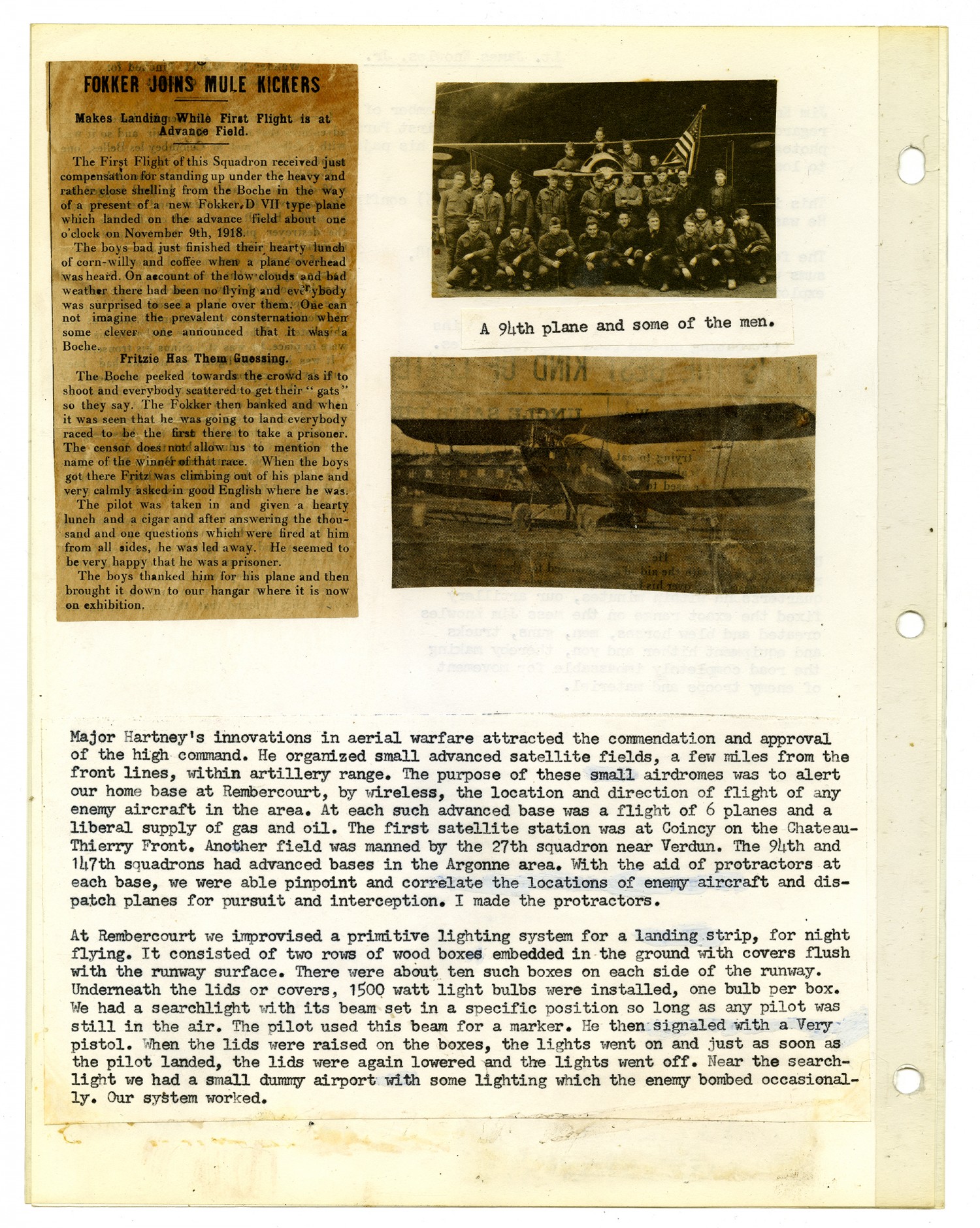
Transcript
[Top right photograph] A 94th plane and some of the men. Major Hartney
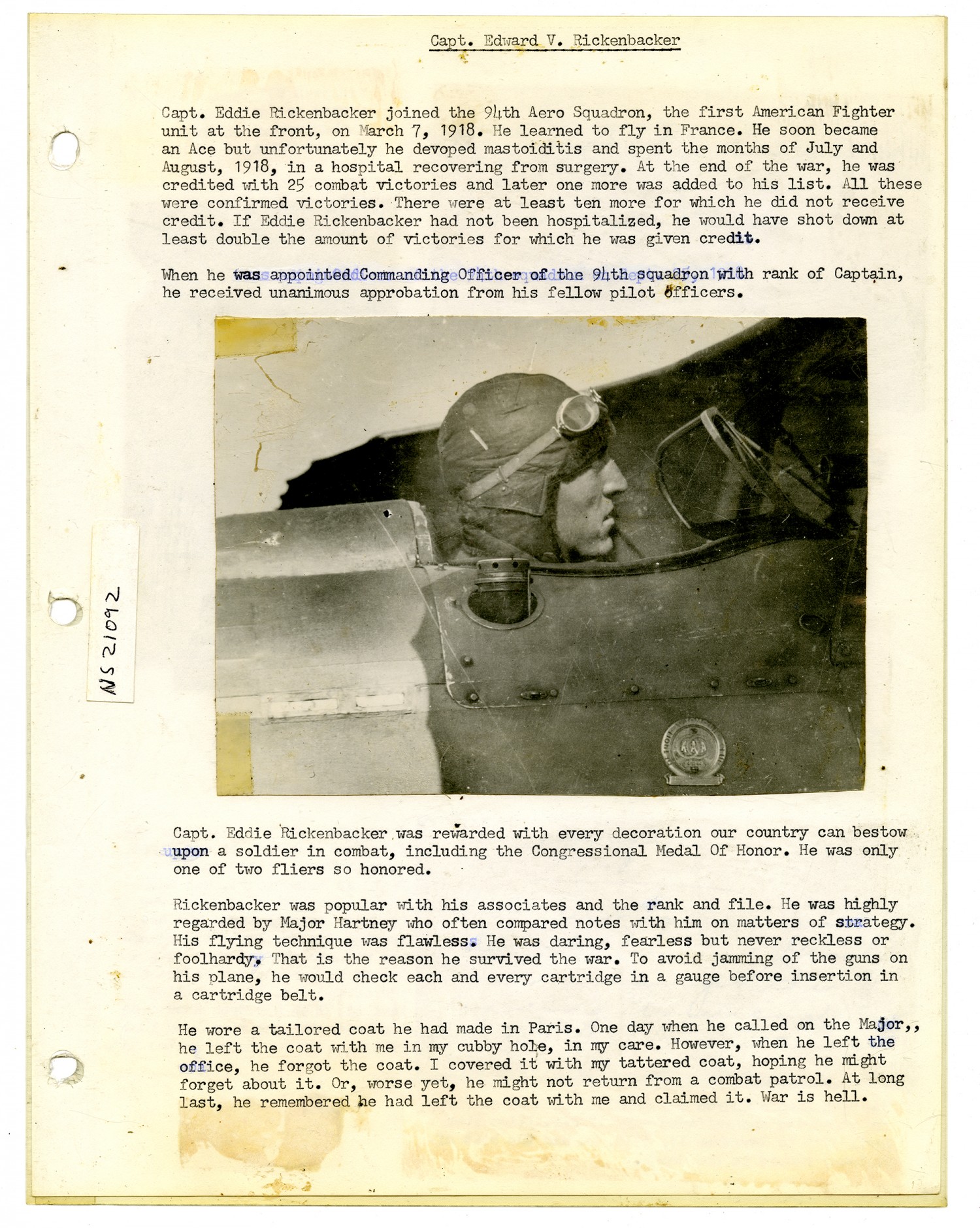
Transcript
Capt. Edward V. Rickenbacker Capt. Eddie Rickenbacker joined the 94th Aero Squadron, the first American Fighter unit at the front, on March 7, 1918. He learned to fly in France. He soon became an Ace but unfortunately he devoped mastoiditis and spent the months of July and August, 1918, in a hospital recovering from surgery. At the end of the war, he was credited with 25 combat victories and later one more was added to his list. All these were confirmed victories. There were at least ten more for which he did not receive credit. If Eddie Rickenbacker had not been hospitalized, he would have shot down at least double the amount of victories for which he was given credit. When he was appointed Commanding Officer of the 94th squadron with rank of Captain, he received unanimous approbation from him fellow pilot officers. NS21092 Capt. Eddie Rickenbacker was rewarded with every decoration our country can bestow upon a soldier in combat, including the Congressional Medal of Honor. He was only one of two fliers so honored. Rickenbacker was popular with his associates and the rank and file. He was highly regarded by Major Hartney who often compared notes with him on matters of strategy. His flying technique was flawless. He was daring, fearless but never reckless or foolhardy. That is the reason he survived the war. To avoid jamming of the guns on his plane, he would check each and every cartridge in a gauge before insertion in a cartridge belt. He wore a tailored coat he had made in Paris. One day when he called on the Major,, he left the coat with me in my cubby hole, in my care. However, when he left the office, he forgot the coat. I covered it with my tattered coat, hoping he might forget about it. Or, worse yet, he might not return for a combat patrol. At long last, he remembered he had left the coat with me and claimed it. War is hell.
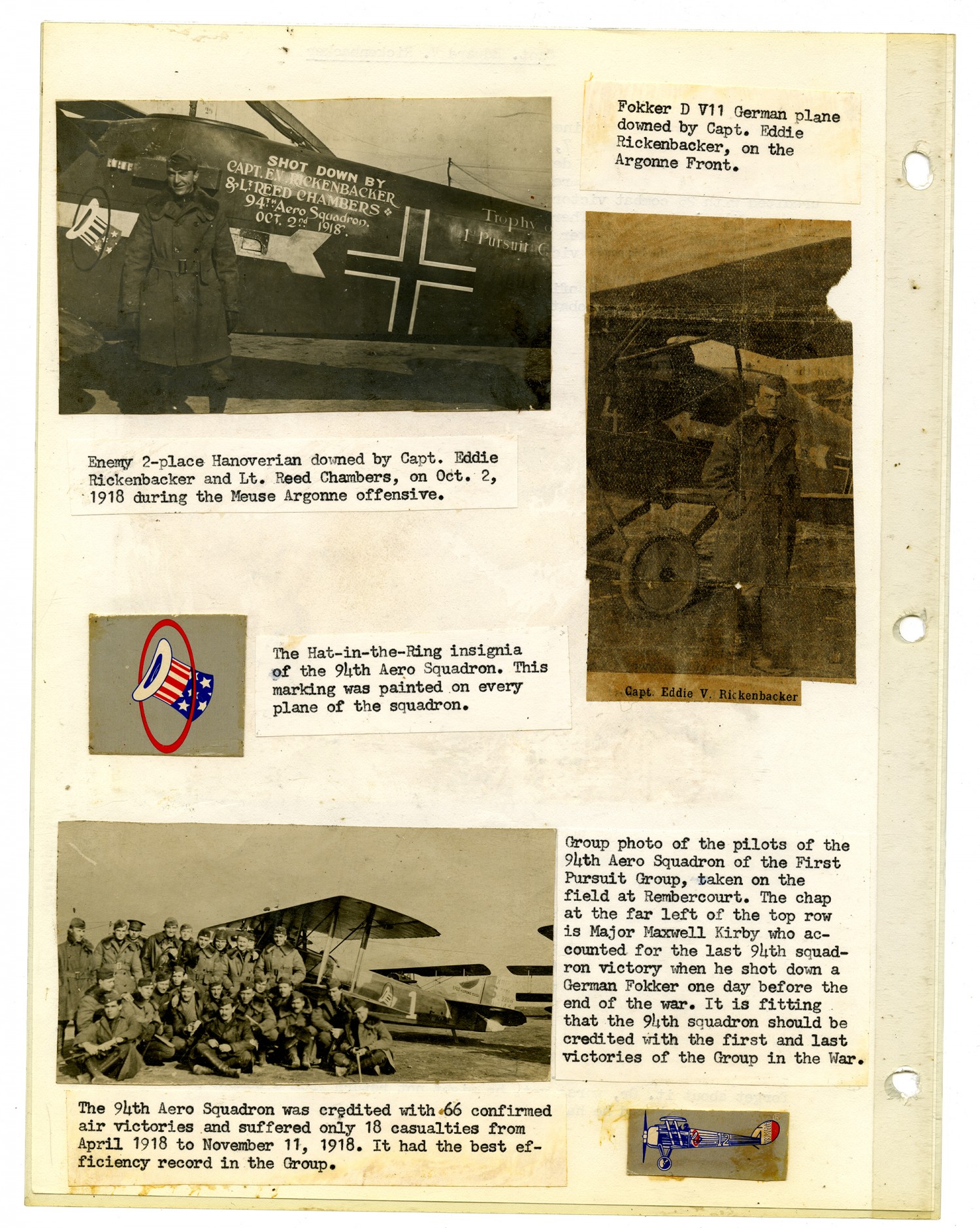
Transcript
[1st row left photograph] Fokker D V11 German plane downed by Capt. Eddie Rickenbacker, on the Argonne Front. [2nd row right photograph] Enemy 2-place Hanoverian downed by Capt. Eddie Rickenbacker and Lt. Reed Chambers, on [October] 2, 1918 during the Meuse Argonne offensive. [2nd row left image] The Hat-in-the-Ring insignia of the 94th Aero Squadron. This marking was painted on every plane of the squadron. [3rd row left photograph] Group photo of the pilots of the 94th Aero Squadron of the First Pursuit Group, taken on the field at Rembercourt. The chap at the far left of the top row is Major Maxwell Kirby who accounted for the last 94th squadron victory when he shot down a German Fokker one day before the end of the war. It is fitting that the 94th squadron should be credited with the first and last victories of the Group in the War. [4th row right image] The 94th Aero Squadron was credited with 66 confirmed air victories and suffered only 18 casualties from April 1918 to November 11, 1918. It had the best efficiency record in the Group.
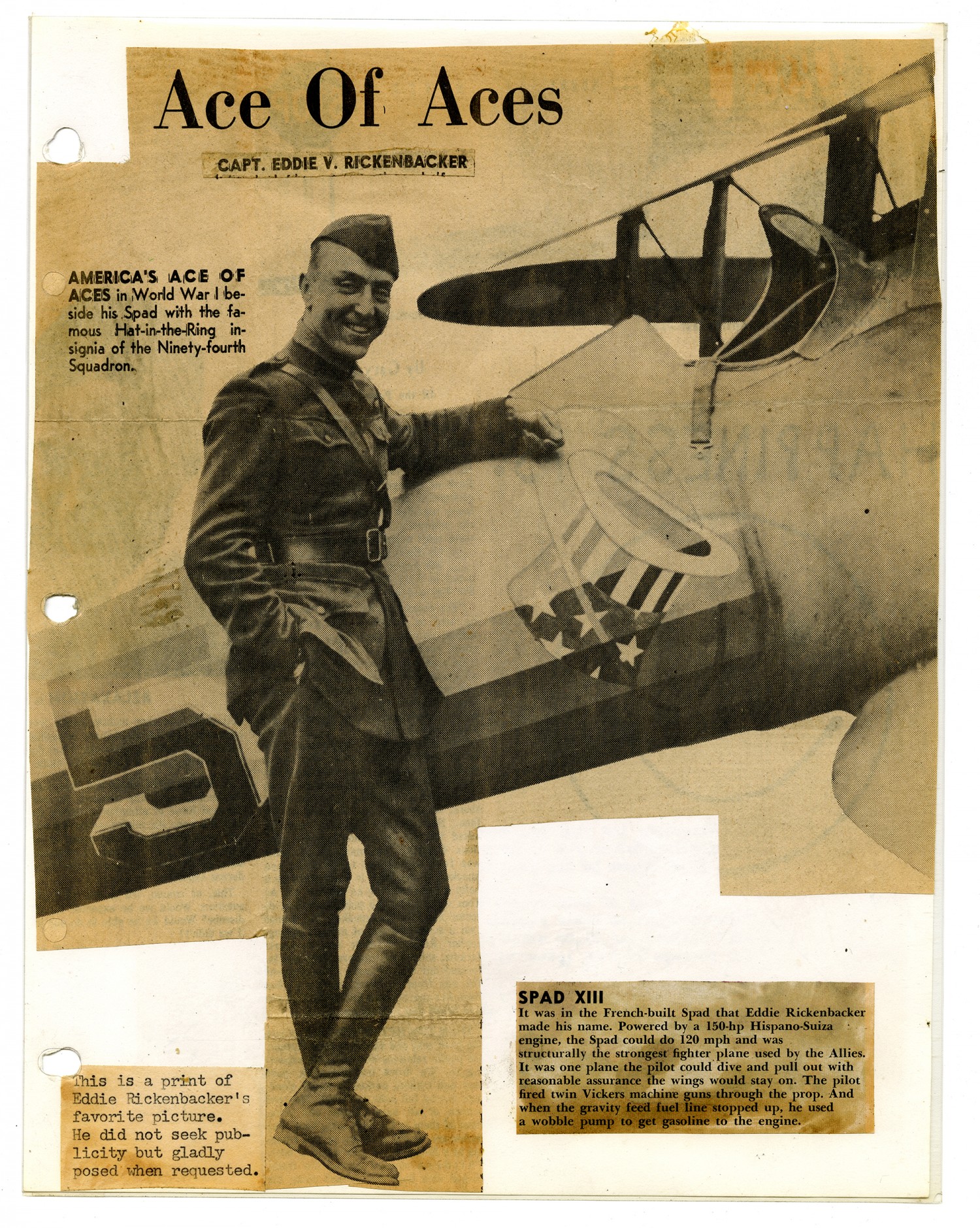
Transcript
[Newspaper clipping] Ace Of Aces CAPT. EDDIE V. RICKENBACKER This is a print of Eddie Rickenbacker
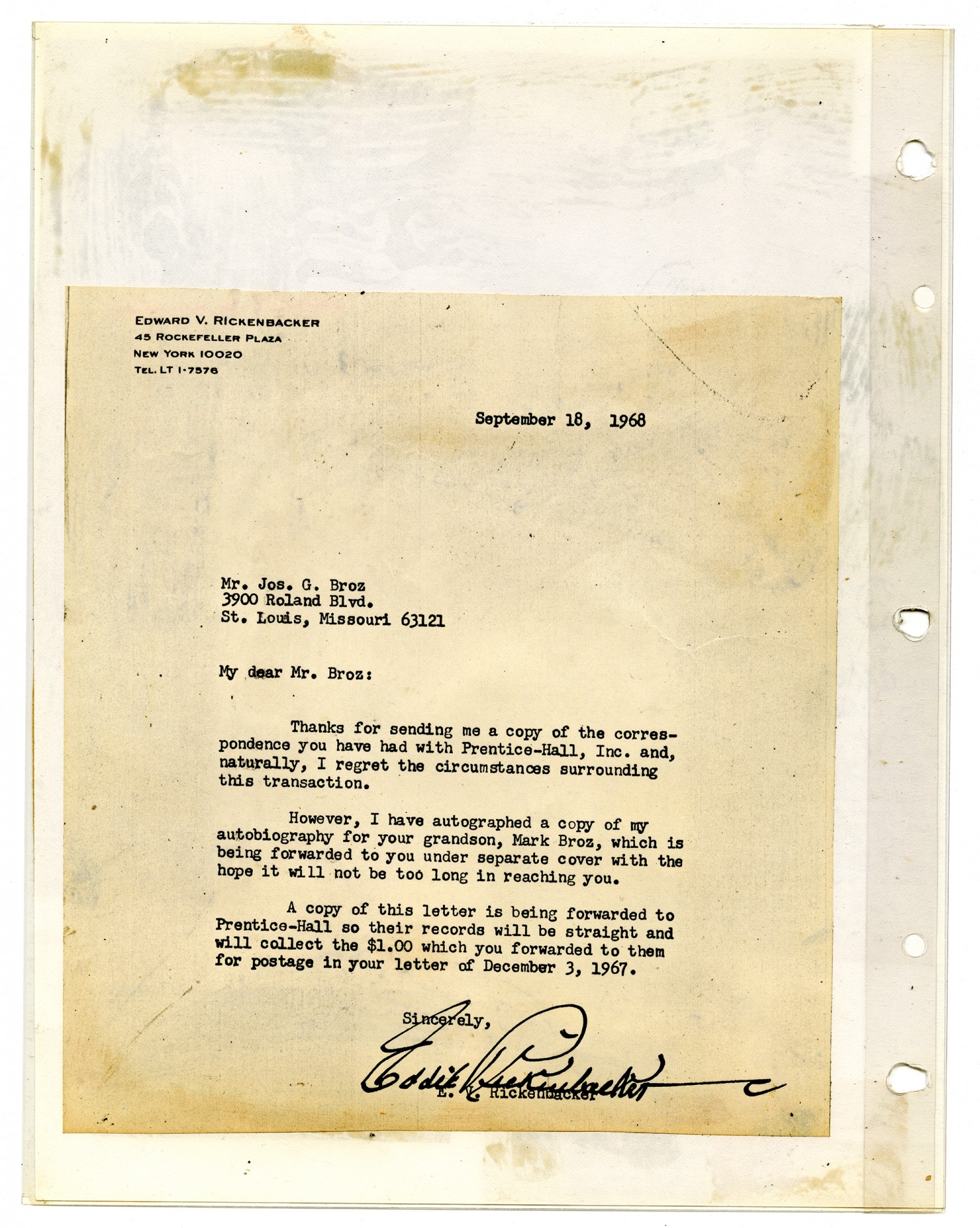
Transcript
[Edward V. Rickenbacker letterhead] September 18, 1968 Mr. Jos. G. Broz 3900 Roland Blvd. St. Louis, Missouri 63121 My dear Mr. Broz: Thanks for sending me a copy of the correspondence you have had with Prentice-Hall, Inc. and, naturally, I regret the circumstances surrounding this transaction. However, I have autographed a copy of my autobiography for your grandson, Mark Broz, which is being forwarded to you under separate cover with the hope it will not be too long in reaching you. A copy of this letter is being forwarded to Prentice-Hall so their records will be straight and will collect the $1.00 which you forwarded to them for postage in your letter of December 3, 1967. Sincerely, Eddie Rickenbacker E.V. Rickenbacker
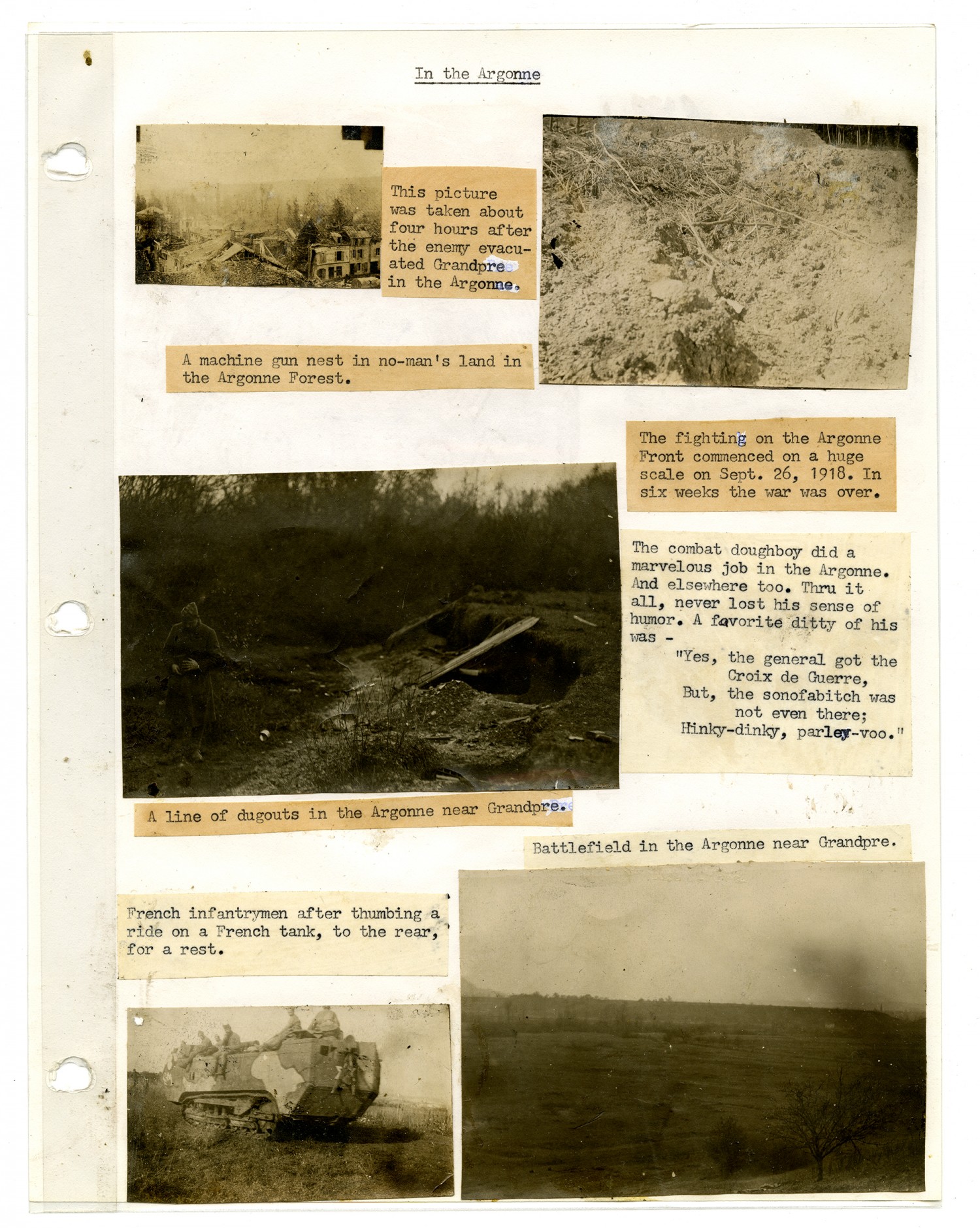
Transcript
In the Argonne [1st row left photograph] This picture was taken about four hours after the enemy evacuated Grandpre in the Argonne. [1st row right photograph] A machine gun nest in no-man
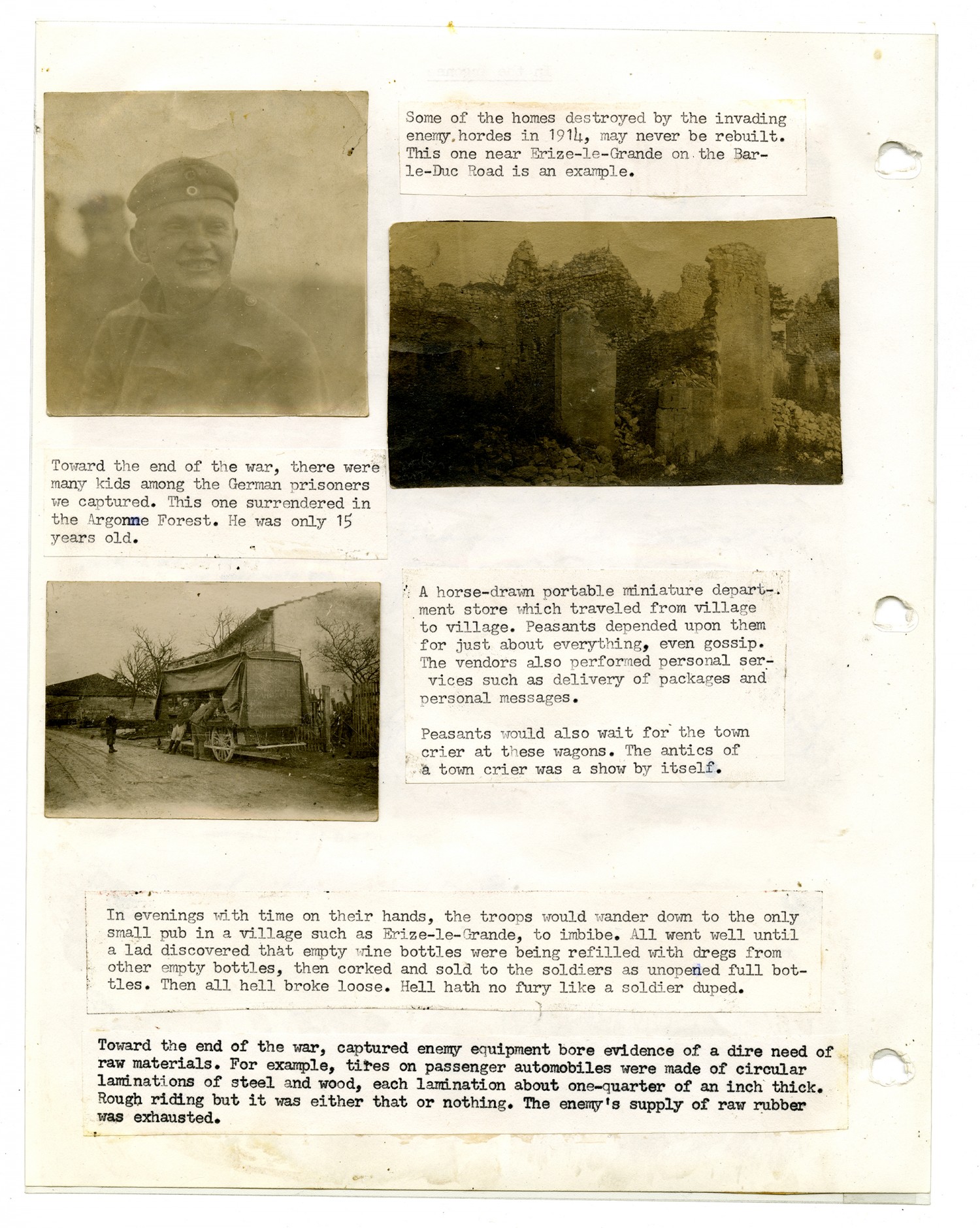
Transcript
[Top left photograph] Toward the end of the war, there were many kids among the German prisoners we captured. This one surrendered in the Argonne Forest. He was only 15 years old. [Top right photograph] Some of the homes destroyed by the invading enemy hordes in 1914, may never be rebuilt. This one near Erize-le-Grande on the Bar-le-Duc Road is an example. [Bottom left photograph] A horse-drawn portable miniature department store which traveled from village to village. Peasants depended upon them for just about everything, even gossip. The vendors also performed personal services such as delivery of packages and personal messages. Peasants would also wait for the town crier at these wagons. The antics of a town crier was a show by itself. In evenings with time on their hands, the troops would wander down to the only small pub in a village such as Erize-le-Grande, to imbibe. All went well until a lad discovered that empty wine bottles were being refilled with dregs from other empty bottles, then corked and sold to the soldiers as unopened full bottles. Then all hell broke loose. Hell hath no fury like a soldier duped. Toward the end of the war, captured enemy equipment bore evidence of a dire need of raw materials. For example, tires on passenger automobiles were made of circular laminations of steel and wood, each lamination about one-quarter of an inch thick. Rough riding but it was either that or nothing. The enemy
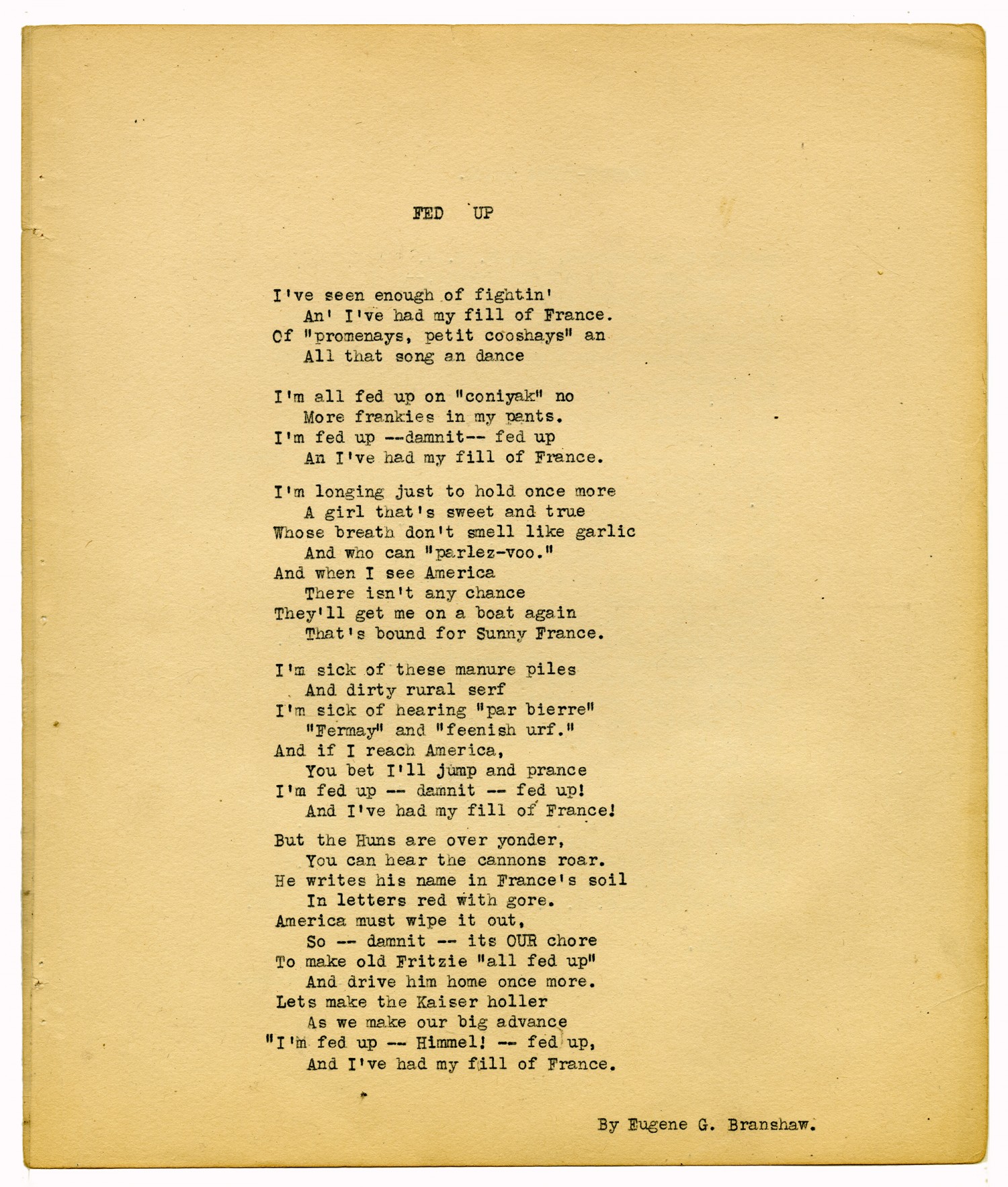
Transcript
FED UP I

Transcript
TWENTY-THIRD SPASM. The

Transcript
Bathing While in camps in the States bathing was no problem. We had excellent shower facilities where we were quartered. The only exception was Kelly Field in the initial stage. Here we had a lively artesian well which we used overtime. We found good bathing facilities in Canada and England. All this changed when we crossed the English Channel and plunged into France. However, conveniences at Tours and Issoudon were acceptable. When we were based at Remebercourt, on the St. Mihiel Front, we managed somehow to catch a ride on a supply truck headed for Bar-le-Duc, for a bath at Bains-Douches de la Caisse d

Transcript
Delousing Occasionally but not often enough, the troops welcomed and reveled in the luxury of a delousing mill to rid themselves of body vermin and cooties in their clothes. Clothing had to steamed to exterminate the cooties. Cooties are body lice, parasitic insects, which made life miserable and nights sleepless. Shoes and any other object made of leather had to be carefully removed from the steam process to avoid shringage. But, a few days later, cooties were back in our clothes again cavorting ignominiously. [Top right photograph] This is a view of the 1st Air Depot at Colombes-les-Belles. The delousing mill is the structure showing escaping steam, in the center of the picture. This camp served as a supply depot during the war. Afterward it was used as a facility for grouping troops homeward bound. The camp was in charge of Sgt. Murphy, a former police officer in Chicago. His nose was rose colored from alcohol. At the end of the war, Russian prisoners who were liberated from German prison camps, hung around our mess-hall kitchens begging for food and picking over garbage. They wrapped sacks around their feet for foot wear. They scrambled for clothing discarded by American soldiers at the delousing mill. We could not help feeling sorry for the Russians. Laundry Washing clothes was always a problem. When we could not manage ourselves, we looked for a widow woman in a nearby village, to do our laundry. In many cases, the house she lived in was partially destroyed by war. This was just about her only source of income. Sometimes these women would cook a meal for us, with food we brought to them from our own supplies. They were well paid for their efforts and kindness.
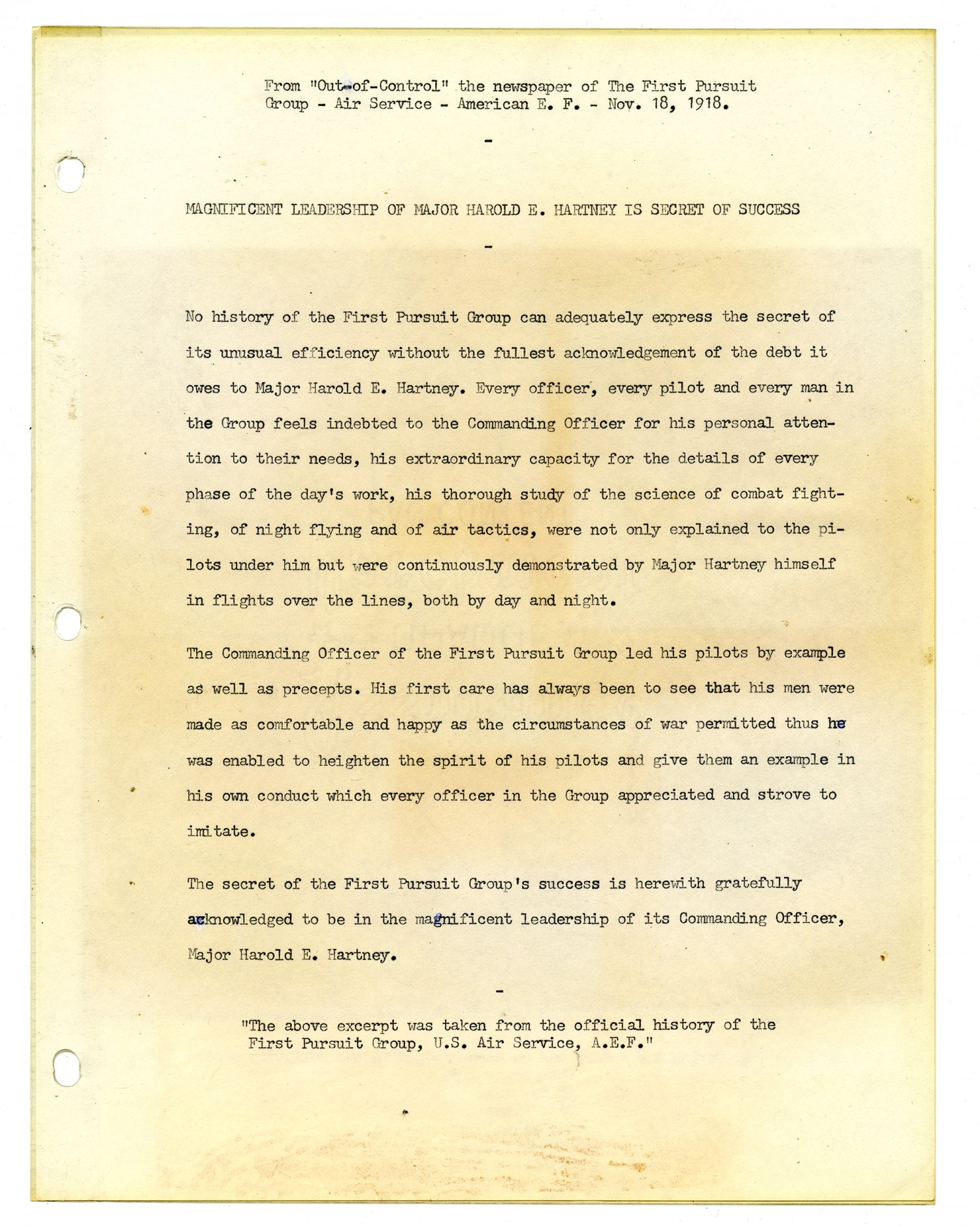
Transcript
From
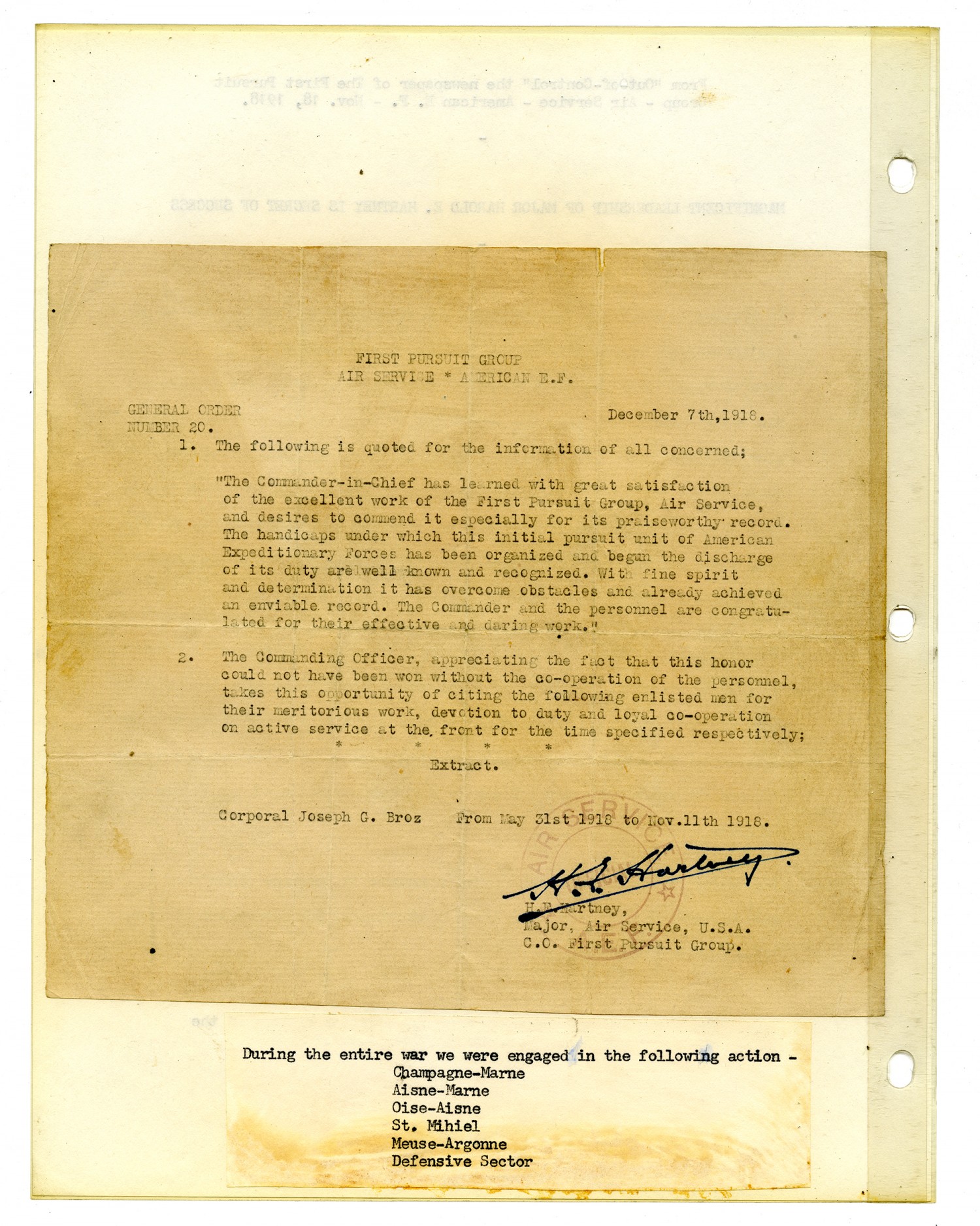
Transcript
FIRST PURSUIT GROUP AIR SERVICE *AMERICAN E.F. GENERAL ORDER NUMBER 20. December 7th, 1918. 1. The following is quoted for the information of all concerned;
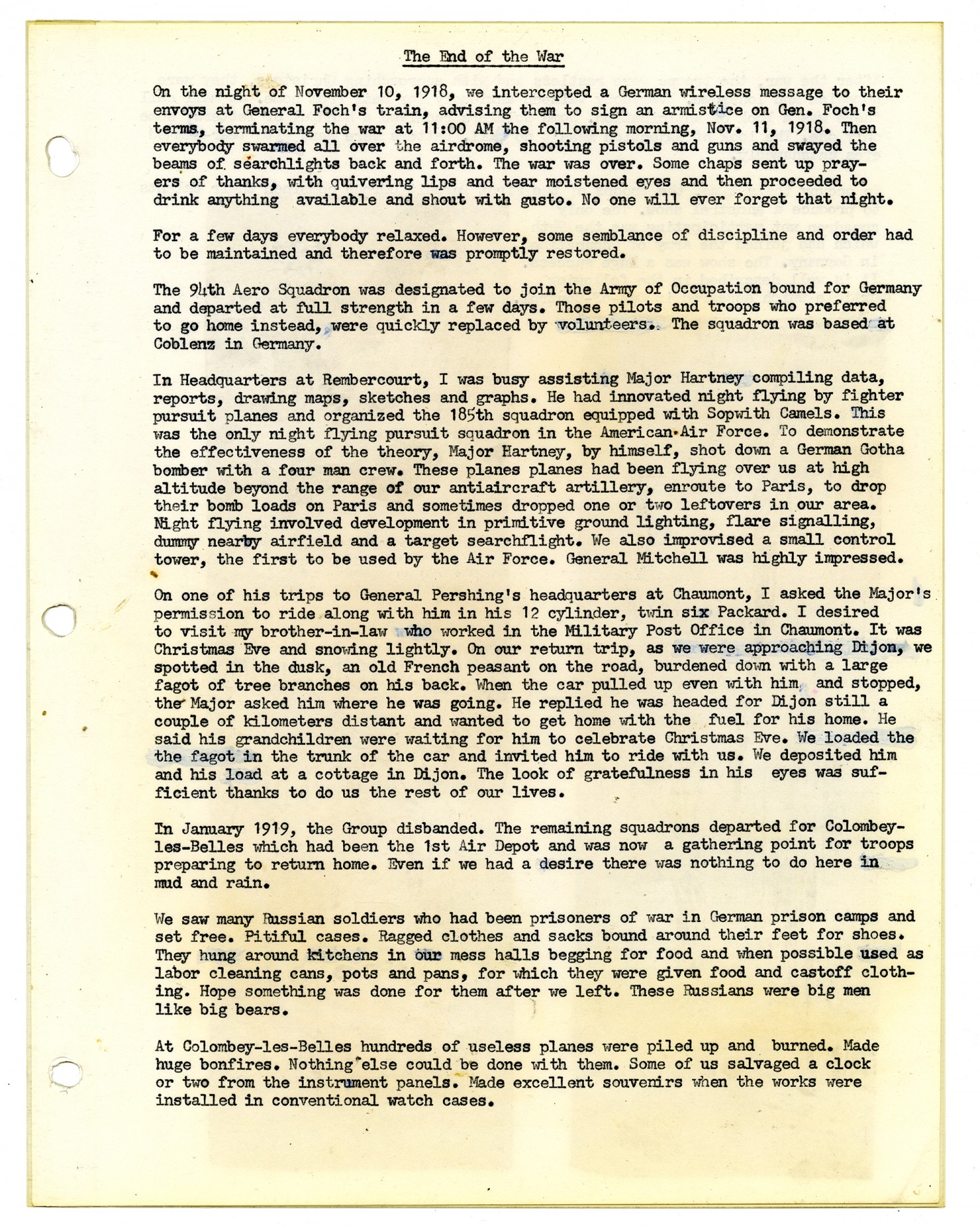
Transcript
The End of the War On the night of November 10, 1918, we intercepted a German wireless message to their envoys at General Foch
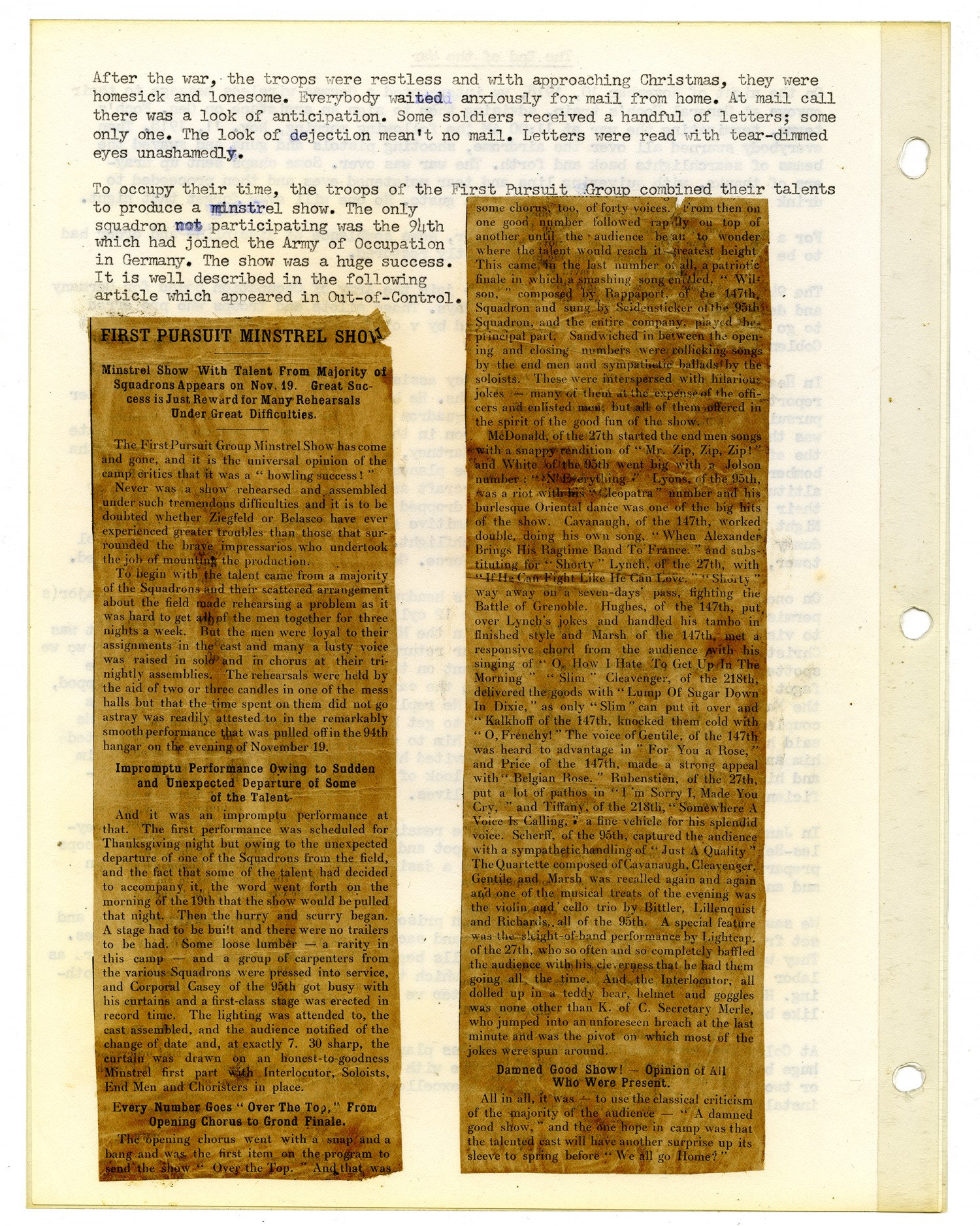
Transcript
After the war, the troops were restless and with approaching Christmas, they were homesick and lonesome. Everybody waited anxiously for mail from home. At mail call there was a look of anticipation. Some soldiers received a handful of letters; some only one. The look of dejection mean

Transcript
Hospitalization While at Colombey-les-Belles preparing for departure home, the camp was stricken with acute influenza. I was one of the unfortunates. The troops afflicted were taken by ambulance to nearby Camp Hospital No. 6, near Baricey-la-Cote and in no time, the various wards were filled to capacity with victims. The hospital consisted of several portable barracks. They were poorly assembled and wind blew snow thru cracks in the ill-fitted walls. The beds in the ward I was in, were isolated, one from the other with hanging bedsheets. Quite a few men developed pneumonia and died. Felt sorry for them. I dreaded to hear the tramping of the heavy boots of the stretcher bearers. Wondered who might be next. The nurses in this ward performed nobly. They did their best for us. Apparently, there was no prescribed medication and treatment for the cure of influenza at this time. So
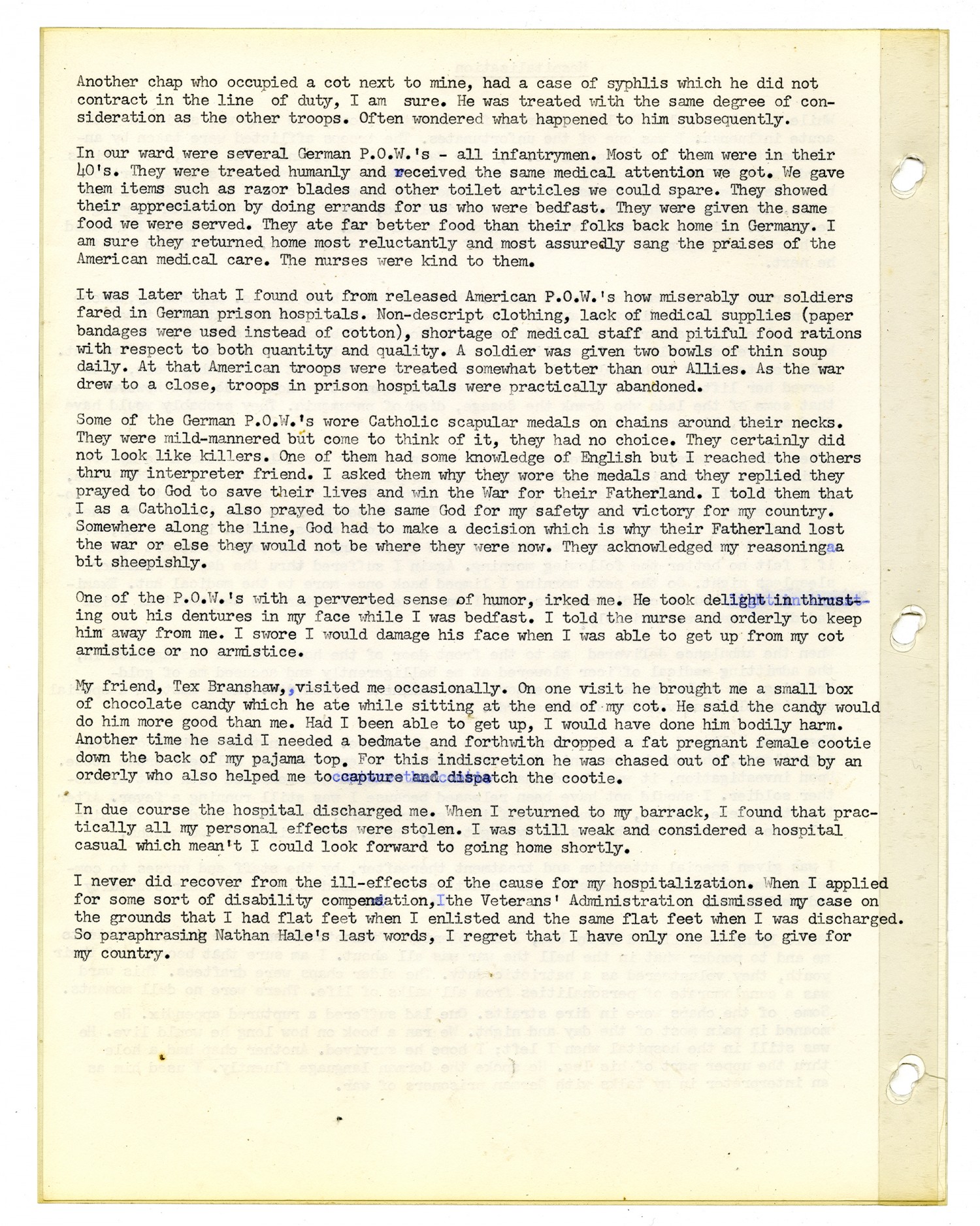
Transcript
Another chap who occupied a cot next to mine, had a case of syphlis which he did not contract in the line of duty, I am sure. He was treated with the same degree of consideration as the other troops. Often wondered what happened to him subsequently. In our ward were several German P.O.W.

Transcript
[Newspaper clippings] A tribute to Major Harold E. Hartney in Out-Of-Control. Everybody thought highly of him. He was particularly thoughtful of my welfare. In turn, I would have done anything for him.
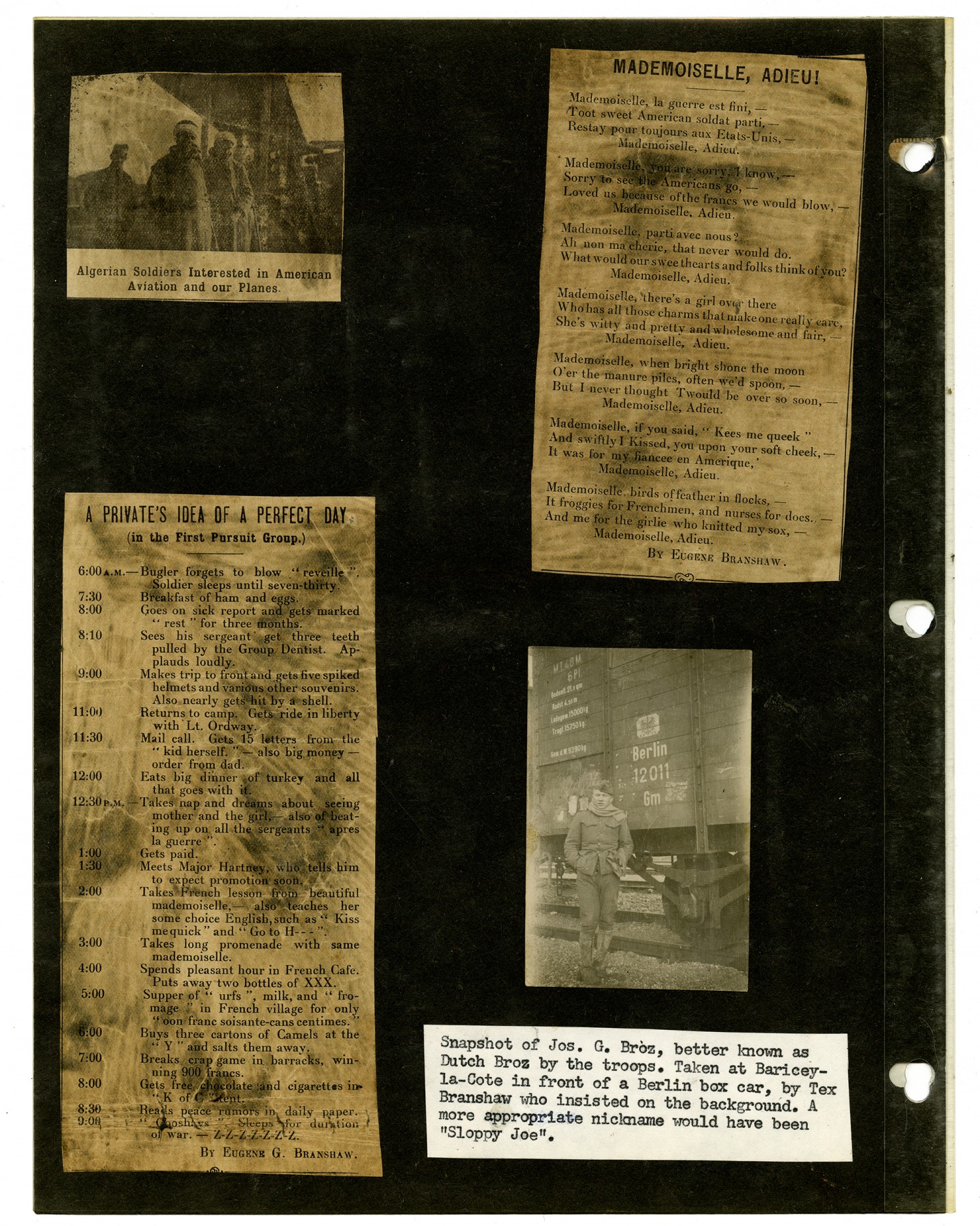
Transcript
[Newspaper clippings] Snapshot of Jos. G. Broz, better known as Dutch Broz by the troops. Taken at Baricey-la-Cote in front of a Berlin box car, by Tex Branshaw who insisted on the background. A more appropriate nickname would have been
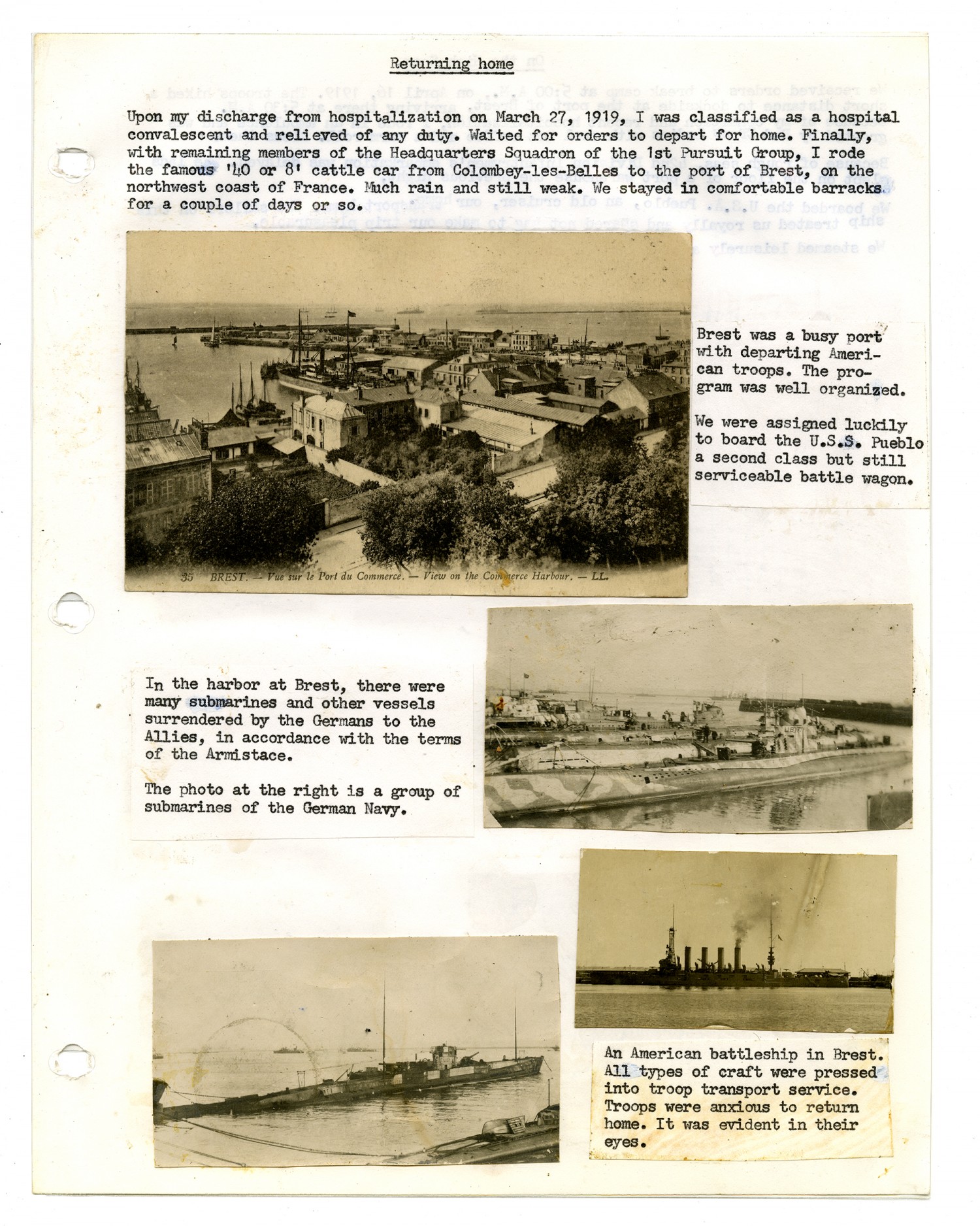
Transcript
Returning home Upon my discharge from hospitalization on March 27, 1919, I was classified as a hospital convalescent and relieved of any duty. Waited for orders to depart for home. Finally, with remaining members of the Headquarters Squadron of the 1st Pursuit Group, I rode the famous
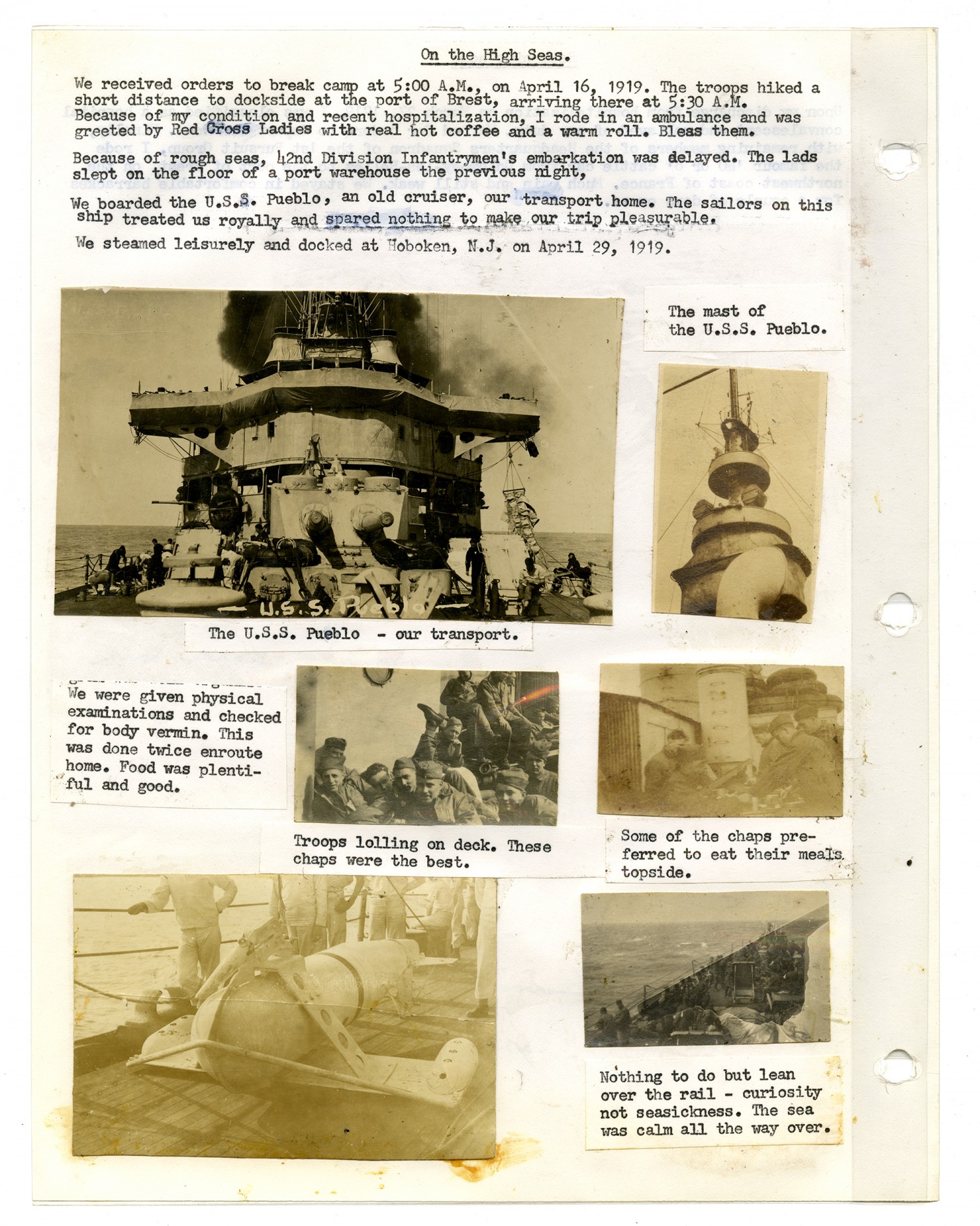
Transcript
On the High Seas. We received orders to break camp at 5:00 A.M., on April 16, 1919. The troops hiked a short distance to dockside at the port of Brest, arriving there at 5:30 A.M. Because of my condition and recent hospitalization, I rode in an ambulance and was greeted by Red Cross Ladies with real hot coffee and a warm roll. Bless them. Because of rough seas, 42nd Division Infantrymen

Transcript
THE END The thrill of my life was my first sight of the Statue of Liberty in New York Harbor. After docking at Hoboken, New Jersey, on April 29, 1919, I was transferred to the Army cantonment at Hempstead, Long Island, New York, for the separation routine from the Air Force. At that time it was known as the Air Service
Details
| Title | Joseph Broz U.S. Air Force WWI Scrapbook - December 25, 1979 |
| Creator | Broz, Joseph G. |
| Source | Broz, Joseph G., U.S. Air Force WWI Scrapbook. 25 December 1979. Joe Broz Album: World War I. P0161. Missouri History Museum, St. Louis, Missouri. |
| Description | Joseph G. Broz served as a Corporal in the United States Air Force during World War I. He was originally a member of the 27th Aero Squadron, Company K and later served as an engineering aid of the 1st Pursuit Group. He was inducted at Jefferson Barracks in St. Louis, Missouri on April 29, 1917. This scrapbook of text and photographs documents Jos Broz's experience as a soldier serving in WWI, both within the United States, England and France. |
| Site Accession Number | P0161 |
| Contributing Institution | Missouri History Museum |
| Copy Request | Transmission or reproduction of items on these pages beyond those allowed by fair use requires the written permission of the Missouri History Museum: 314-746-4510 |
| Rights | The text and images contained in this collection are intended for research and educational use only. Duplication of any of these images for commercial use without express written consent is expressly prohibited. Contact the Missouri History Museum's Permissions Office at 314-746-4511 to obtain written consent. |
| Date Original | December 25, 1979 |
| Language | English |
